Aviation in Early Los Angeles
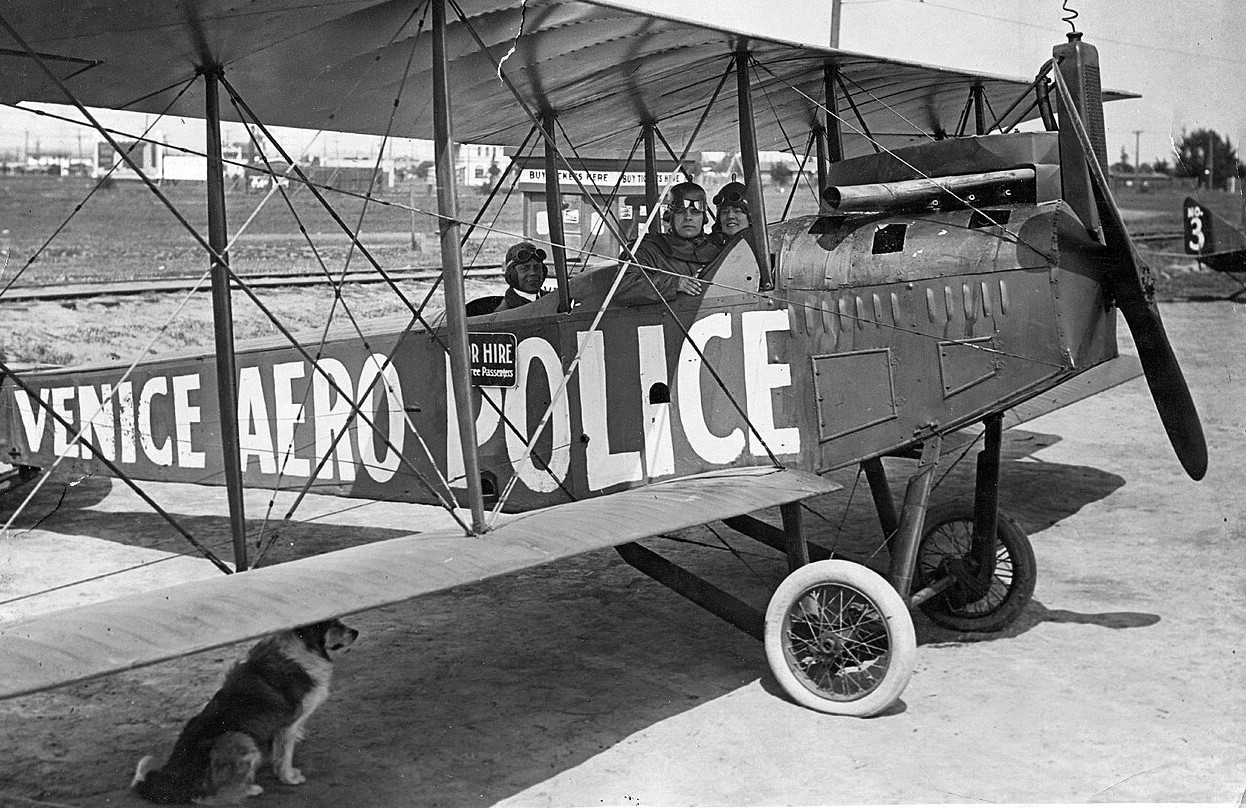 |
|
| (1919)* – A view of a four-seat biplane with Venice Aero Police markings at Ince Airfield in Venice, California. Otto “Swede” Meyerhofer is at the controls, with two passengers onboard. Note the dog under the wing. Photo courtesy of the San Diego Air and Space Museum via Wikipedia. |
Historical Notes On April 3, 1919, Venice, California, launched the first aerial police force in the United States by inducting aviator Otto Meyerhofer. His 100 MPH biplane prominently displayed the words "Venice Aero Police" on its side. Meyerhofer's primary duties included tracking fleeing automobile bandits and locating boats in distress from the air, allowing for quick and efficient responses. Initially known as Ince Field, the airport was established in the early 1900s by Thomas Ince as a base for stunt pilots and movie work. It was renamed Delay Field in 1920 after aviator B.H. DeLay took over its operations. The airport closed in 1923 due to its short runway and lack of expansion space, being surrounded by residential neighborhoods. Larger airports nearby, such as Santa Monica's Clover Field and Los Angeles' Mines Field (now LAX), met the region’s aviation needs. Later that year, the land where Delay Field once stood was subdivided. The Venice Aero Police initiative was revolutionary, marking one of the first instances of aerial law enforcement worldwide. Although the program was short-lived, it set a precedent for the use of aircraft in policing. Today, modern law enforcement agencies globally use helicopters and other aircraft for surveillance, search and rescue, and rapid response, building on the legacy of early efforts like those in Venice. Note: The City of Venice was annexed by the City of Los Angeles on February 23, 1925. |
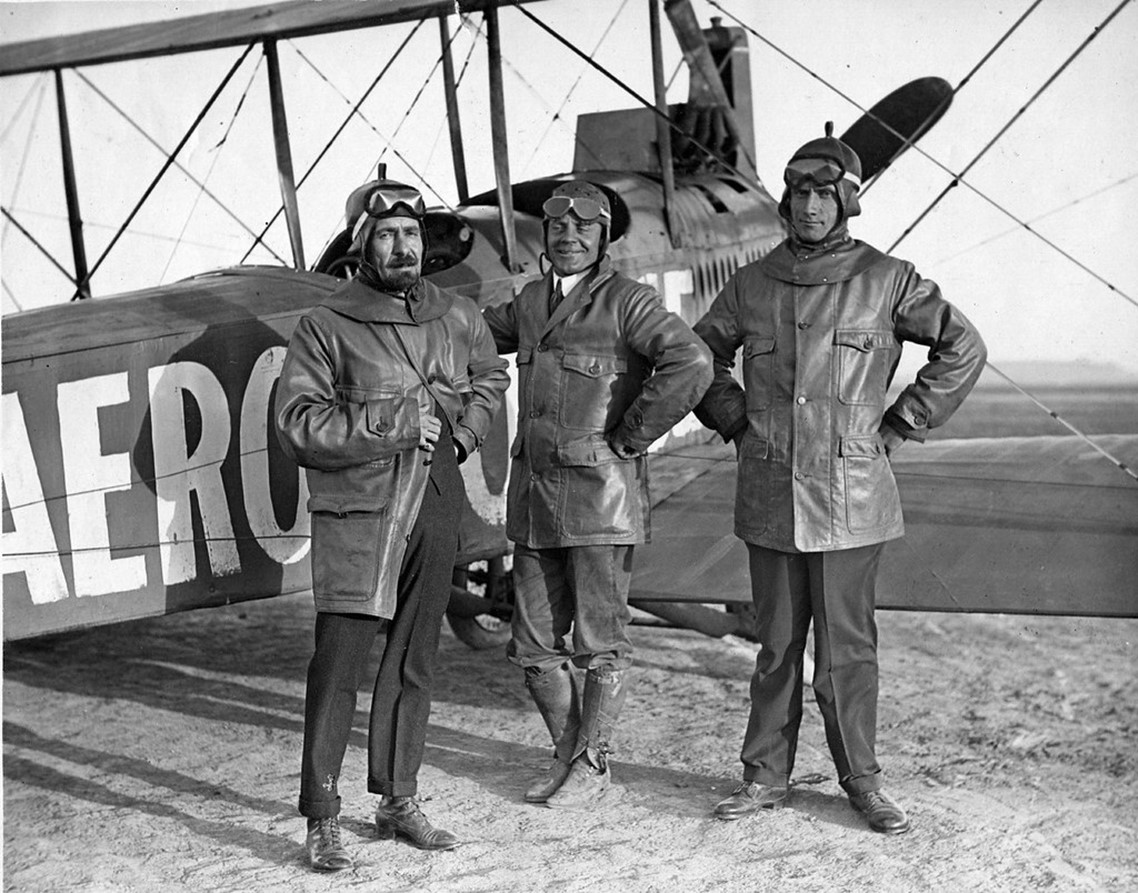 |
|
| (1919)* - Venice Aero Police with Deputy Meyerhofer in the middle. Photo courtesy of the San Diego Air and Space Museum |
Historical Notes Otto "Swede" Meyerhofer, a pioneering figure in early aviation law enforcement, was the first member of Venice, California's Aero Police, established in 1919. Sworn in on April 3, 1919, Meyerhofer's duties included chasing speeders, investigating smuggling, enforcing fishing regulations, and assisting in rescues. He piloted an 8-cylinder biplane marked "VENICE AERO POLICE," based at Ince Field, and though the unit served as a publicity tool for Venice, its effectiveness was limited by a lack of radio communication. Despite expansion to three more pilots by 1922, the Aero Police ended in 1923 when the airfield was sold and Venice was incorporated into Los Angeles in 1925. While it captured public imagination, its impact on crime-fighting was minimal, and Meyerhofer tragically died after being injured by a plane propeller. |
* * * * * |
Charles Lindbergh
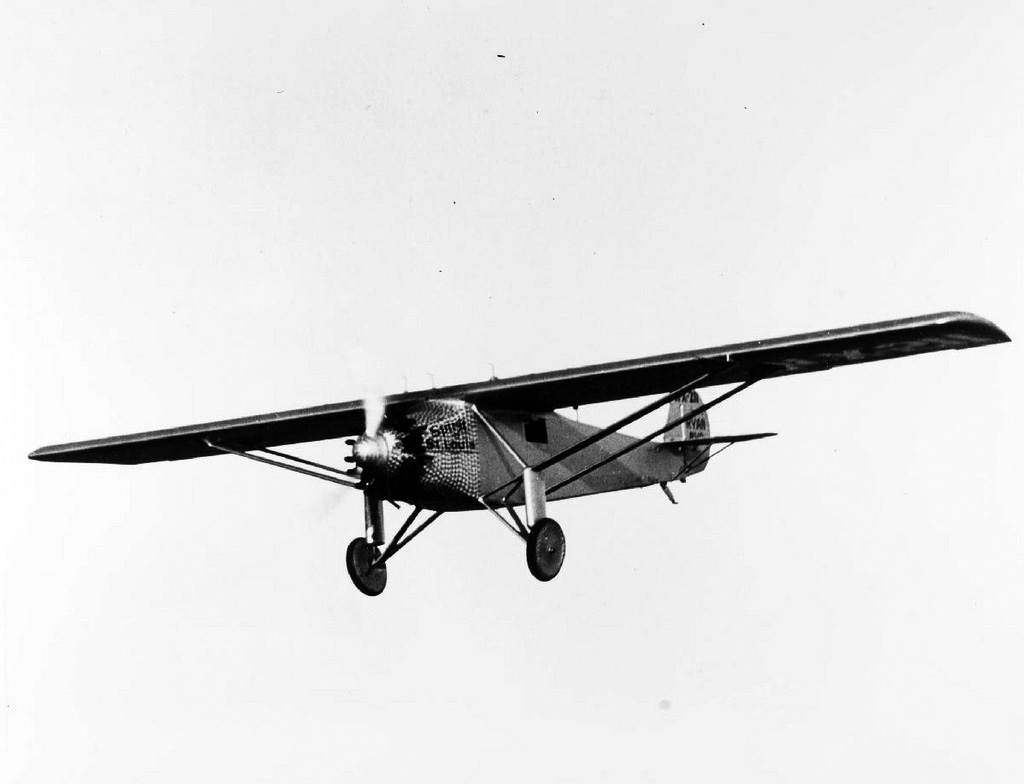 |
|
| (1927)* - Charles Lindbergh flying the Spirit of St. Louis on his tour of the U.S., September 1927. |
Historical Notes CIn 1927, Charles Lindbergh landed The Spirit of St. Louis at the Vail Field while on a nationwide tour following his transatlantic flight (May 21, 1927). The Spirit of St. Louis was powered by a Wright Whirlwind J-5C 223-hp radial engine, and had a 46-foot wingspan. |
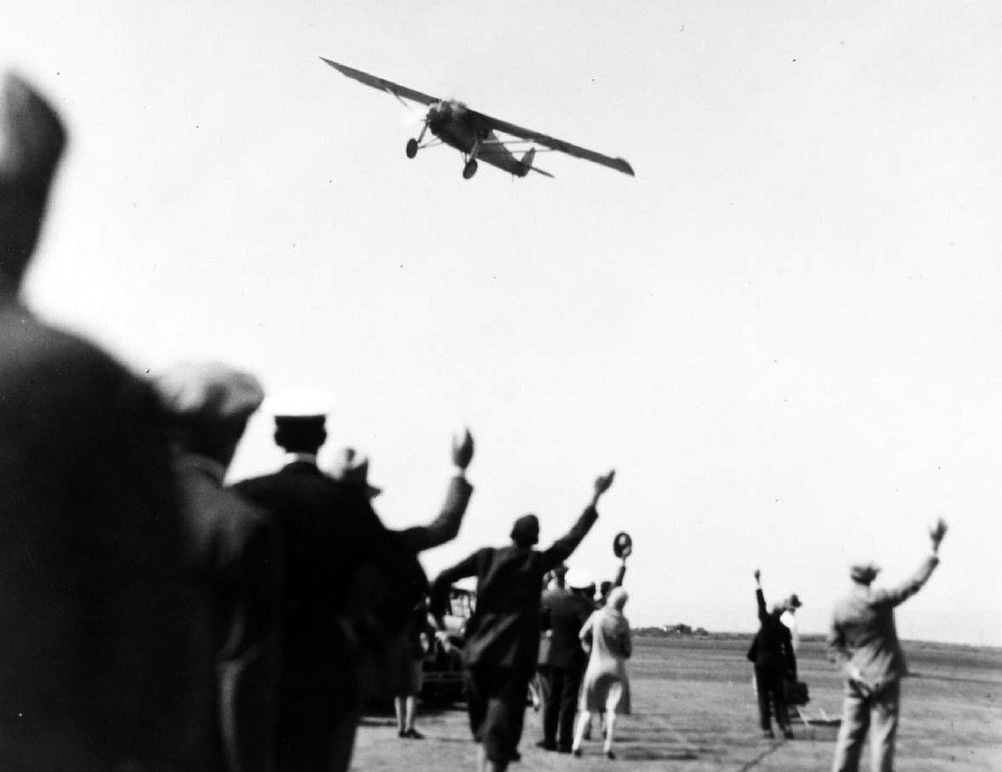 |
|
| (1927)* - Charles Lindbergh in his Spirit of Saint Louis preparing to land as spectators waive. |
Historical Notes On June 1st, 1927, the U.S Post Office issued a commemorative 10-cent "Lindbergh Air Mail" stamp depicting the Spirit over a map of its flight from New York to Paris, and which was also the first stamp issued by the post office that bore the name of a living person. |
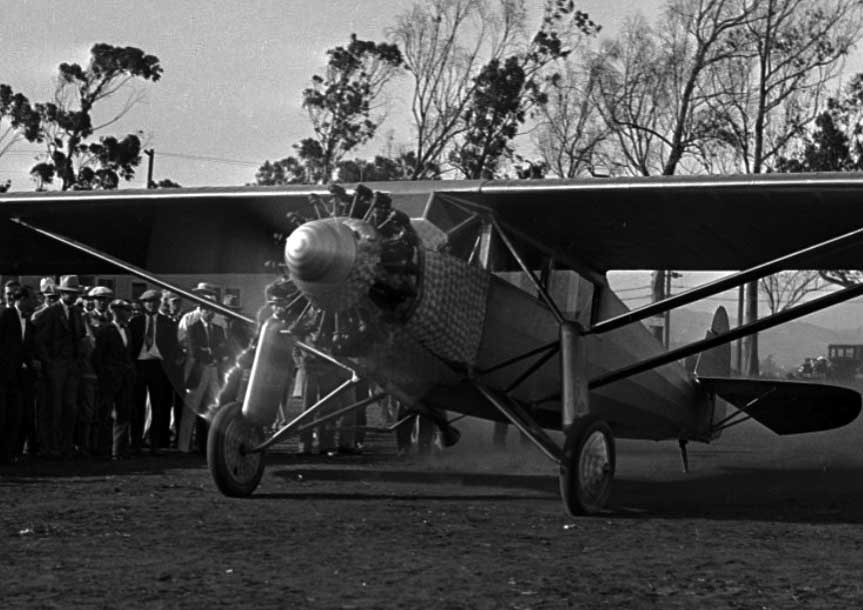 |
|
| (1927)* – The Spirit of St. Louis comes to a rest at Vail Field, Montebello. Charles Lindbergh and Spirit of St. Louis visited Vail Field (near East Los Angeles, Commerce, and Montebello). |
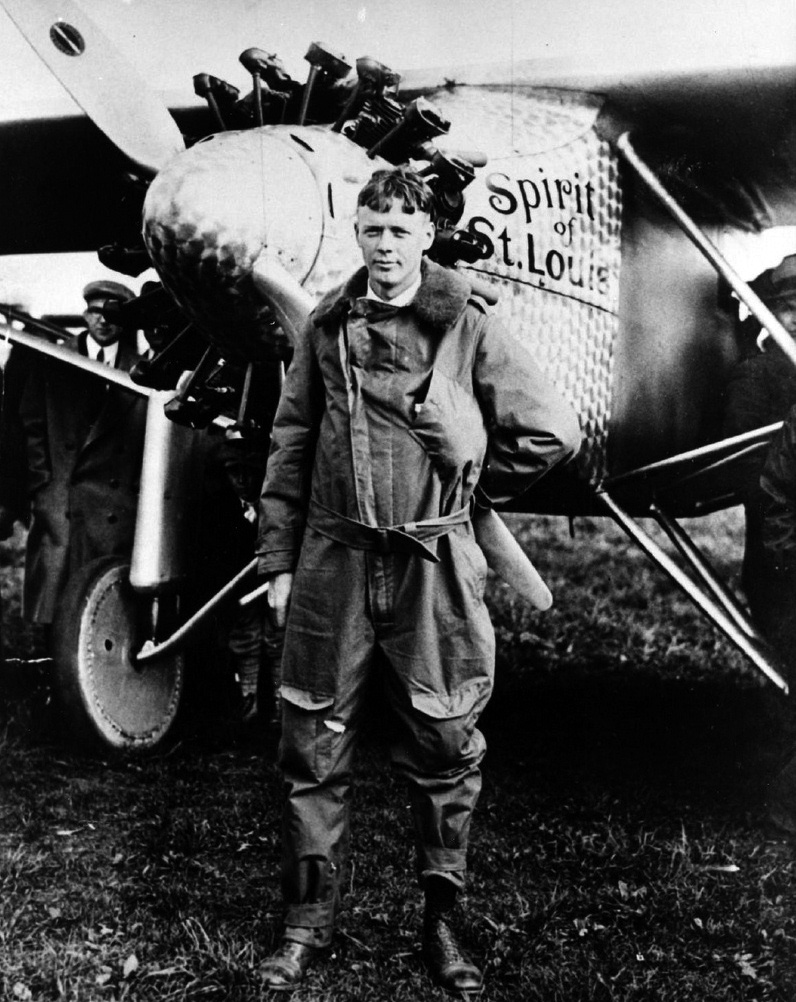 |
|
| (1927)* - Charles Lindbergh in front of the Spirit of St. Louis. |
Historical Notes Charles Augustus Lindbergh (1902-1974), an Army reserve officer and U.S. Air Mail pilot gained instant world fame when on May 21, 1927, he flew solo on a non-stop flight from Roosevelt Field on Long Island to Le Bourget Field in Paris in the single-seat, single-engine monoplane named the "Spirit of St. Louis". Because of this historic exploit, Lindbergh - nicknamed "Lucky Lindy" and "The Lone Eagle", was awarded the Medal of Honor, the nation's highest military decoration. In his later years, Charles Lindbergh became a prize-winning author, international explorer, inventor, and active environmentalist. Lindbergh's New York-to-Paris flight made him an instant celebrity and media star. In winning the Orteig Prize, Lindbergh stirred the public's imagination. He wrote: "I was astonished at the effect my successful landing in France had on the nations of the world. It was like a match lighting a bonfire." |
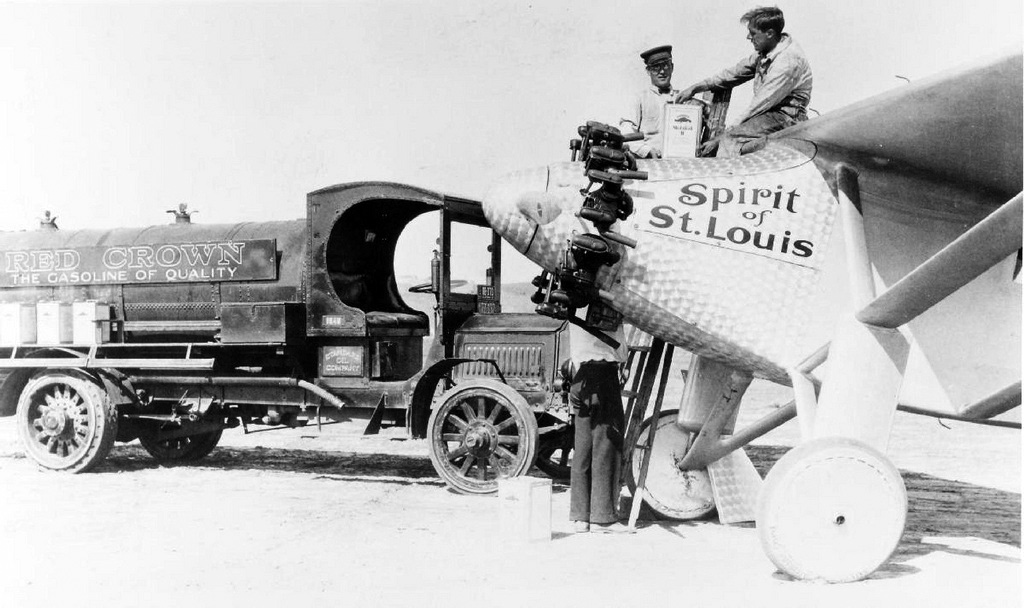 |
|
| (1927)* - Three men are in the process of fueling the Spirit of St. Louis. |
Historical Notes The Spirit of St. Louis had a fuel capacity of 450 U.S. gallons or 2,385 pounds which was necessary in order to have the range to make the transatlantic non-stop flight. The large main fuel tank was placed in the forward section of the fuselage, in front of the pilot, which improved the center of gravity. While locating fuel tanks at the front reduced the risk of the pilot's being crushed to death in the event of a crash, this design decision also meant that there could be no front windshield, and that forward visibility would be limited to side windows only. A periscope was installed to provide a forward view, as a precaution against hitting ship masts, trees, or structures while flying at low altitude. Lindbergh also used special navigation instruments such as the Earth Inductor Compass as its main instrument, allowing Lindbergh to navigate while taking account of the magnetic declination of the earth. |
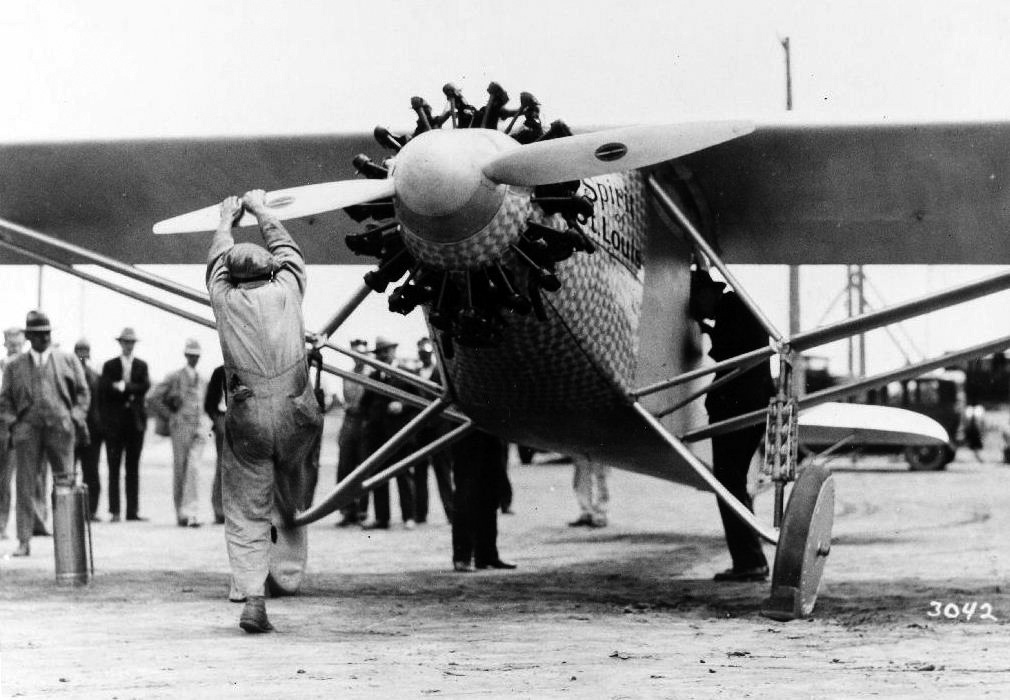 |
|
| (1927)* - Mechanic priming propeller of the Spirit of St. Louis as Charles Lindbergh prepares to take off to continue his goodwill tour. |
Historical Notes After his historic May 1st, 1927 transatlantic flight, Lindbergh flew the Spirit on promotional and goodwill tours across the United States and Latin America for over 10 months. |
 |
|
| (1926)* - Typically for its day, Vail Field featured unpaved runways. Unlike many of the smaller airfields, it did have hangars for storing planes, and it was used for some commercial flights. The hangars were basically gambrel-roofed barns with an open end. The smoothly curved Quonset roof seen on many hangars did not come about until World War II. |
Historical Notes Vail Field was historically important as one of the first airmail contractors. Western Air Express, had its origins there. Western Air Express was incorporated during 1926 by Los Angeles entrepreneurs for the purpose of bidding on airmail contracts to be awarded under the 1925 Kelly Air Mail Act which provided for the transfer of airmail routes from the Post Office's Aerial Mail Service to private carriers. |
 |
|
| (1926)* - Photograph of pilots readying an aircraft for the first air mail flight by Western Air Express, April 17, 1926. A line of four identical Douglass M-2 biplanes starts at center and extends into the distance at left. In front of the foremost plane, a group of men is standing near a pile of large mail sacks, and still more people are standing in front of a large mail truck at right. The truck is an early-model vehicle with a cargo area enclosed with wire. The ground is covered with rough grass. |
Historical Notes Western Air Express initially purchased six Santa Monica-built Douglas M-2 mail planes. They also purchased land to build the airport from some well-known cattle ranchers, the Vail brothers. |
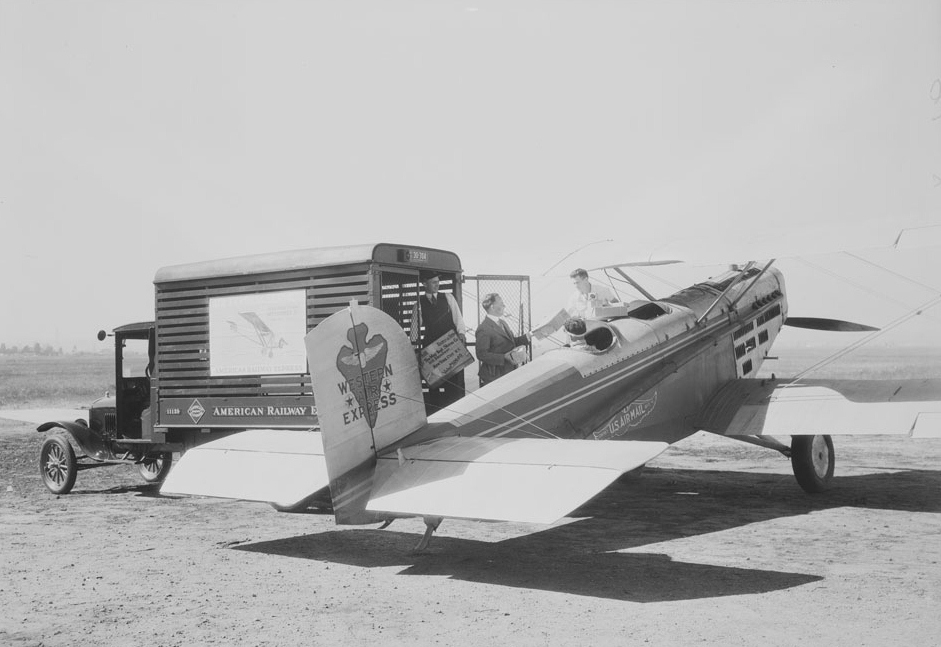 |
|
| (1927)* - Photograph of the Inauguration of the Air Express Service of the American Railway Express Company at Vail Field, August 31, 1927. Two men in suits stand at the back of the truck at center with packages to be transferred to the pilot, Maurice Graham. The small plane stands at right with "Western Air Express" printed on its back side. The air field lies in the background. |
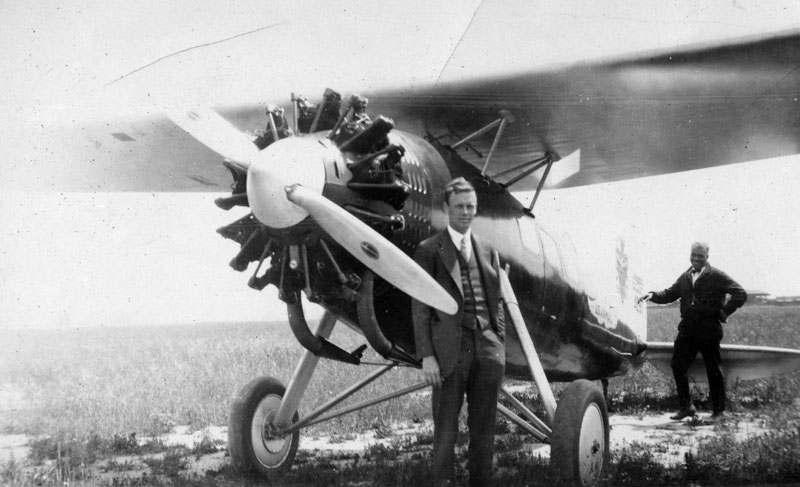 |
|
| (1928)* - Charles Lindbergh and an unidentified man stand next to a Lockheed Air Express at Vail Field in Montebello. |
Historical Notes The plane as seen above was the second aircraft designed and created by the Lockheed Aircraft Company after its founding in 1927. The design of the Air Express was based on the original fuselage of the Lockheed Vega, but the wing was raised to a parasol configuration above the fuselage and the cockpit was moved to behind the wing. Only seven Air Express planes were built. |
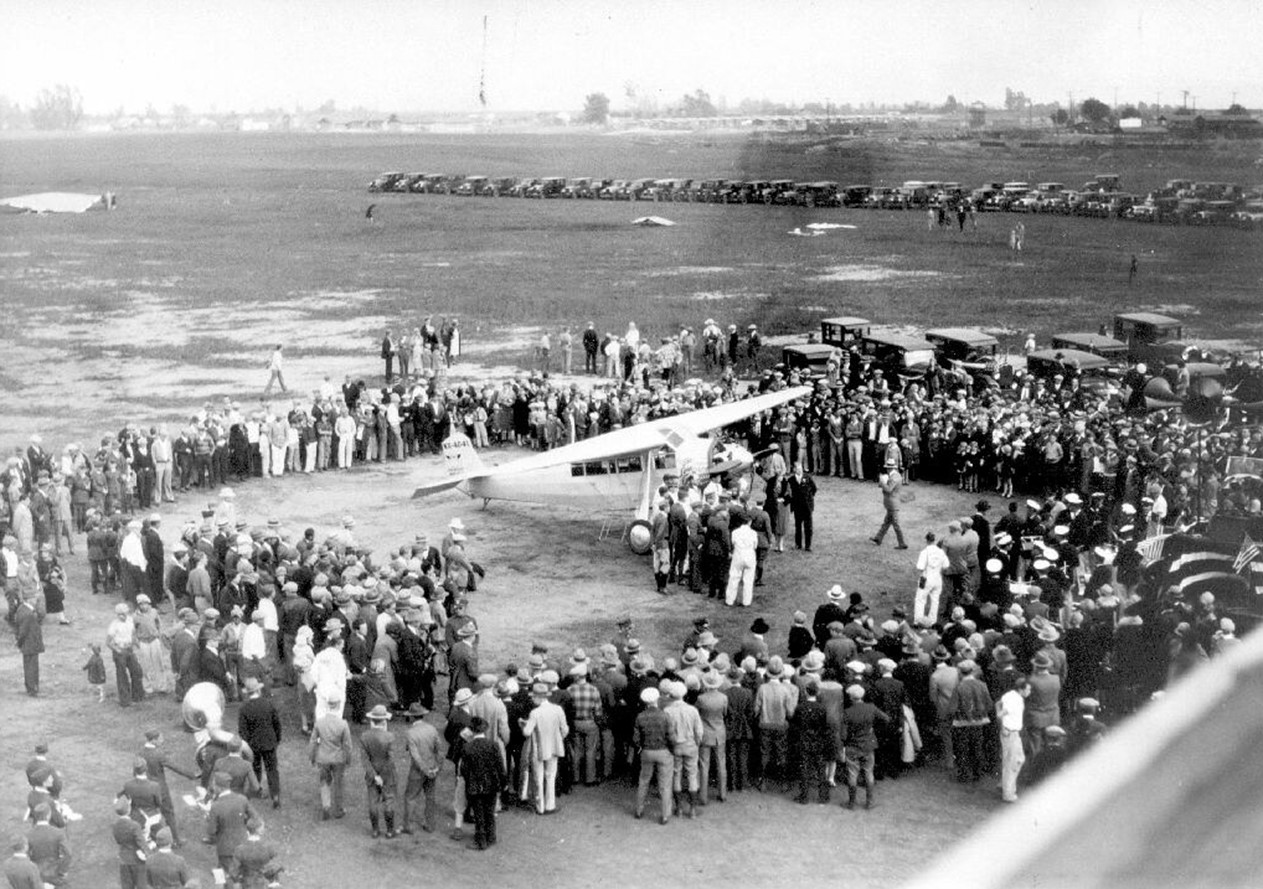 |
|
| (1928)* - Lone Eagle CM-1 first flight at Vail Field Los Angeles, people gathered around. |
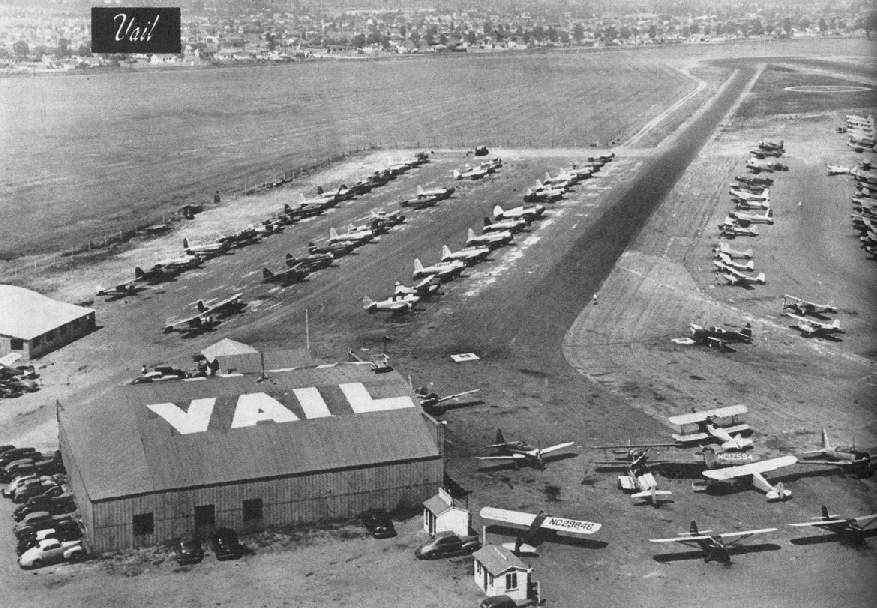 |
|
| (1947)* - Photo of Vail Airfield by Don Downie. The original caption reads, "Twenty-one A&E mechanics service the 220 planes based on this busiest airport in LA County. Seven miles east of the city, the port has a single 3,200' oiled runway no tower - and an air traffic problem. Tie-down is $15 monthly. Nearest transportation is 1/2 mile." |
Historical Notes Montebello’s Vail Field gave way to more lucrative uses as large tracts of open land became attractive as real estate investments. It was evidently closed at some point between 1950-53, as a 1953 aerial photo showed that Garfield Avenue had been extended through the property, with the runway and hangars having been cleared and replaced by new streets. |
* * * * * |
Alhambra Airfield
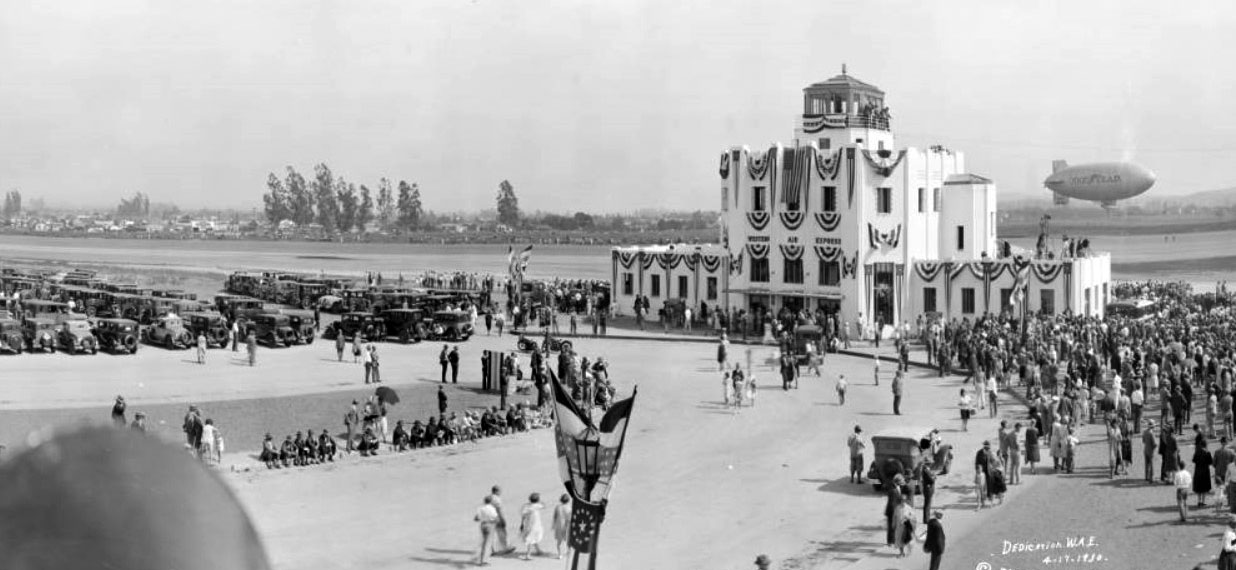 |
|
| (1930)* - Panoramic (left frame) view showing the dedication ceremonies of the new Western Air Express terminal at Alhambra Field on April 17, 1930. The Good Year blimp is in the background. |
Historical Notes The Alhambra Airport opened in April 1930, located south of Valley Blvd. between New Avenue and Almansor Street. Western Air (the forerunner of Western Airlines) built the terminal, the passenger terminal, and the largest airplane hanger in the world at that time. Western Air Express relocated from Vail Field to Alhambra Airport. |
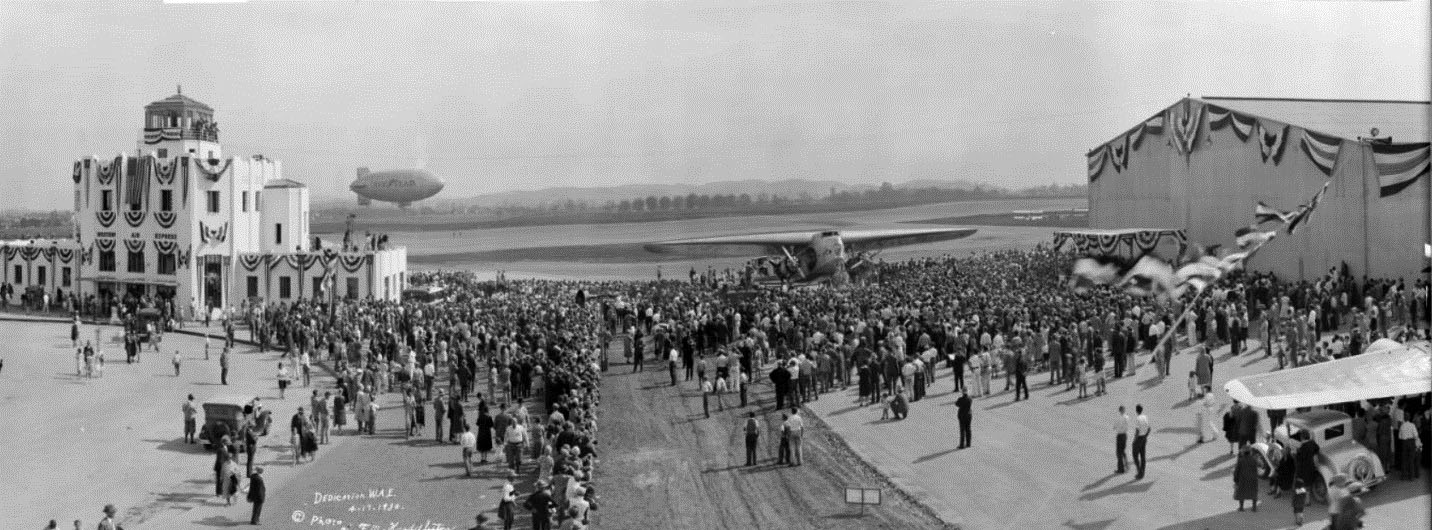 |
|
| (1930)* - Panoramic (right frame) view showing a crowd of about 10,000 at the dedication of Western Air Express terminal at Alhambra Field. The crowd is centered around the new 12-passenger Fokker transport plane just purchased by Western Air Express (later Western Airlines). The Good Year blimp can be seen in the background. Photo Date: April 17, 1930 |
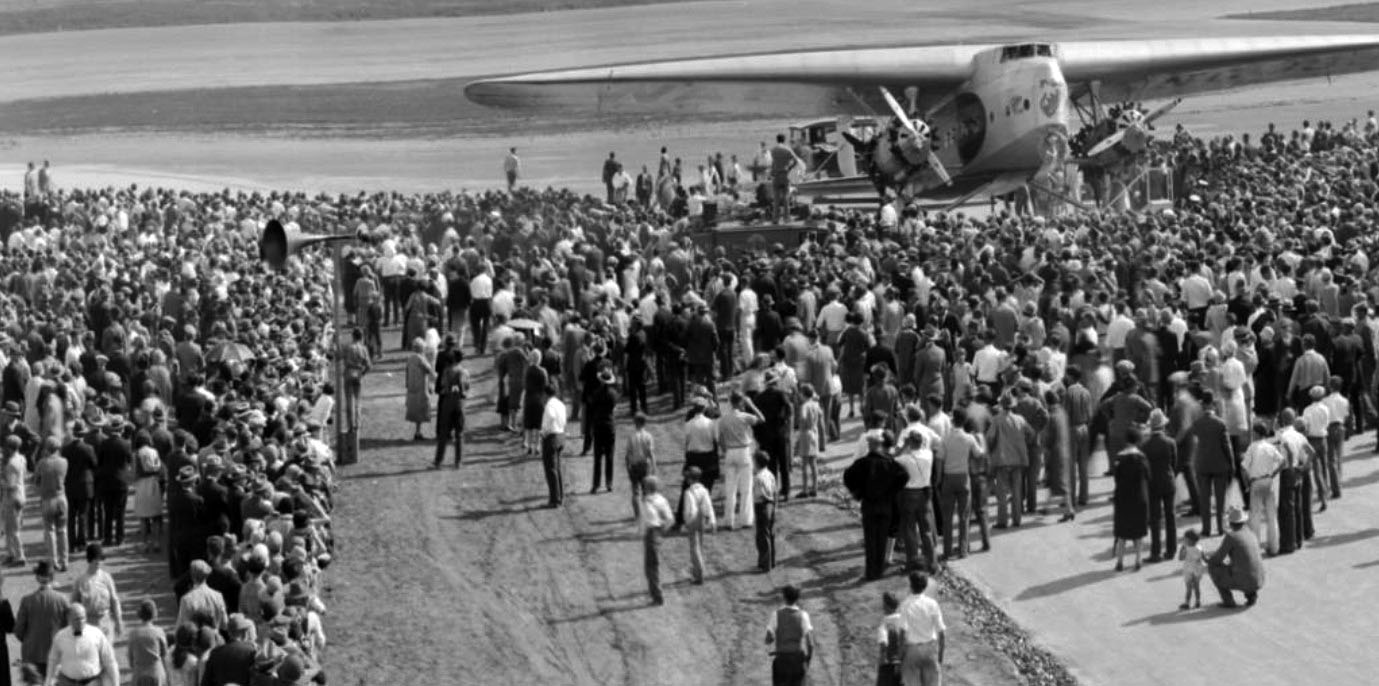 |
|
| (1930)* – Close-up view showing thousands of people around a Fokker F-32 aircraft at the Western Air Express terminal dedication. |
 |
|
| (1930)* - Aerial view looking down at the Alhambra Airport during its opening dedication. The Good Year blimp is visible overflying the field at a lower altitude. Two large hangars are seen in the upper-right. One is hexagonal in shape. |
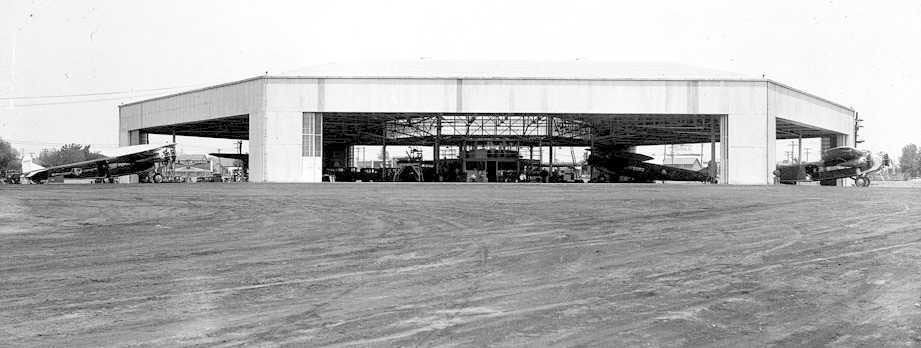 |
|
| (ca. 1930)* - View of Alhambra Airport’s Hexagonal hangar with four Tri-Motors outside and in. |
Historical Notes Western Air Express operated a fleet of six 12-passenger Fokker transports. Their large maintenance hangar was shaped like a hexagon, and had doors on each face so that all six aircraft could be worked on simultaneously, a unique feature. |
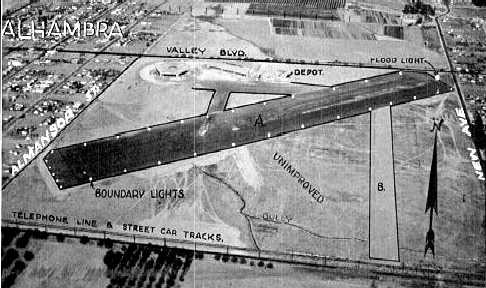 |
|
| (ca. 1930)* - Aerial annotated view of the Alhambra Airport looking north. The airfield configuration was a 2,700' oiled northeast-southwest runway, with 2 hangars in the northeast corner. |
Historical Notes The airport continued in operation until 1943 when the 157 acre property was put up for sale. The city of Alhambra took over the property the following year. In 1945, Harlow Aircraft Company purchased the airport from Western for $350,000 where they manufactured small airplanes. In 1946, Harlow sold off to real estate developers who subdivided the property, bringing an end to the airport. Western Air Express moved its operations to the Grand Central Air Terminal in Glendale. Western Air Express later became Western Airlines, ceasing to exist following its 1987 merger with Delta Air Lines. |
* * * * * |
Fokker F-10 Trimotor
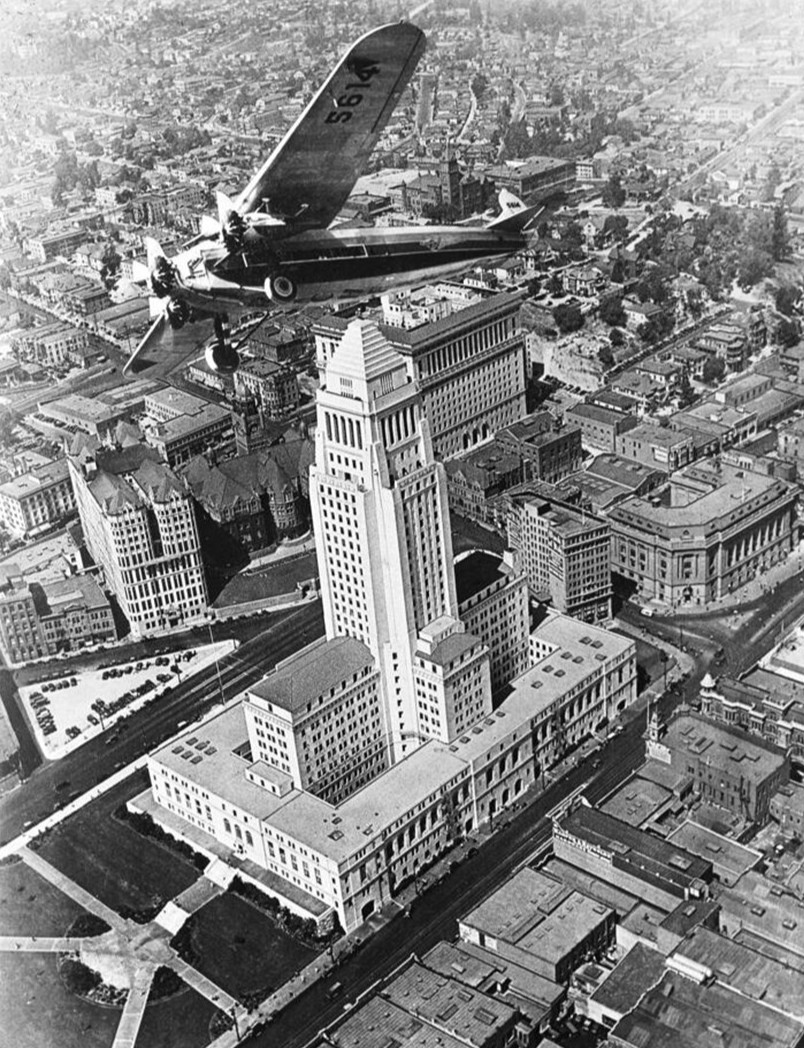 |
|
| (1929)*– Aerial view of a high-wing Fokker Trimotor passenger plane banking over downtown Los Angeles, with the newly completed City Hall directly below. |
Historical Notes The Fokker F-10 Trimotor was among the most advanced airliners of its time and represented the optimism of aviation’s “Golden Age.” Built by the Fokker Aircraft Corporation of America, it was an enlarged version of the earlier F.VII, designed by Dutch aviation pioneer Anthony Fokker. The F-10 featured a metal-tube fuselage covered with fabric and wooden wings with internal plywood structures. Powered by three Wright J-6 Whirlwind radial engines, it could carry up to 12 passengers at speeds approaching 120 mph—fast for its day. Western Air Express, a Los Angeles–based carrier and forerunner of TWA, operated the F-10 on early West Coast passenger and mail routes, linking Los Angeles with San Francisco and other cities. The aircraft’s triple-engine configuration provided a reassuring margin of safety at a time when engine reliability was still a concern. The 1929 photograph, showing the F-10 banking dramatically over the newly completed Los Angeles City Hall, captured the spirit of progress that defined the era—symbolizing both the rise of air travel and the city’s emergence as a major urban center. Within two years, however, the tragic 1931 crash of a TWA F-10 near Bazaar, Kansas, which claimed the life of Notre Dame football coach Knute Rockne, exposed the vulnerability of its wooden wing structure and hastened the transition to all-metal aircraft designs. Even so, the Fokker Trimotor remains a landmark in commercial aviation, bridging the gap between pioneering mail planes and the modern airliners that would soon follow. |
Then and Now
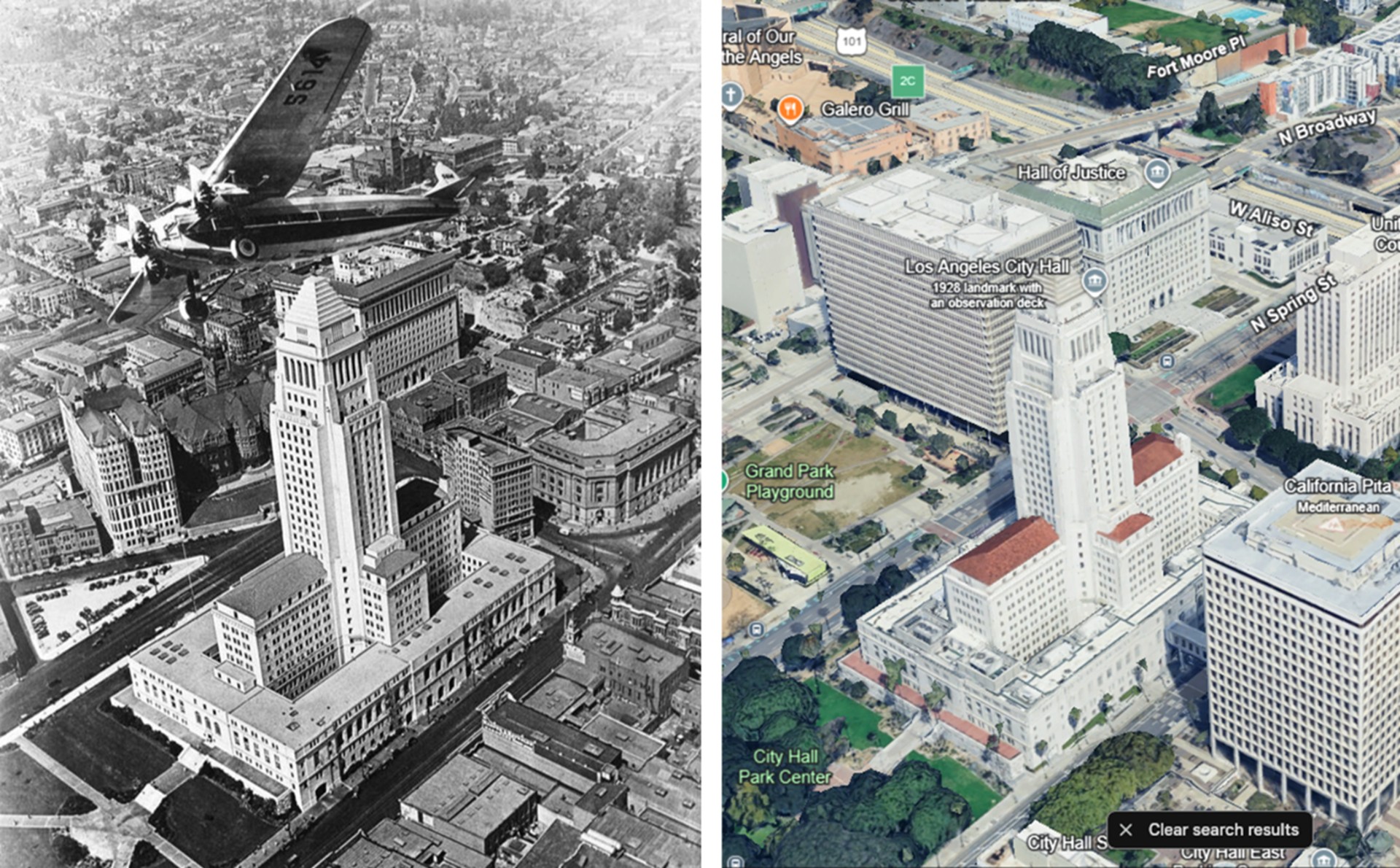 |
|
| (1929 vs. 2023)* - Then and now views of the Los Angeles Civic Center taken from nearly the same vantage point above City Hall. Photo comparison by Jack Feldman. |
Historical Notes In 1929, City Hall had just been completed and rose high above a patchwork of smaller commercial buildings, courthouses, and early civic structures. The old County Courthouse and the original Hall of Records still stood nearby, while the Hall of Justice (1925) was one of the first buildings of the emerging Civic Center. Over the next few decades, most of the surrounding blocks were cleared as part of the city’s civic redevelopment plan, replacing the dense downtown fabric with large government buildings and open plazas. The Hall of Administration (1960), the new Hall of Records (1962), and later the U.S. Courthouse reshaped the area into the modern Civic Center. In the 2023 view, City Hall remains the centerpiece, now fronted by Grand Park, which links it to Bunker Hill and the Music Center. The contrast between the two eras highlights Los Angeles’ transformation from a compact early metropolis to a broad, formal civic landscape. |
* * * * * |
Fokker F-32
 |
|
| (1930)* - View showing a chorus line on the wing of the big Fokker F-32 having their kicks. |
Historical Notes Following the success of the smaller three-engine Fokker F-10, the Fokker F-32 represented a bold step forward in commercial aviation—it was the first American-built, four-engine passenger transport, larger, more powerful, and far more luxurious than its predecessor. In 1930, Western Air Express (WAE) used the Fokker F-32 to inaugurate the first four-engine transport service. To promote this event, a unique and memorable publicity stunt was organized involving the Fanchon & Marco Fanchonettes, a famous chorus line of dancers. Eighteen of these dancers performed on the wing of the F-32, creating a striking visual spectacle that was captured in photographs and widely publicized. This event was part of a broader promotional effort to highlight the advanced design and capabilities of the F-32, which included luxurious fittings and a spacious cabin. The Fanchonettes’ performance on the wing of the F-32 was emblematic of the era’s blend of aviation innovation and entertainment, aiming to capture public interest and demonstrate the aircraft’s stability and size. Despite such promotional efforts, the F-32 faced commercial challenges and only a few units were built. |
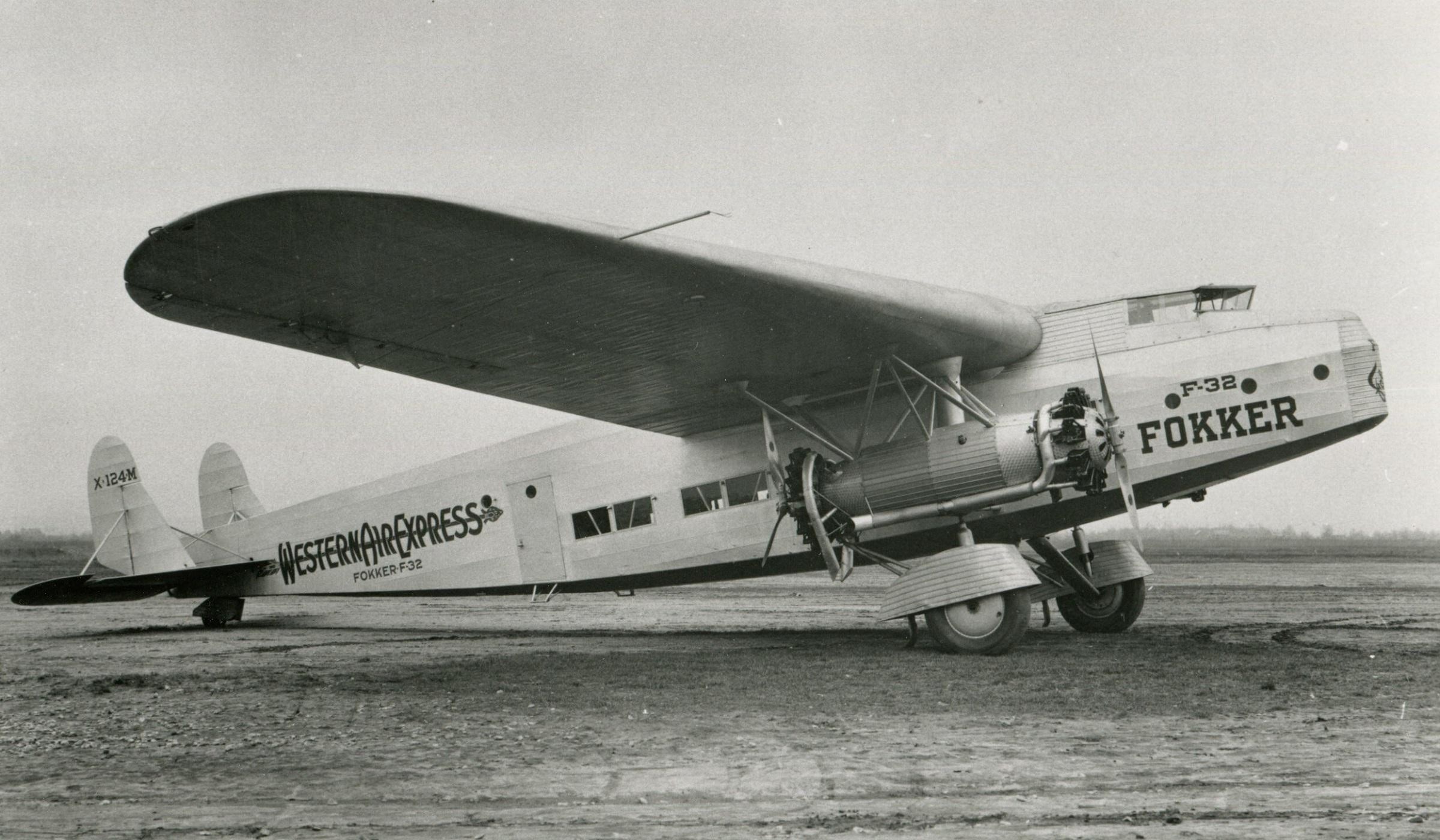 |
|
| (1930)* - Side view of the short-lived Fokker F-32, flown by Western Air Express. |
Historical Notes The Fokker F-32 was produced at Fokker’s Teterboro, New Jersey, plant in 1929. It was notable for being the first four-engine Fokker design and the last Fokker aircraft developed in the United States before the company folded during the Great Depression. Only ten aircraft were built. Although impressive in scale, the design suffered from high operating costs and mechanical inefficiencies caused by its unusual back-to-back engine arrangement—one engine facing forward and the other aft on each wing nacelle. The rear engines, operating in the turbulent airflow of the front propellers, were prone to overheating and performance loss. The first F-32 crashed on November 27, 1929, during a demonstration of a three-engine takeoff from Roosevelt Field on Long Island, New York, witnessed by poet Ogden Nash. Western Air Express and Universal Air Lines each ordered five aircraft, but Universal canceled its order and WAE only accepted two before the economic downturn made operation unfeasible. |
 |
|
| (1936)* - The Fokker F-32 repurposed as a gas station. You could gas up your car beneath the wings of a grounded Fokker aircraft at Bob’s Air Mail Service Station on the n/w corner of Wilshire Boulevard and Cochran Avenue. |
Historical Notes After their brief service life, the two Fokker F-32 aircraft used by Western Air Express found an unusual second life. One of these aircraft was repurposed as a gas station on Wilshire Boulevard in Los Angeles. The plane was painted in Mobilgas colors, and fuel pumps were placed under its broad wings. This unique setup, known as Bob’s Air Mail Service Station, became a local attraction—its forward engines were occasionally started for show, thrilling motorists and passersby along Wilshire’s bustling Miracle Mile. Click HERE to see more Early Views of LA Gas Stations. |
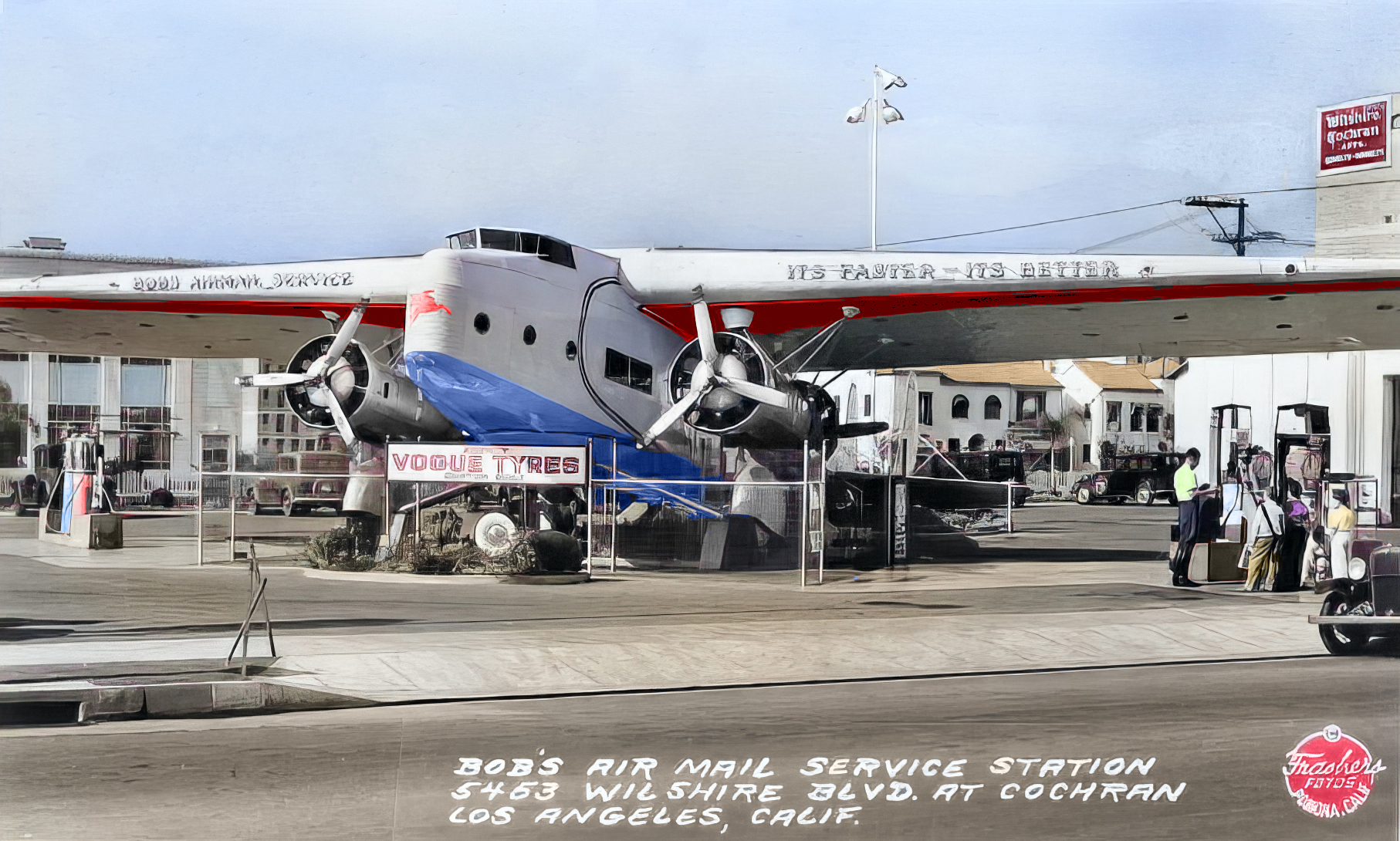 |
|
| (1936)*- The Fokker F-32 repurposed as a gas station. You could gas up your car beneath the wings of a grounded Fokker aircraft at Bob’s Air Mail Service Station on the n/w corner of Wilshire Boulevard and Cochran Avenue. Image enhancement and colorization by Richard Holoff |
Historical Notes The colorized version by Richard Holoff vividly restores the look of this whimsical chapter in Los Angeles history, capturing the metallic sheen of the F-32’s fuselage and the red Pegasus emblem of Mobilgas under the Southern California sun. In color, the aircraft-turned-service station feels even more surreal—a striking symbol of how quickly aviation’s great experiments could transform from marvels of progress to roadside curiosities. Click HERE to see more Early Views of LA Gas Stations. |
* * * * * |
Hamilton Cove Airport (Catalina)
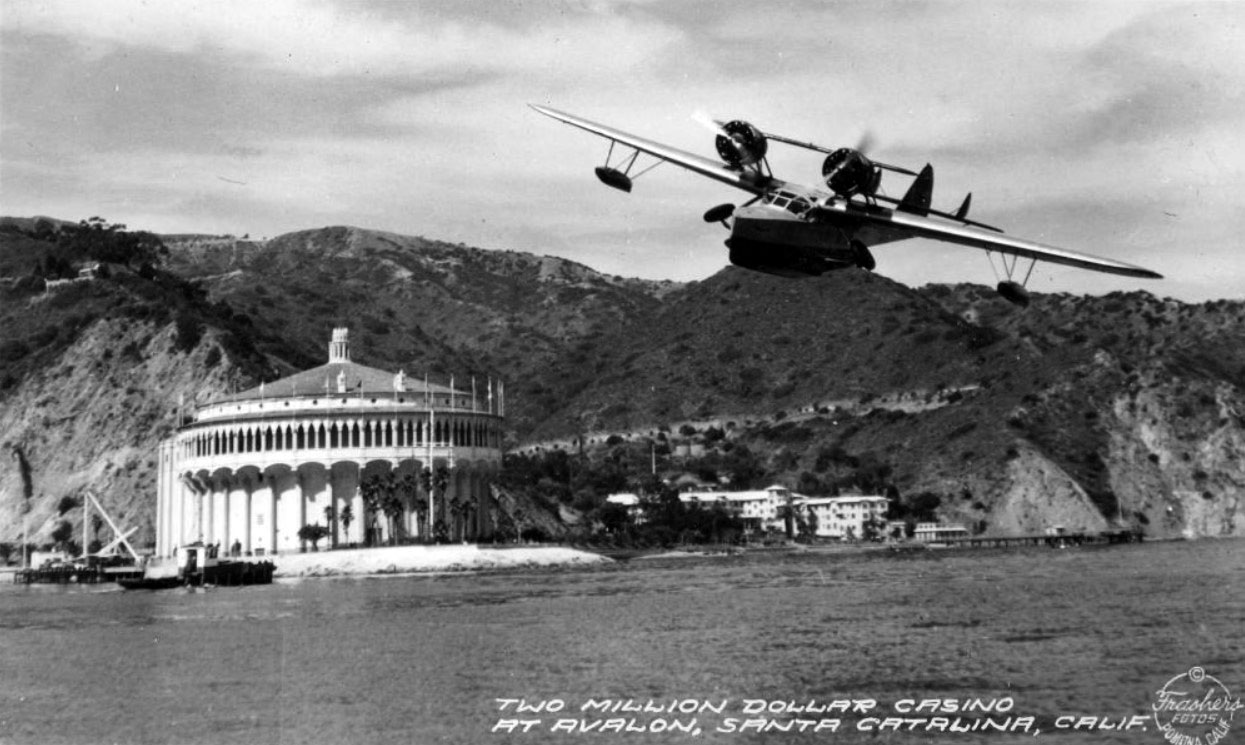 |
|
| (1930s)* - Postcard view showing a seaplane arriving with tourists at Avalon Bay in front of the “Two Million Dollar” Catalina Casino. The Casino was commissioned by William Wrigley Jr. in 1929 to commemorate the 10th anniversary of his purchase of Catalina Island. Remarkably, it did cost $2 million—a sum considered extravagant at the time. |
Historical Notes Seaplanes were another popular and more expensive option of tansportation to Catalina Island. Charlie Chaplin’s half-brother Syd began the first seaplane service to Catalina in 1919. It operated only for a couple of summers, but other firms moved in to operate the service until 1931. In that year, the island’s owner, Phillip K. Wrigley, began the Wilmington-Catalina Airline, Ltd. through his Santa Catalina Island Company. |
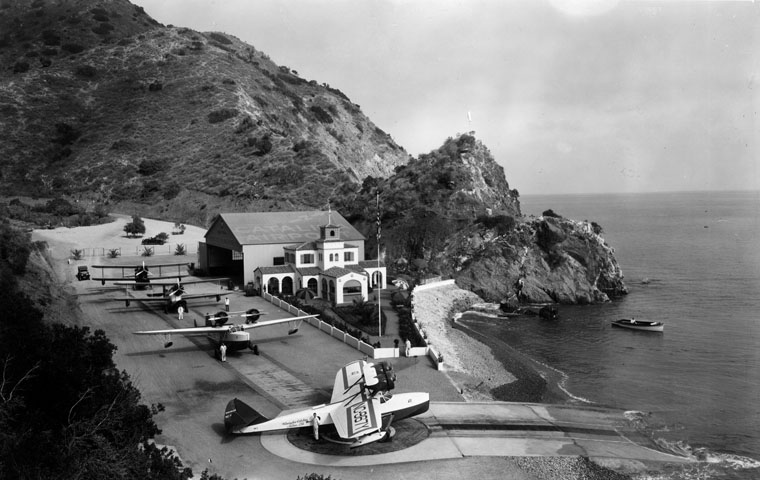 |
|
| (ca. 1931)* - Scenic view of Catalina Airport on Santa Catalina Island. Four planes are parked on a small runway, with three men, each standing by a plane. One man points to writing on the plane which reads, "Wilmington-Catalina Airline, Ltd." |
Historical Notes Catalina Airport at Hamilton Cove: Officially known as the Hamilton Cove Seaplane Base, it operated from 1922 to 1947 and served as Catalina Island’s primary air transportation hub during the 1930s. Located just north of Avalon, the base allowed amphibious seaplanes to land offshore and taxi up a ramp for passenger access. It was once described as “the smallest airport with the longest landing field (the Pacific) in the world." Philip Wrigley (son of William Wrigley, Jr.) helped design a unique airport at Hamilton Cove, the second cove north of Avalon. This airport was designed to accommodate the Douglas Dolphin amphibian planes of the Wilmington-Catalina Air Line, Ltd., a Wrigley-operated firm. The twin engine Dolphins landed just offshore and would taxi up a ramp to a large turntable mechanism. The airplane would then be rotated until it was facing the water and ready for a trip back to the mainland. A small Spanish-style terminal building welcomed residents, business people and tourists to Catalina. |
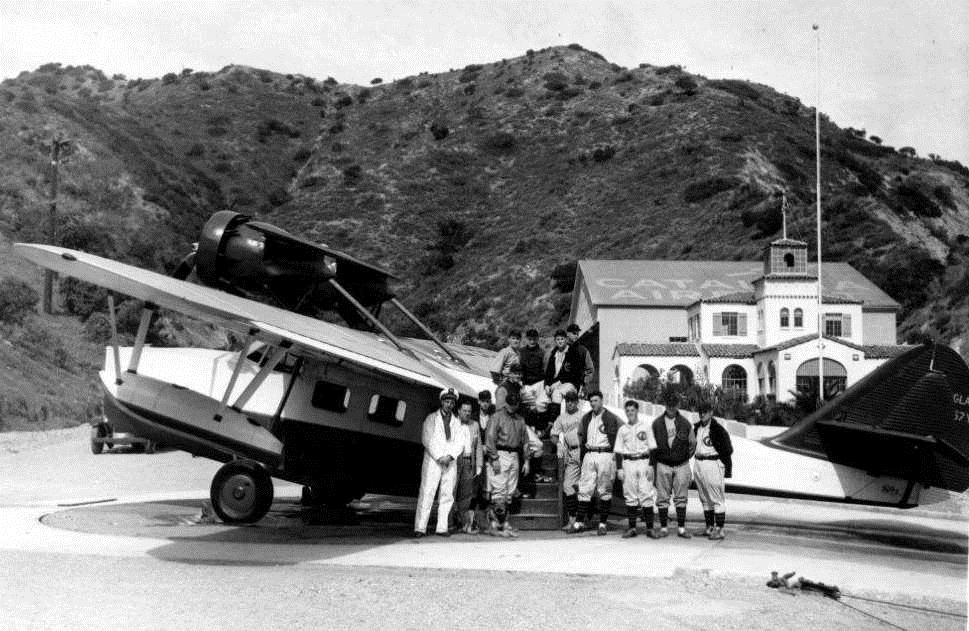 |
|
| (ca. 1931)* - William Wrigley's Chicago Cubs at the Hamilton Cove Airport. |
Historical Notes William Wrigley, Jr. played an instrumental role in the history of Catalina Island. He bought controlling interest in the Santa Catalina Island Company in 1919 and with the company he received the island for free. Wrigley improved the island with public utilities, new steamships, a hotel, the Casino building, and extensive plantings of trees, shrubs and flowers. In 1921 Wrigley moved the Spring Training site of his professional ball club, the Chicago Cubs, to Catalina. That same year, he also purchased the Los Angeles Angels who he would build another Wrigley Field for in South Los Angeles (1925). Click HERE to see more in Baseball in Early L.A. |
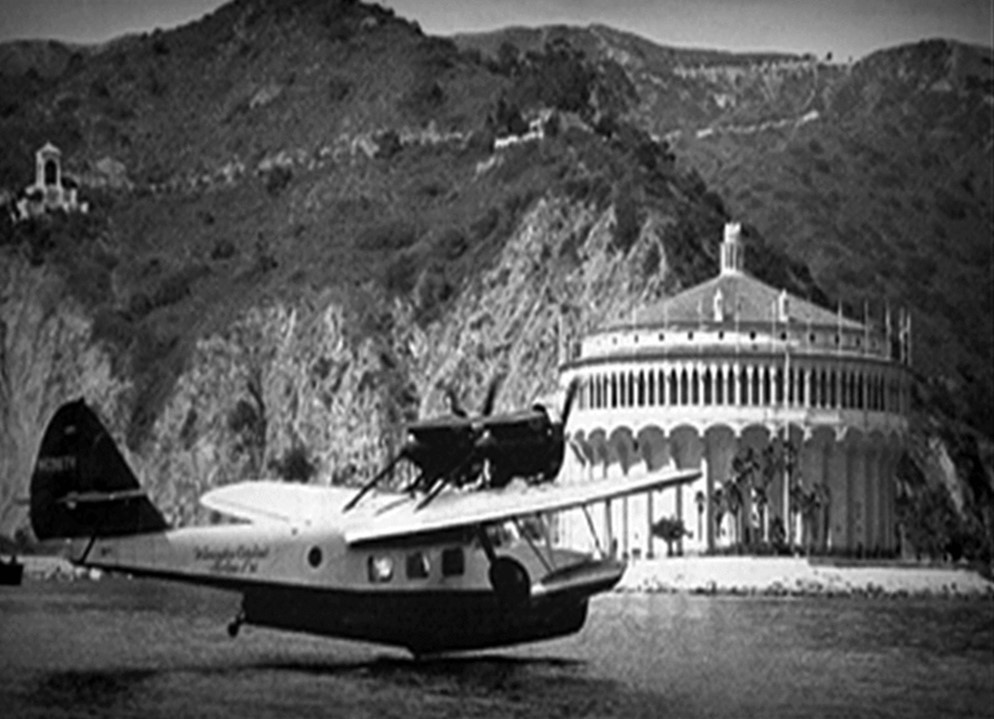 |
|
| (1931)* - Seaplane landing near the new "Two Million Dollar Casino" in Avalon. |
Historical Notes Aircraft desinger Donald Douglas designed the main seaplane used by Wilmington-Catalina Airline, the Douglas Dolphin. The twin-engined seaplane was the first of his planes to be used as a commercial passenger airliner. Its interior was well-appointed and could comfortably seat 10 passengers for the princely fee of $5.00 for a one-way trip in 1938. |
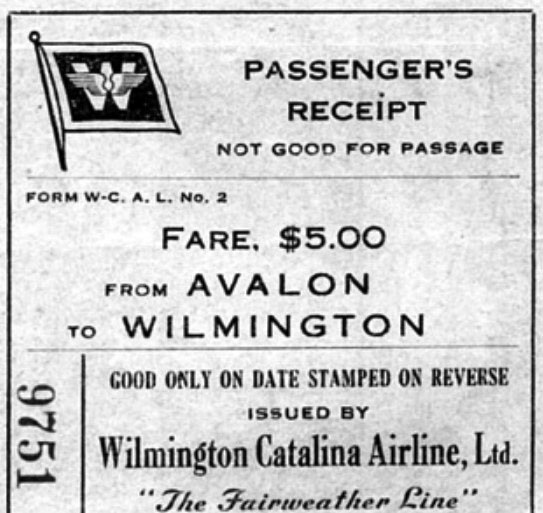 |
|
| (ca. 1938)* - Passenger receipt for a one way seaplane trip from Avalon to Wilmington on Wilmington Calalina Airline, Ltd. "The Fairweather Line". Fare - $5.00 |
Historical Notes In August 1940, plans that had been made to expand aviation operations on the island to include land-based airplanes started to become a reality when construction began for an airport located on the island’s interior. The Airport in the Sky was completed in 1941, the airline operation was renamed Catalina Air Transport and the future looked bright. Until December 7, 1941, when everything changed. Within a couple of weeks after the Pearl Harbor attack, the steamships were stopped from transporting passengers, and by September 1942, no civilian planes were allowed to land, effectively shutting down the entire island. It had become a closely patrolled federal military zone. Eventually, several military outposts were established there to conduct training for the duration of the war. The Airport in the Sky was shuttered, though it would reopen as a full-service general aviation facility in 1946. |
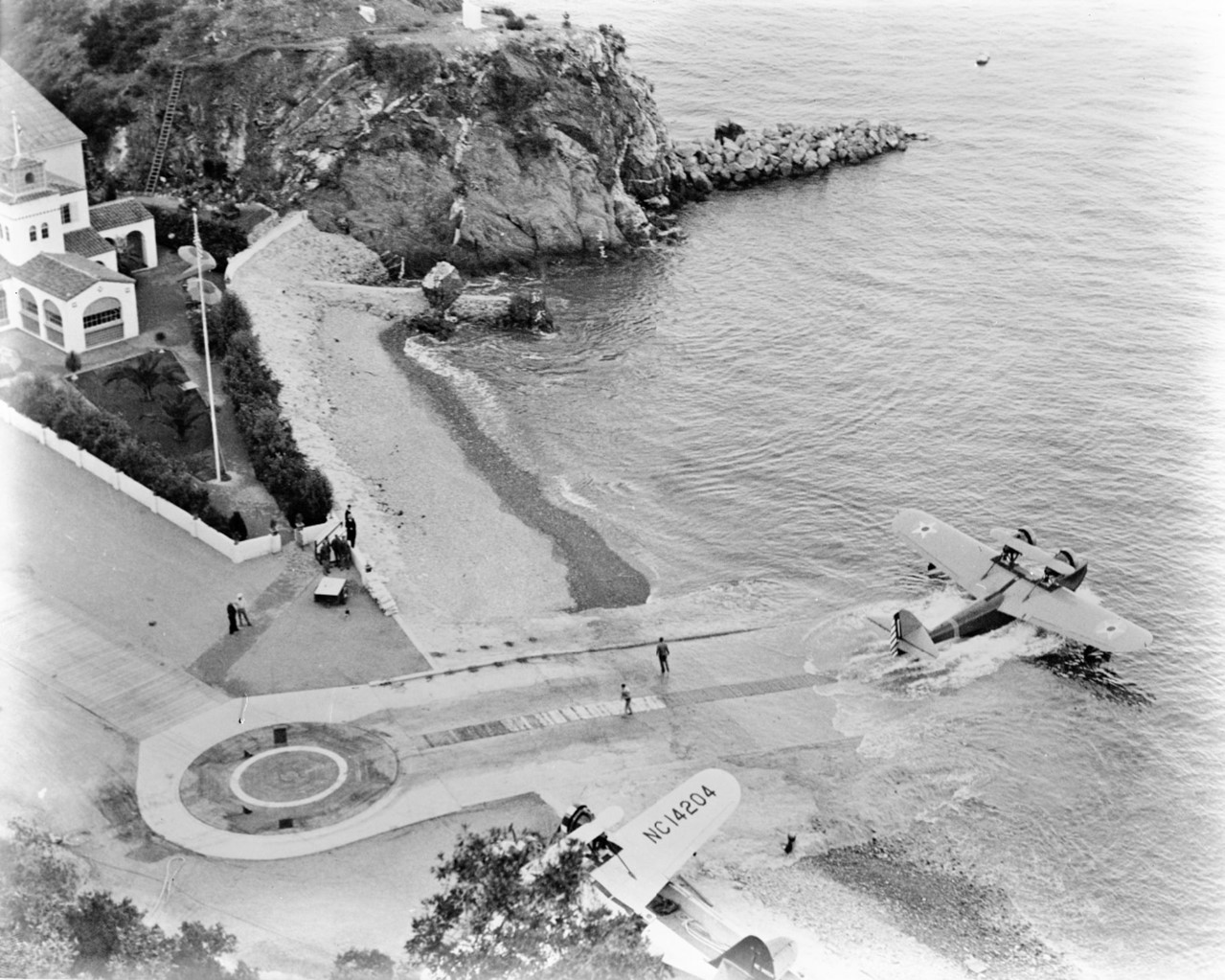 |
|
| (1942)* - A seaplane departs from Hamilton Cove Airport in Catalina. |
Historical Notes Click HERE to see more in Early Views of Catalina |
* * * * * |
Early Aviation
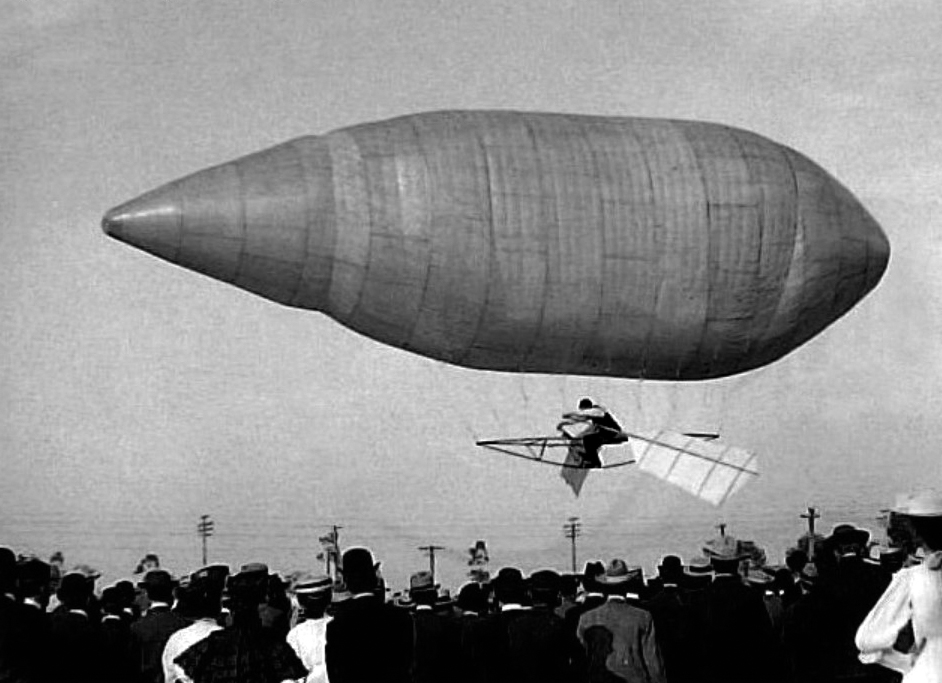 |
|
| (1905)* – View showing an airship (also dirigible) at Chutes Park, Los Angeles, built by Alva L. Reynolds. Demonstrated on September 10, 1905 by George D. Frisbie. |
Historical Notes Propelled by two air-oars, the aeronaut – seated on a 10 feet long by 3 feet wide gondola – “rowed” the neutral-buoyancy airship through the air. |
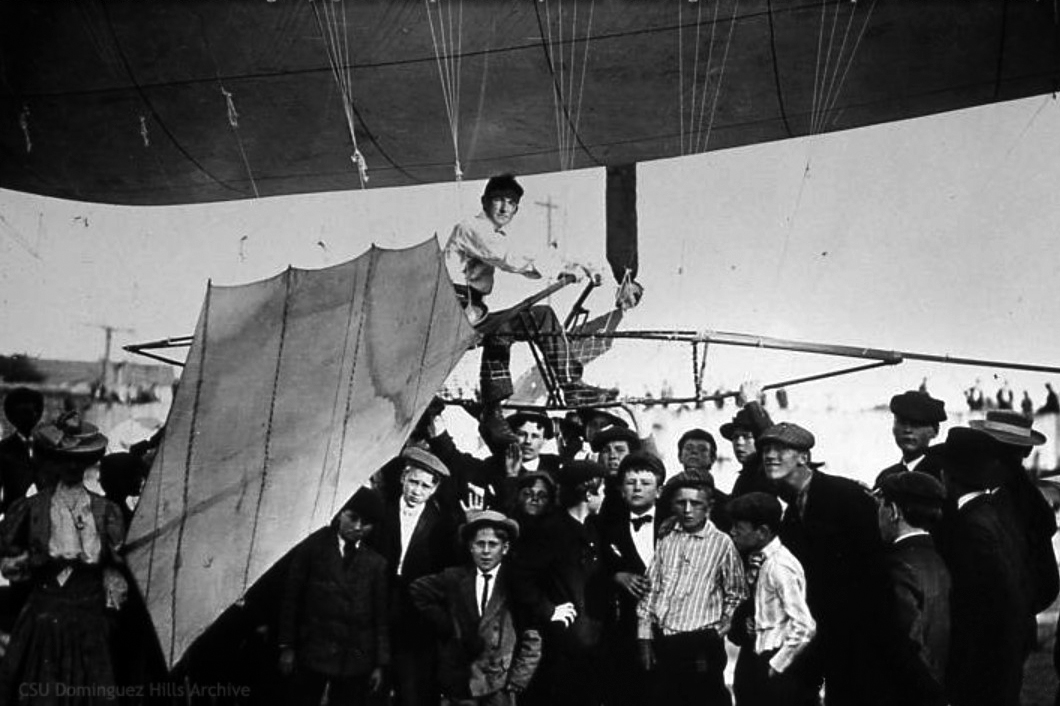 |
|
| (1905)* – View showing an unidentified aeronaut rowing a man-powered Reynolds “Man Angel” air-oar airship at Redondo Beach, California. |
 |
|
| (Early 1900s)* - A crowd of people looking up as a bi-plane flies overhead. It appears that some people are running to take cover....or just moving quickly to get a better view. |
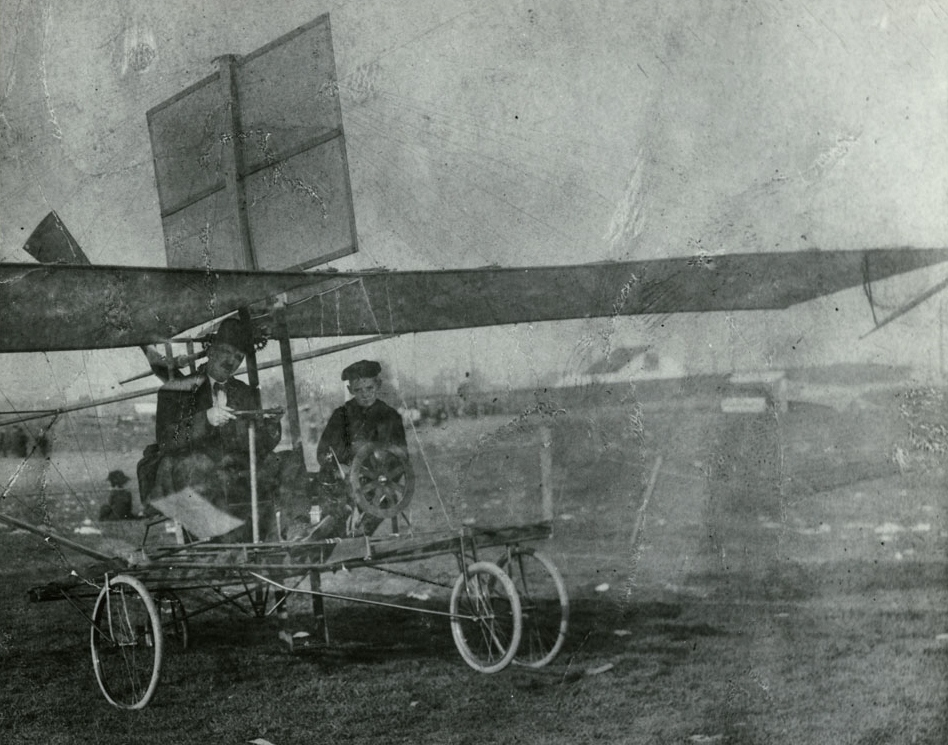 |
|
| (ca. 1910)* - Photograph of a man and a small child sitting in a Skoglund Monoplane. To the left, a man and a small child are seen sitting in a crudely made plane on a grassy field. The man is seen wearing formal attire and a small round hat. To his right, the young boy is seen wearing a darkly-colored cloak and a small cap. The man is seen gripping a small, round wheel that extends into the frame of the plane below. Next to the boy, a small wheel and bell are also visible. Above the man, the flat, rectangular wings of the plane are clearly visible. Also, a thin plane perpendicular to the wings is seen above the wings. Behind the wings, a part of a single propeller is visible. Below the man and child, four thin tires are seen balancing the plane's crude frame. In the extreme background, additional people and a building are barely visible. Description on back of the photo print reads: "Ed Davenport and father. 1467 Hehner St (?) Eagle Rock". |
Historical Notes The Skoglund monoplane was a simple aircraft with a crude tricycle undercarriage that had a relatively wide simple wheel track. It had some kind of roller blind ailerons on the wing tips that appeared to be controlled from the cockpit. Skoglund made extra money by allowing spectators to sit in his airplane and charged them a fee for the pictures such as the one seen above. |
 |
|
| (1909)* - The first pig to fly. |
Historical Notes The phrase "when pigs fly" is a well-known adynaton, a figure of speech used to describe something that is impossible. However, this notion was humorously challenged on November 4, 1909, when John Moore-Brabazon, an English aviation pioneer, made a historic flight with a piglet named Icarus II. This event took place at the Isle of Sheppey in Kent, England. Moore-Brabazon attached a small wastepaper basket to the wing strut of his Short Brothers biplane and placed the piglet inside. The flight, which covered a 3.5-mile round trip over the Thames Estuary, was intended as a whimsical demonstration to prove that "pigs can fly" and to overturn the proverbial impossibility. Despite initial squeals, the piglet remained calm during the flight, which was reported in newspapers and became a local sensation. This flight is often considered the first cargo flight on UK soil and the first flight of any livestock in a powered vehicle. John Moore-Brabazon's contributions to aviation did not end there. He was the first Englishman to fly a powered aircraft on British soil and later became the first person to qualify for a UK pilot's license. His career included significant achievements in aerial photography and reconnaissance during World War I and contributions to civil aviation planning post-World War II. The piglet, Icarus II, was spared from slaughter and kept as a pet by its owner, becoming a local celebrity. This event remains a charming anecdote in the history of aviation, illustrating how a playful act can capture public imagination and challenge long-held beliefs. |
 |
|
| (1913)* - Two cars racing, partly obscured by clouds of dust, with aviator Glenn Martin piloting biplane above serving as race referee. This photograph appears on page 415 of Popular Electricity magazine, Vol. VI, no. 1, May, 1913; the Owensmouth Road Race is covered in the Los Angeles Times, March, 1913. |
Historical Notes The Owensmouth Road Race in 1913 featured a unique promotional element: an airplane. Aviator Glenn Martin piloted a biplane and served as the race referee, a detail confirmed by a 1913 publication stating, "Martin referees car race in air." The scene, with two cars racing through clouds of dust and Martin flying above, epitomized the race's promotional activities. This use of an airplane to oversee and promote the race was part of a broader spectacle designed to showcase the modernity and infrastructure of the newly established town of Owensmouth. Held on March 27, 1913, the race was a significant event in the early history of Owensmouth, now known as Canoga Park. It was part of efforts to promote the town, founded on March 30, 1912, and featured prominent auto racing pioneer Barney Oldfield, receiving extensive coverage from the Los Angeles Times. Owensmouth was created during a period of rapid development in the San Fernando Valley, spurred by improved transportation options like electric railways and automobiles, and the anticipation of water from the Owens Valley. Initially part of a large tract of land owned by Isaac N. Van Nuys, it was sold to the Los Angeles Suburban Homes Company in 1909. This syndicate included influential figures such as Harry Chandler and Harrison Gray Otis of the Los Angeles Times, and developer Hobart Whitley. The Owensmouth Road Race was among many promotional activities organized to attract attention and settlers to the area. The event included a free barbecue, an air show, and live music, culminating in a race between a biplane and a Fiat sports car. These efforts were part of a broader strategy to transform the San Fernando Valley from agricultural land into a suburban area. |
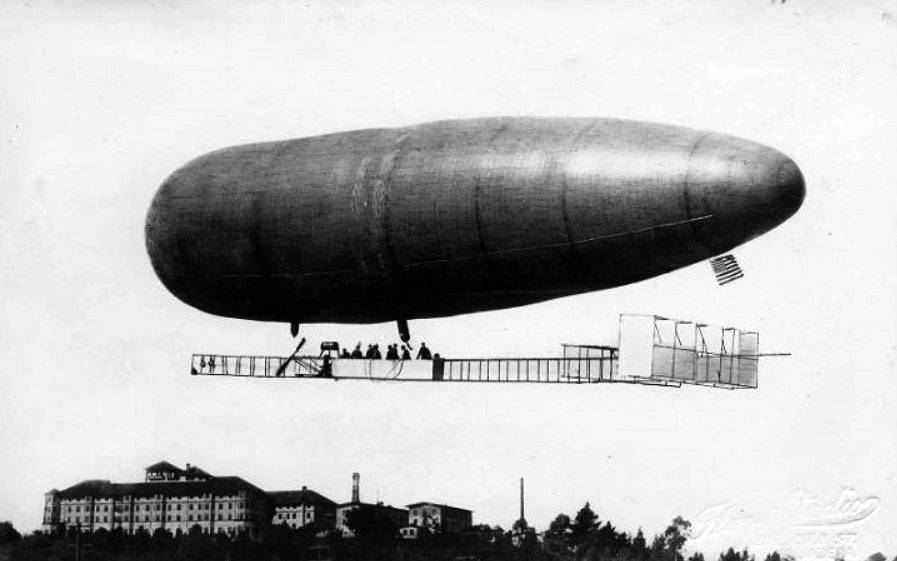 |
|
| (1913)* - Roy Knabenshue flying his 13-passenger dirigible over the Raymond Hotel. He offered aerial tours of the City of Pasadena. |
Historical Notes Roy Knabenshue was the first to make a dirigible balloon flight over the skyscrapers of New York back in 1905, one year after his original lighter-than- air powered flight at the St. Louis Exposition. After several years of barnstorming and a stretch as general manager for the Wright Brothers, he went west and built a 13-passenger airship in Pasadena for passenger flights. Click HERE to see more of Drigible Flights at the Raymond Hotel. |
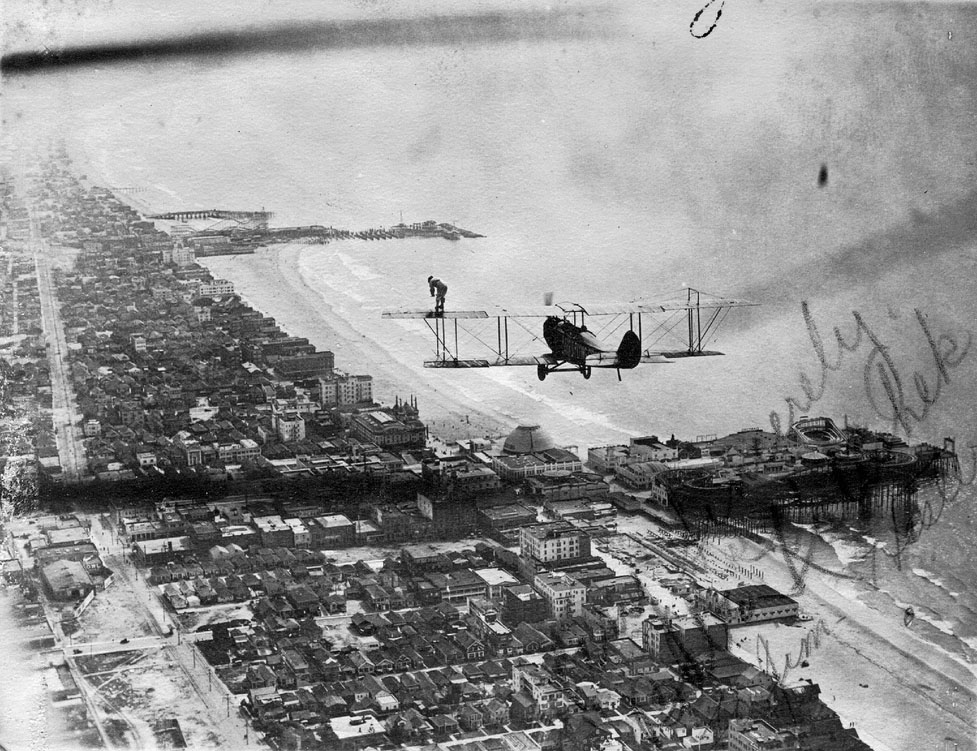 |
|
| (1918)* - Walking over Santa Monica. Aerial view of a bi-plane flying over Santa Monica. A woman is standing on the wing looking down. Ocean Park Pier with its amusement park appears just below the plane and Venice Pier is seen in the distance. Click HERE to see more in Early Southern California Amusement Parks. |
Historical Notes The above photo was taken August 14th, 1918. The wing walker was the fabulous and seriously talented Babe Kalishek. The Curtiss JN is piloted by the early ace aviator Jim Hester. |
 |
|
| (1924)* - Stuntman of the Flying Black Cats flys behind a plane on a tow line. |
Historical Notes Roy Knabenshue was the first to make a dirigible balloon flight over the skyscrapers of New York back in 1905, one year after his original lighter-than- air powered flight at the St. Louis Exposition. After several years of barnstorming and a stretch as general manager for the Wright Brothers, he went west and built a 13-passenger airship in Pasadena for passenger flights. Click HERE to see more of Drigible Flights at the Raymond Hotel. |
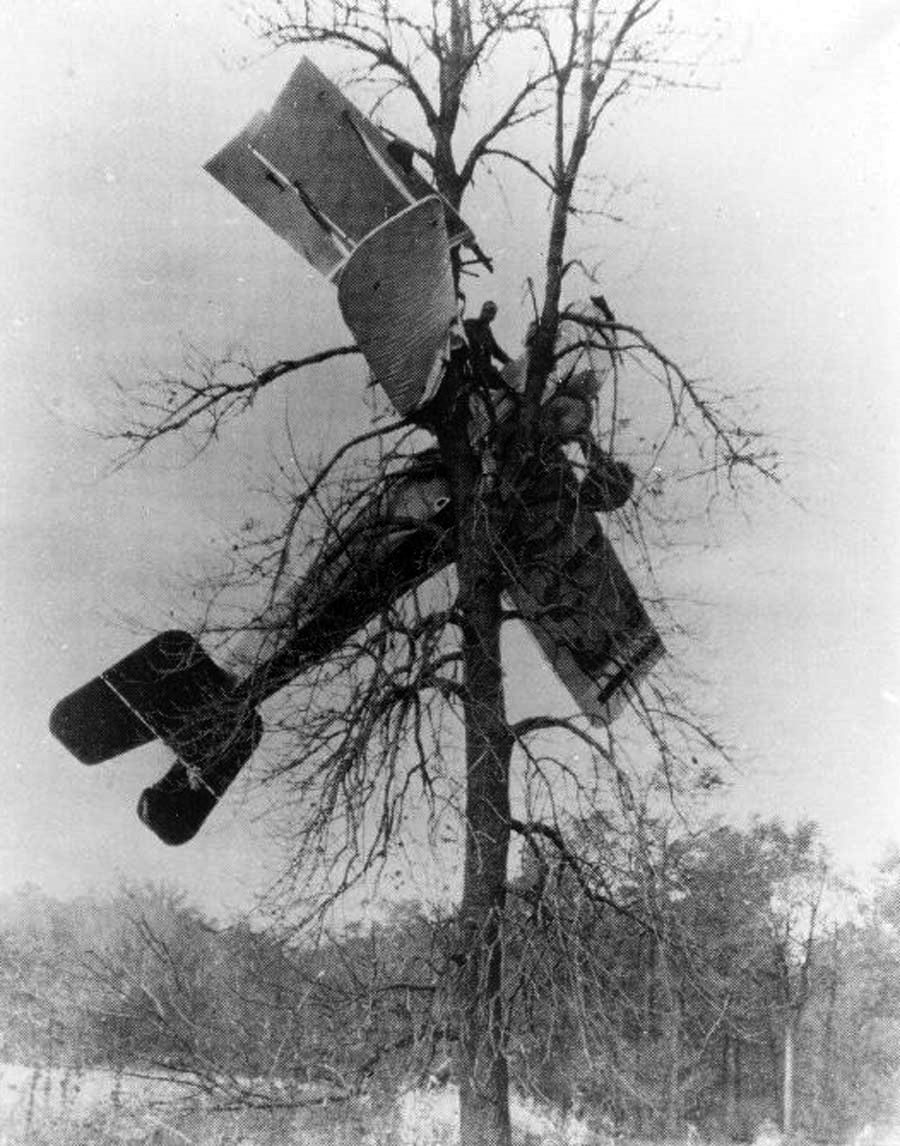 |
|
| (1920s)* - It could have been a whole lot worse! Black Cats stunt plane tangles up with a tree. Miraculously, the pilot looks alright. |
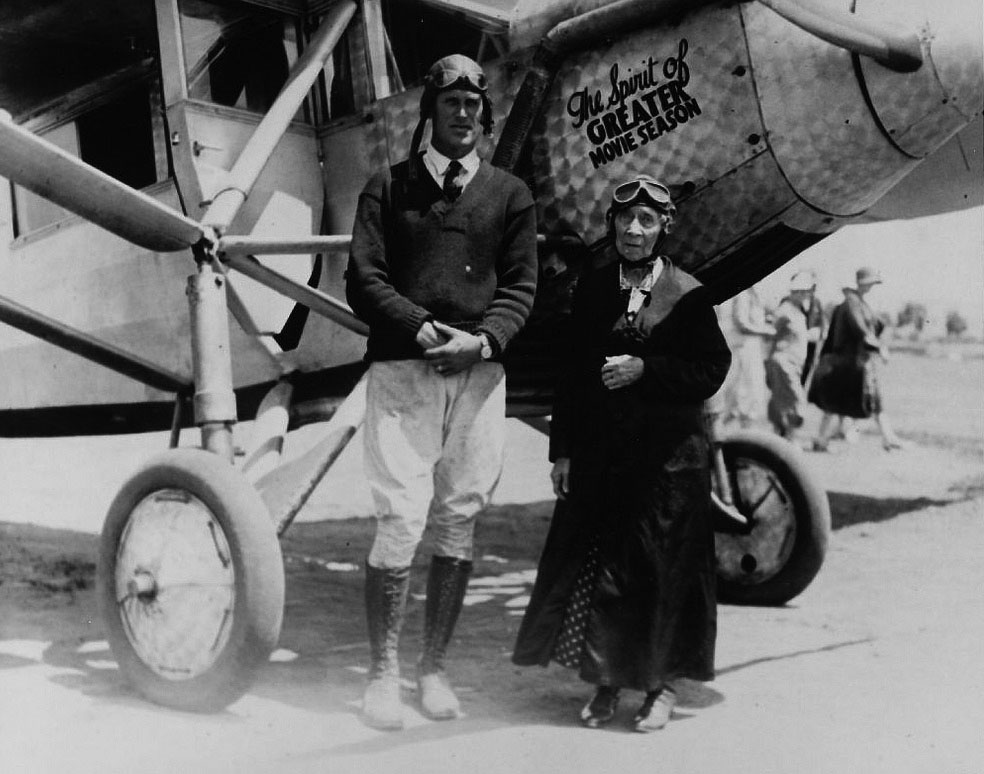 |
|
| (1927)* - You're never too old to fly! |
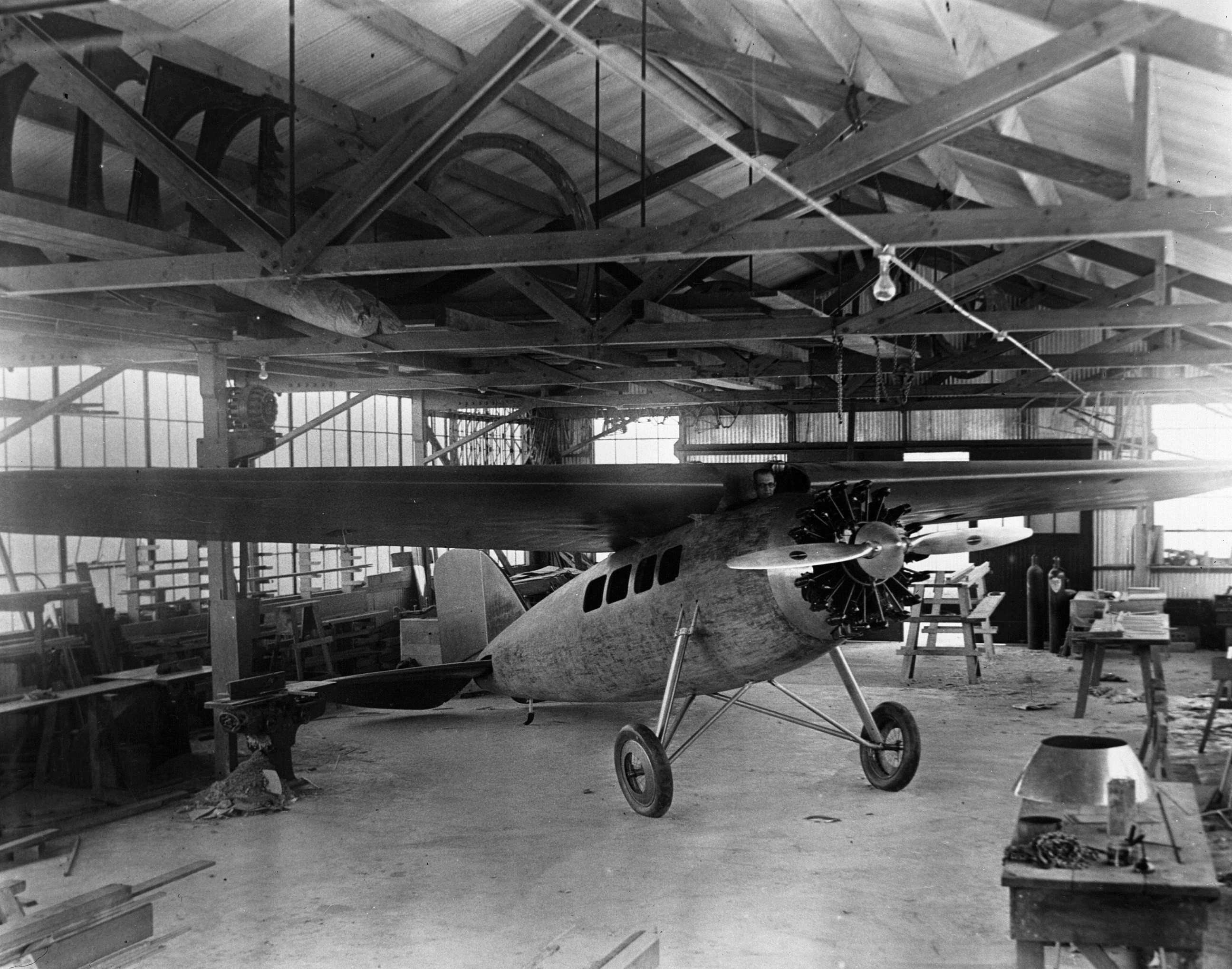 |
|
| (1927)* - The first Vega 1, NX913, Golden Eagle, nears completion at the Lockheed Aircraft Company, Hollywood. |
Historical Notes Twenty-eight Vega 1 airplanes were built by Lockheed Aircraft Company at the factory on Sycamore Street in Hollywood before production of the improved Lockheed Vega 5 began in 1928 and the company moved to its new location at Burbank, California. |
 |
(1927)* – On July 4, 1927 the first Lockheed Aircraft Company Vega 1, NX913, Golden Eagle, made its maiden flight with test pilot Edward Antoine (Eddie) Bellande at Rogers Airport (The airport was at the present location of Wilshire Boulevard and Fairfax Avenue). |
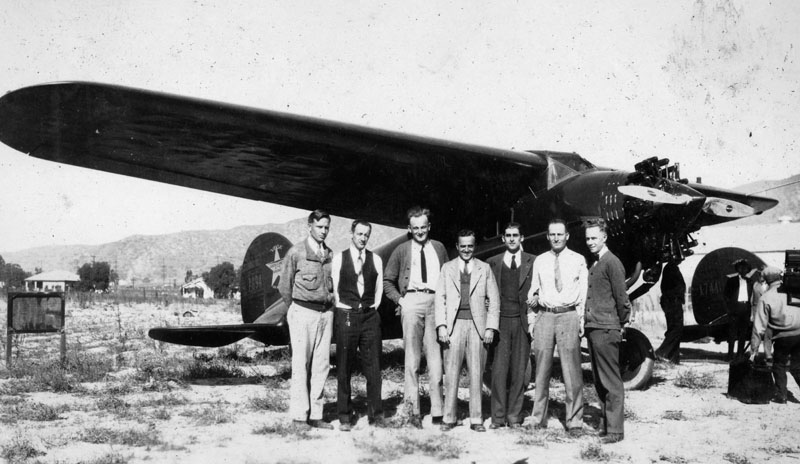 |
|
| (1928)* - Seven men, identified as the "old gang", stand next to a plane at the Lockheed plant in Hollywood. From left to right: Frank Crane, Jimmy Gerschler, Dan Egger, Jerry Vultee, Dick Von Hake and Vard Wallace. |
Historical Notes COriginally called the Alco Hydro-Aeroplane Company, Lockheed was founded in 1912 by brothers Malcolm and Allan Loughead. Its next incarnation was Loughead Aircraft Manufacturing Company and was located in Santa Barbara. In 1926, following the failure of Loughead, Allan Loughead formed the Lockheed Aircraft Company in Hollywood. The Great Depression greatly changed the aircraft industry and in 1934, Robert E. Gross was named chairman of the new company, the Lockheed Corporation, which had relocated to Union Airport (Bob Hope Airport) in Burbank, California. |
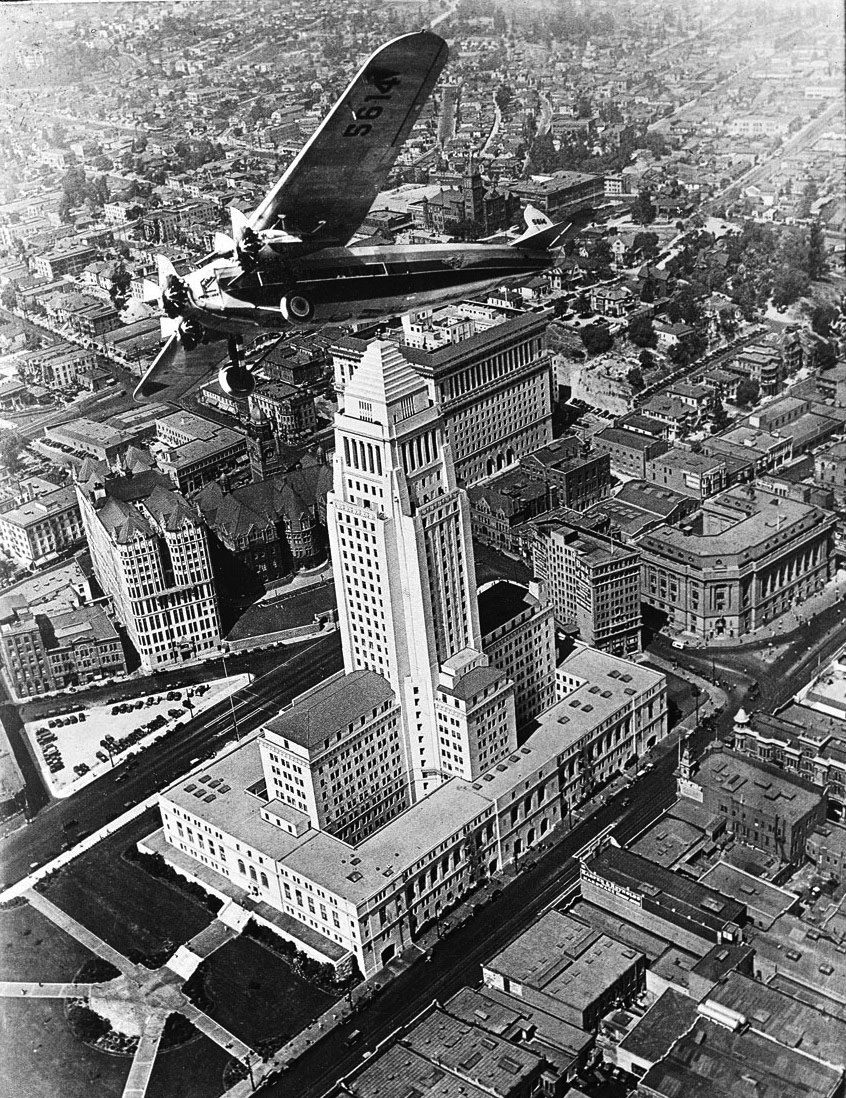 |
|
| (ca. 1929)* - View of a Fokker F.10 buzzing over City Hall circa 1929. |
Historical Notes The Fokker F.10 was first used by Richfield Oil (they had 2 F.10's) and later by Northern Airlines. It was destroyed on June 25th 1930 due to a hangar fire at Chicago. |
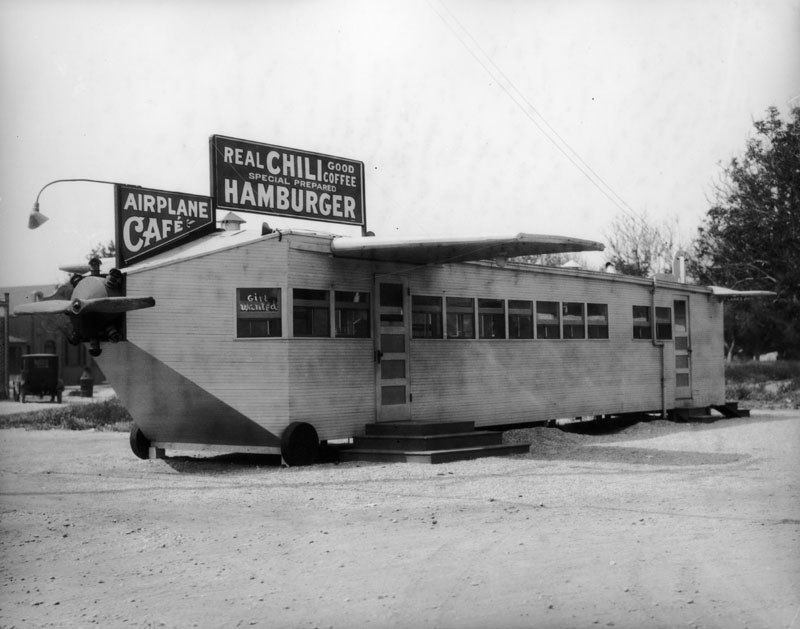 |
|
| (ca. 1924)* - View of the Airplane Café, a restaurant in the shape of a plane, complete with wings and a propeller. The structure has wheels, but rests on raised slabs of wood. The sign on roof reads: REAL CHILI - GOOD COFFEE - SPECIAL PREPARED HAMBURGER. |
Historical Notes In the 1920s, as the automobile was becoming the default way to get around the Southland, buildings and structures in the area became more unique, often resembling the merchandise or services they hawked. These “hey-you-can’t miss-me!” buildings (referred to as Novelty or Programmatic Architecture) were made to pull automobile drivers right off the road. |
.jpg) |
|
| (ca. 1924)* - Front end view of the Airplane Cafe (address unknown). The sign in the window reads: “Girl Wanted”. |
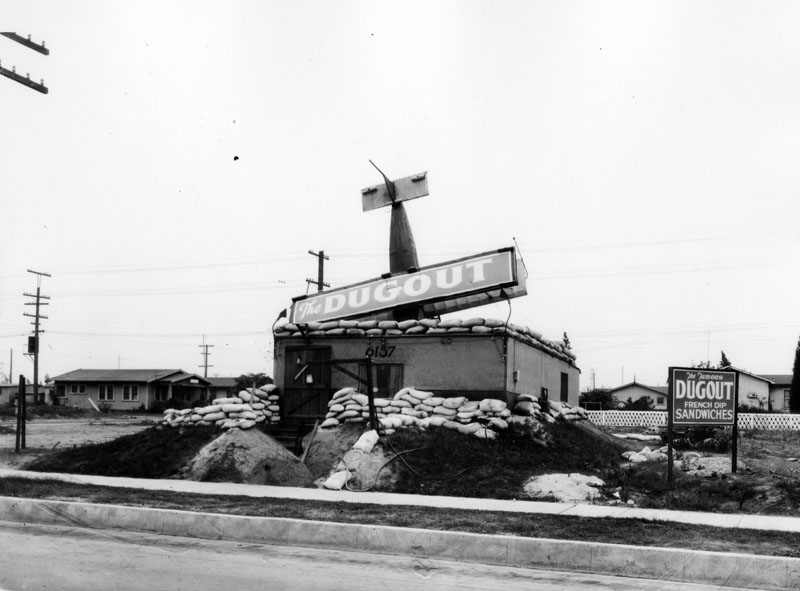 |
|
| (1929)* - "The Dugout" sandwich stand, which is surrounded by sandbags and has a plane crashed into its roof, located at 6157 E. Whittier Blvd. A sign outside reads: "The famous Dugout French dip sandwiches". |
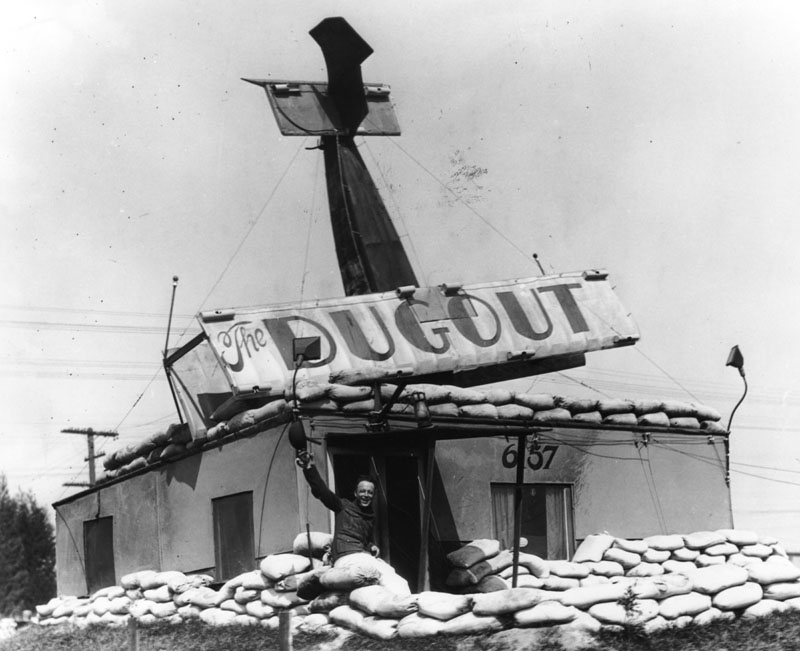 |
|
| (1920s)* - Close-up view of "The Dugout" showing a man in a soldier's uniform waving from behind sandbags in front of the restaurant. |
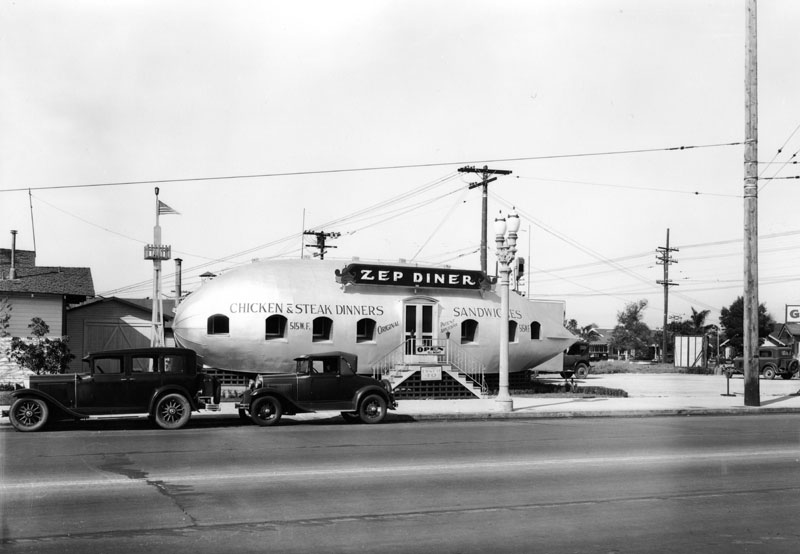 |
|
| (1931)* - View of Zep Diner, located at 515 W. Florence Ave, near Figueroa St. A sign hanging from the stairs advertises lunch for .40 cents. The Zep was open “all night” and was the “Home of the Hinden Burger”. The location is now a McDonald’s parking lot. |
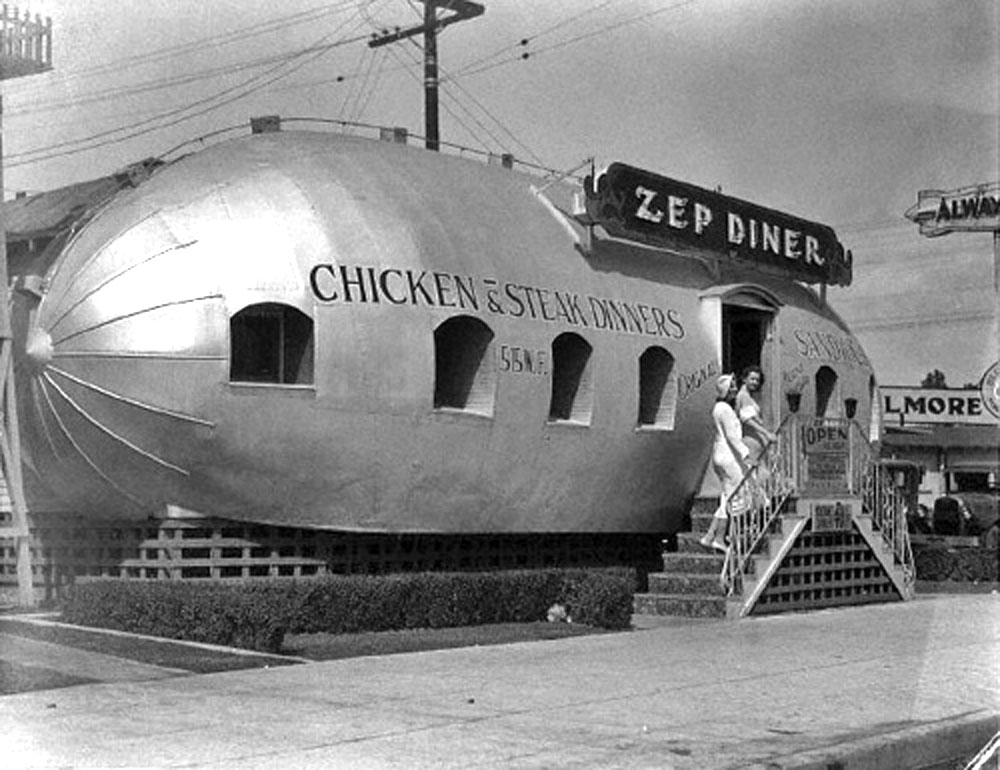 |
|
| (1931)#^^ - View of two women standing on the stairway leading to the entrance of Zen Diner. |
Historical Notes Click HERE to see more examples of Programmatic Architecture. |
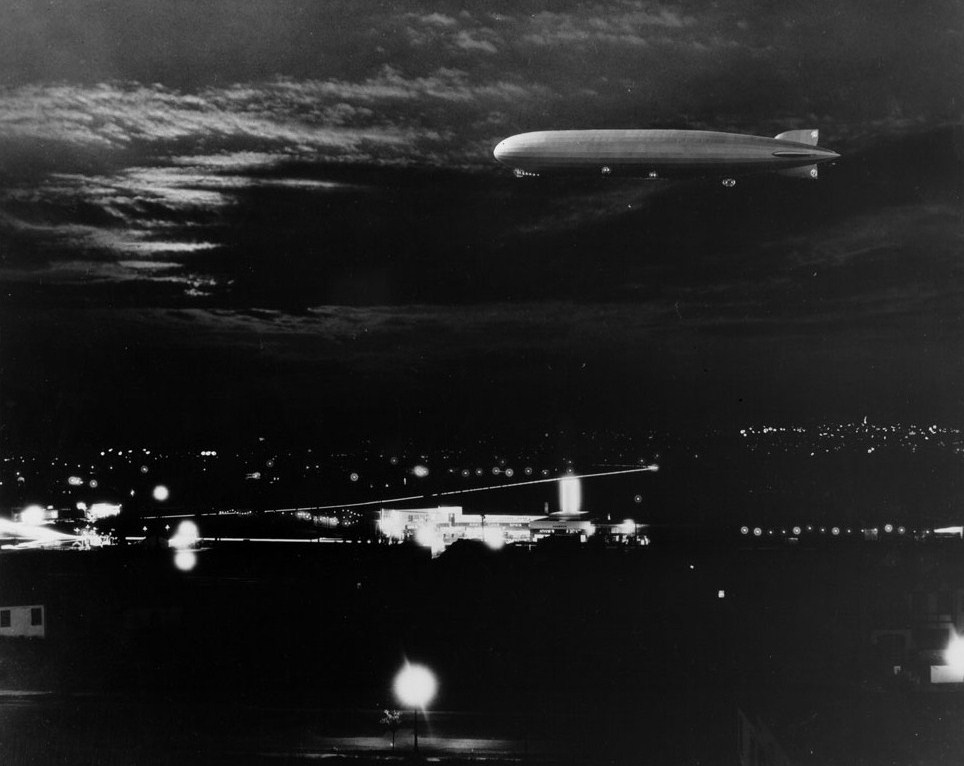 |
|
| (1929)^* - Graf Zeppelin over Leimert Park area of Los Angeles, August 1929. |
 |
|
| (1929)^* - Photograph of the Graf Zeppelin and the small Goodyear pony blimp floating (or parked?) next to each other, 1929. The Graf Zeppelin is about ten times the size of the Goodyear blimp. Both the blimps are on the other side of the fence in the foreground. Several warning signs are posted up including a no-parking sign. |
 |
|
| (1929)^ - Biplane Sunbeam gets refueled in flight during the first women's endurance record on Nov. 12, 1929. Aircraft piloted by Elinor Smith, with Bobbi Trout as copilot. |
Historical Notes On January 2, 1929, Evelyn "Bobbi" Trout flew out of Van Nuys Airport (Metropolitan, San Fernando Valley) and into aviation history, an historic flight that lasted 12 hours, 11 minutes, set the first women's record for an all-night flight and flew the aviatrix into the pantheon of aviation pioneers. Trout went on to set more world records, many of them from Van Nuys Airport.^ |
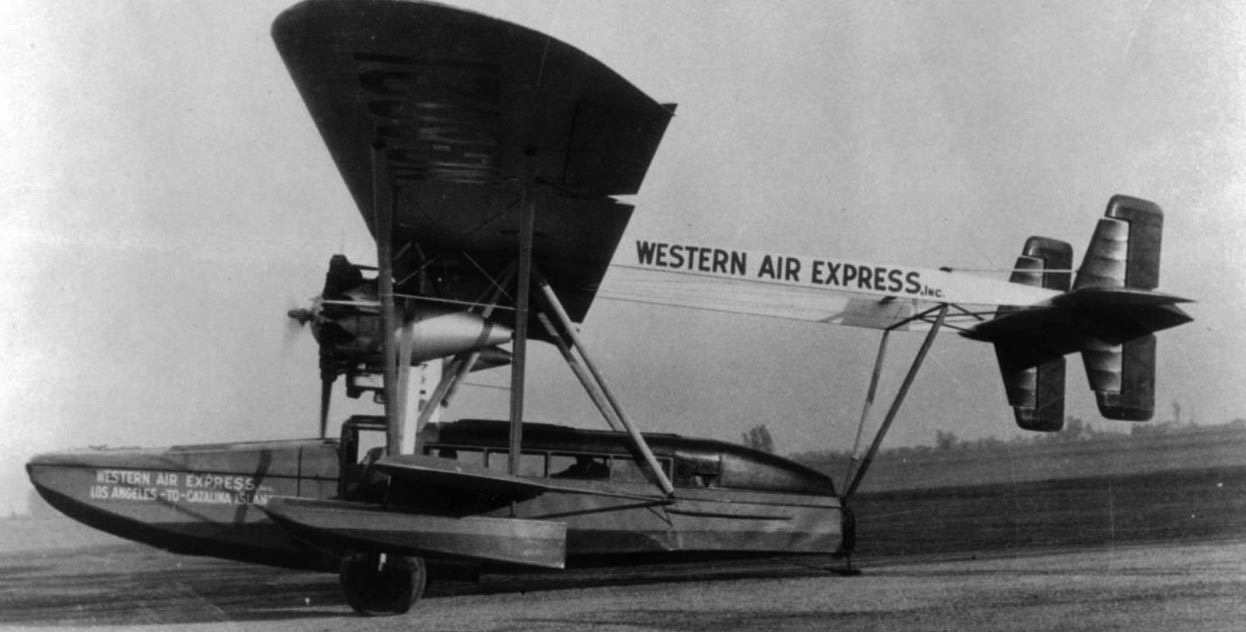 |
|
| (1930)#^ - View of a Western Air Express Sikorsky S-38A amphibious airplane, with lettering: "Western Air Express Inc., Los Angeles to Catalina Island." |
Historical Notes Upon acquiring Pacific Marine Airways, the first thing Corliss Moseley, COO of Western did was to augment the existing motley equipment by ordering a new Sikorsky S-38 amphibian. In 1931, Western Air Express’ contract to provide service to Catalina Island was not renewed by the Wrigley family (owners of the island) and the line and its assets were sold off to Wilmington-Catalina Airlines. ##+ The Sikorsky S-38 was an American twin-engined 8-seat sesquiplane amphibious aircraft. It was sometimes called "The Explorer's Air Yacht" and was Sikorsky's first widely produced amphibious flying boat which in addition to serving successfully for Pan American Airways and the U.S. Army, also had numerous private owners who received notoriety for their exploits. A total of 101 aircraft were built.*^ |
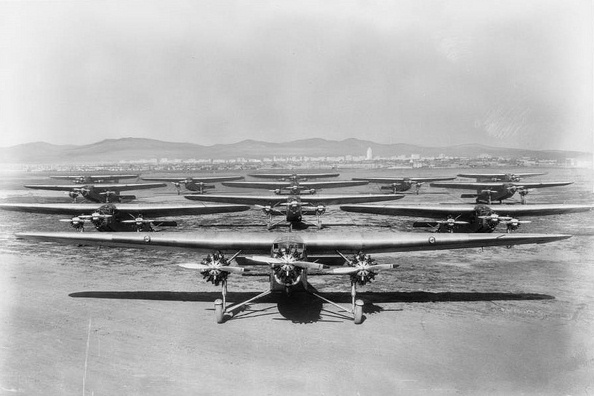 |
|
| (1929)^*# - View of the Maddux Airlines fleet at Mines Field. |
Historical Notes By mid 1929, Jack Maddux had 16 Tri-motors (the largest fleet of Fords in service) and two smaller planes which he used for private charter. Business was booming but the risks were great and he was unable to obtain an airmail contract from the government. To get the government's support, Jack merged the airline with Transcontinental Air Transport on November 16, 1929. It occurred just fifteen days after the October 29, 1929 stock market crash. At first, they called the new venture TAT-Maddux. Eight months later on July 19, 1930, TAT-Maddux merged with another local West Coast air carrier, competitor Western Air Express. The Maddux name was discarded at this time and the carriers actually did fly under their own names even though they were then associated. Jack did win a seat on the corporate board but he did not, apparently, have a major say in the new airline's operation, which became known as Trans Continental and Western Airlines (T&WA). Eventually, T&WA became Trans World Airlines.^ Among the famous aviators who were involved with Maddux were Charles Lindbergh and Amelia Earhart. Maddux also had a publicity department that advertised the celebrities who flew with the airline. These included Will Rogers, who rode on the inaugural flight, and Hollywood actors Arthur Edmund Carewe and Dolores del Río.*^ |
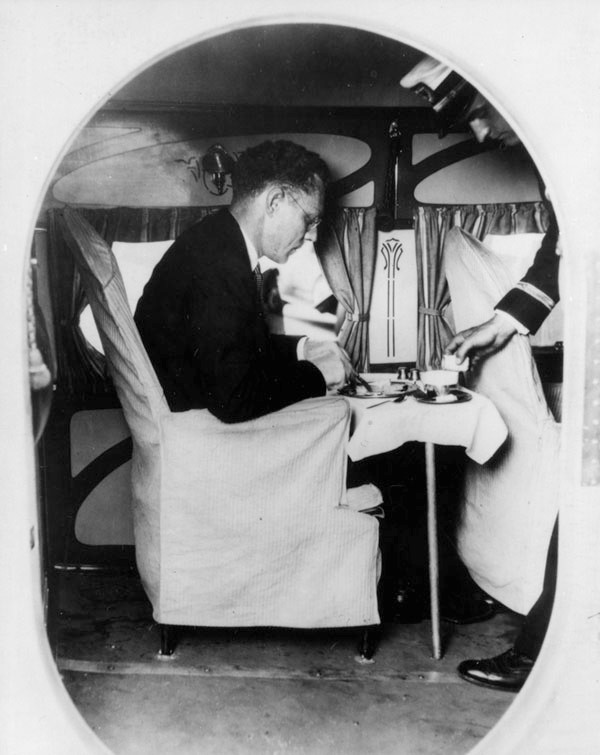 |
|
| (ca. 1929)* - Interior view of Maddux Airlines, showing a passenger eating a meal. |
Historical Notes Aviation circles on the web note two "Maddux Air" crashes, one in 1929, and another in 1930. There were others involving TAT and T&WA later. Crashes in those early days were not uncommon. Flying was new and the safety technology was virtually nonexistent then.^ |
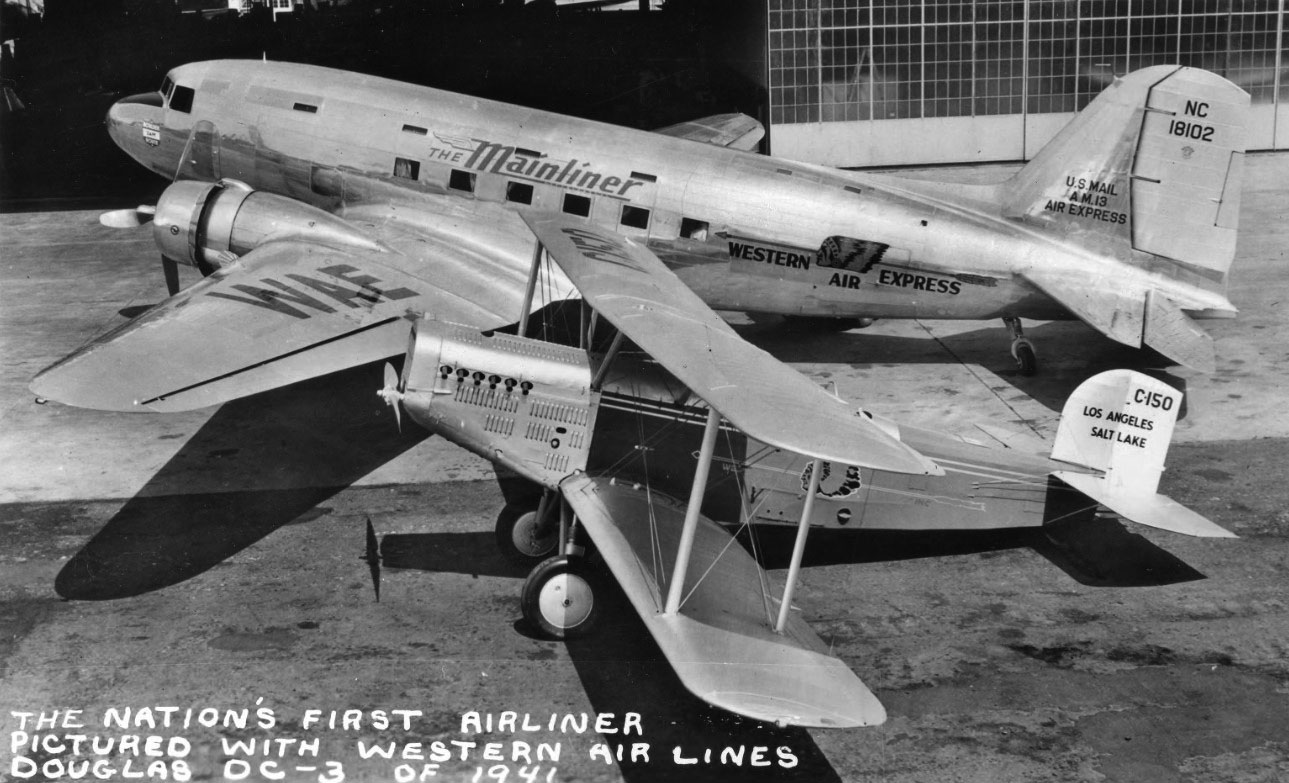 |
|
| (1941)***^ – Nation's First Airliner Pictured with Western Airlines Douglas DC-3 of 1941. |
Historical Notes The Douglas DC-3 was a fixed-wing propeller-driven airliner with tailwheel-type landing gear. Its cruise speed (207 mph) and range (1,500 mi) revolutionized air transport in the 1930s and 1940s. Its lasting effect on the airline industry and World War II makes it one of the most significant transport aircraft ever made. The DC-3 was a twin-engine metal monoplane, developed as a larger, improved 14-bed sleeper version of the Douglas DC-2. It had many exceptional qualities compared to previous aircraft. It was fast, had a good range and could operate from short runways. It was reliable and easy to maintain and carried passengers in greater comfort. Before the war, it pioneered many air travel routes. It was able to cross the continental United States, making transcontinental flights and worldwide flights possible, and is considered the first airliner that could make money by carrying passengers alone.*^ |
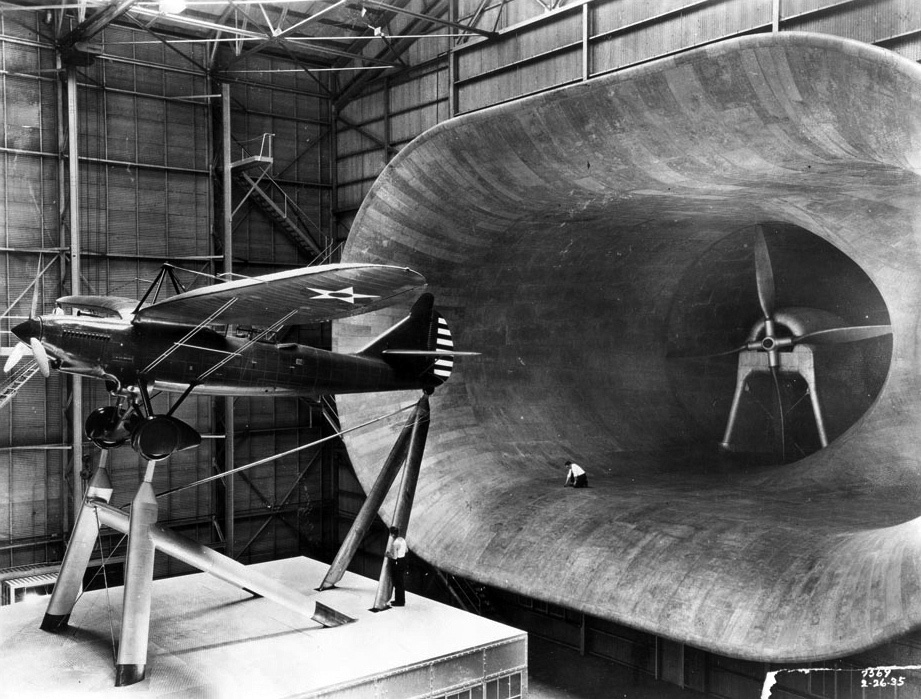 |
|
| (ca. 1930)^* - Photograph of aircraft next to large-scale wind tunnel. To the left, a large darkly-colored aircraft is visible. The aircraft is seen supported from its tires and tail by four immense metal poles on a platform. A man is seen standing next to a single pole beneath the plane. To the right of the plane in the background, an enormous wind tunnel is visible. The interior of the tunnel appears smooth, and the edges of the tunnel point concave outwards. A large steel propeller sits at the end of the tunnel. A man is also seen kneeling within the tunnel. In the extreme background, metallic structures and stairwells are visible. |
 |
|
| (1931)* - A Travel Air "Mystery Ship" belonging to Florence Lowe "Pancho" Barnes (1901-1975) shown at Union Airport (Bob Hope Airport) in Burbank. |
Historical Notes In 1929, the first sleek little black and red Model-R mono-plane was flown to Cleveland from Wichita just before the National Air Races and was immediately placed in a hangar and covered with a canvas tarp. This secrecy of the plane's identity resulted in it being nicknamed the "Mystery Ship." "Pancho" Barnes, grand-daughter of Thaddeus S. C. Lowe of Mount Lowe fame, was a pioneer of women's aviation and the owner of the celebrated Happy Bottom Riding Club located in the Antelope Valley. After her death, her Mystery Ship shown here was stored in a hangar at Mojave Airport, but was later sold to a private collector and is currently in the United Kingdom waiting to be restored.* |
 |
|
| (1931)^* - Transferring mail from an ocean liner to the Goodyear Blimp in the Los Angeles Harbor. |
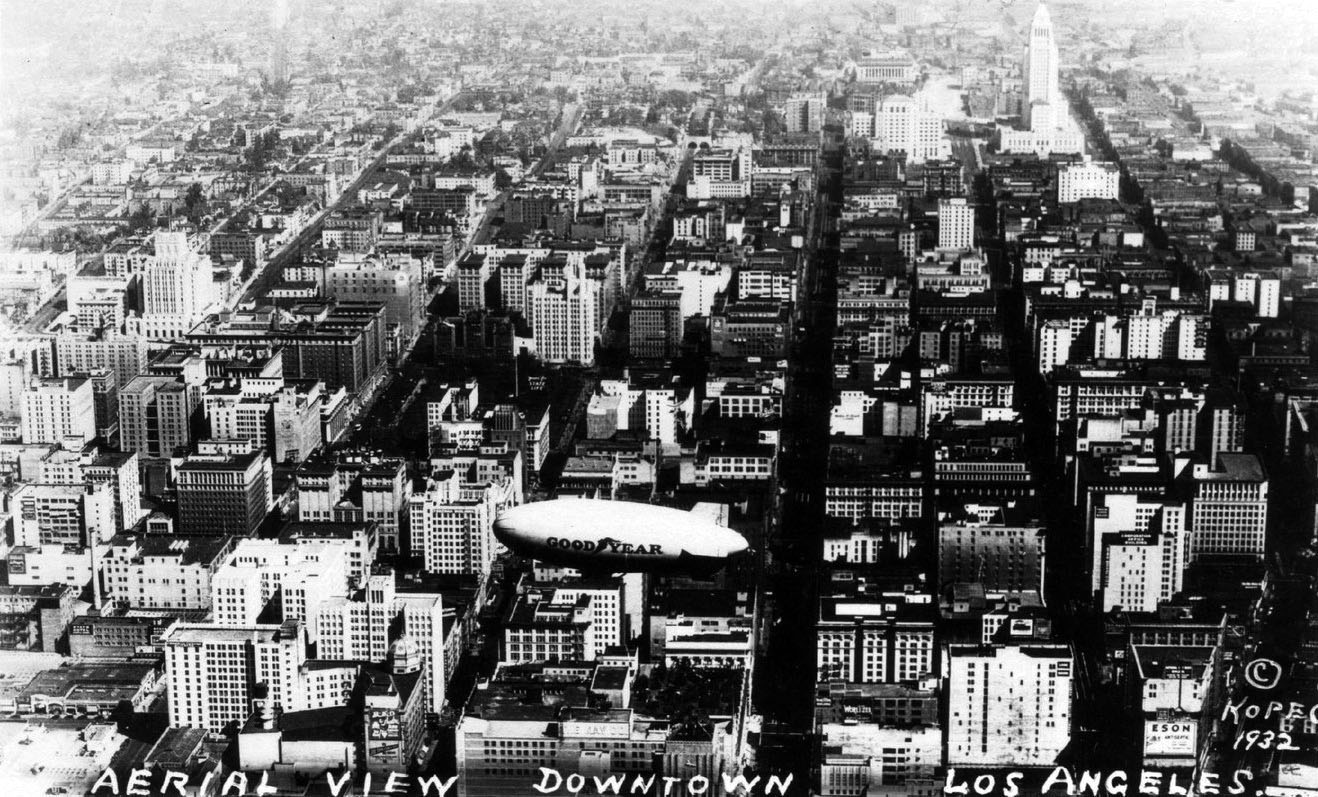 |
|
| (1932)^*# - Aerial view looking north up Broadway. The Goodyear blimp is hovering over downtown Los Angeles and City Hall is seen in the distance. |
 |
|
| (ca. 1930s)^* - Aerial view directly over the Automobile Club of Southern California building on Figueroa St. in Los Angeles. Signs are painted on the building's roof indicating direction and distances to nearest airports. |
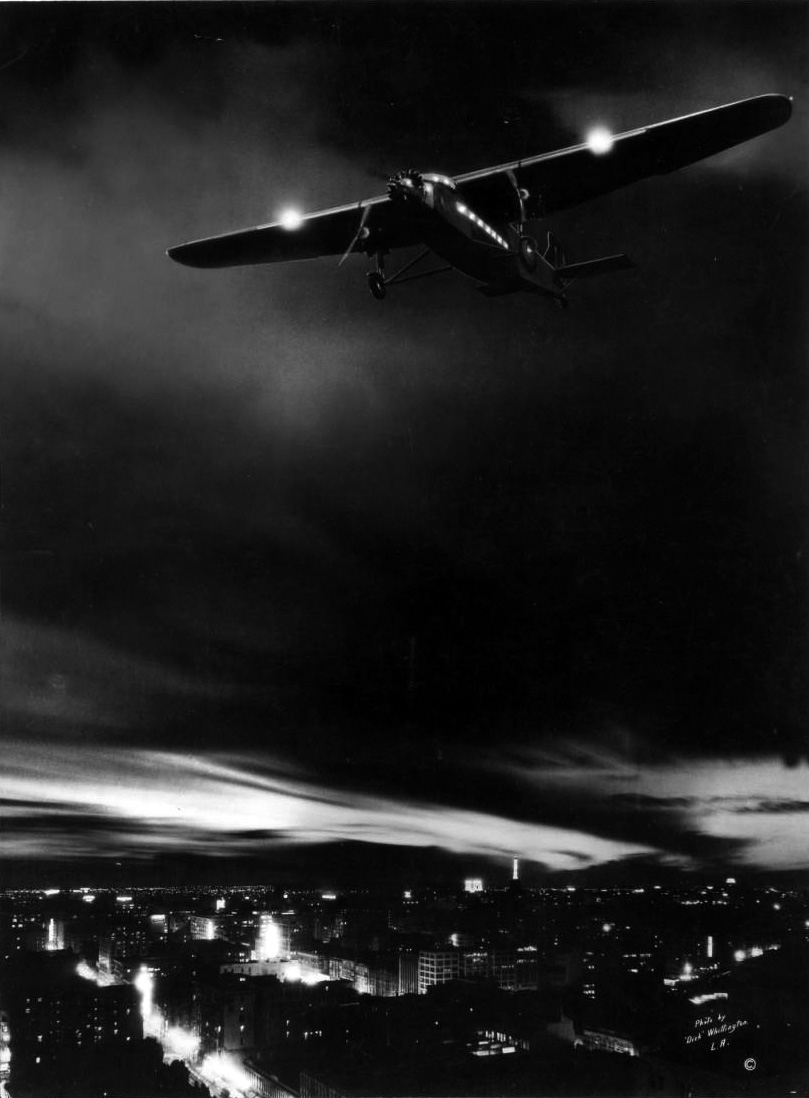 |
|
| (ca. 1935)^* - Composite photo of a small commercial airliner flying at night over the city. Photo by “Dick” Whittington. |
 |
|
| (1935)^**^ – View looking east on Wilshire Boulevard at Cochran Avenue. An airplane (Fokker F-32) seems to be parked on the corner lot. Sign on the wings reads: BOB'S AIRMAIL SERVICE |
Historical Notes Bob’s Air Mail Service utilized a real twin-prop airplane to top its station, with the wings serving as canopies to shade its General Petroleum pumps. The plane was one of two Fokker F-32 aircraft operated by Western Air Express, circa 1930-31. The four engine F-32 was a design failure due to overheating of the two pusher engines and was only briefly in commercial service. |
 |
|
| (1936)^*^ - You could gas up your car beneath the wings of a grounded airplane at Bob’s Air Mail Service Station on the n/w corner of Wilshire Blvd. and Cochran Ave. |
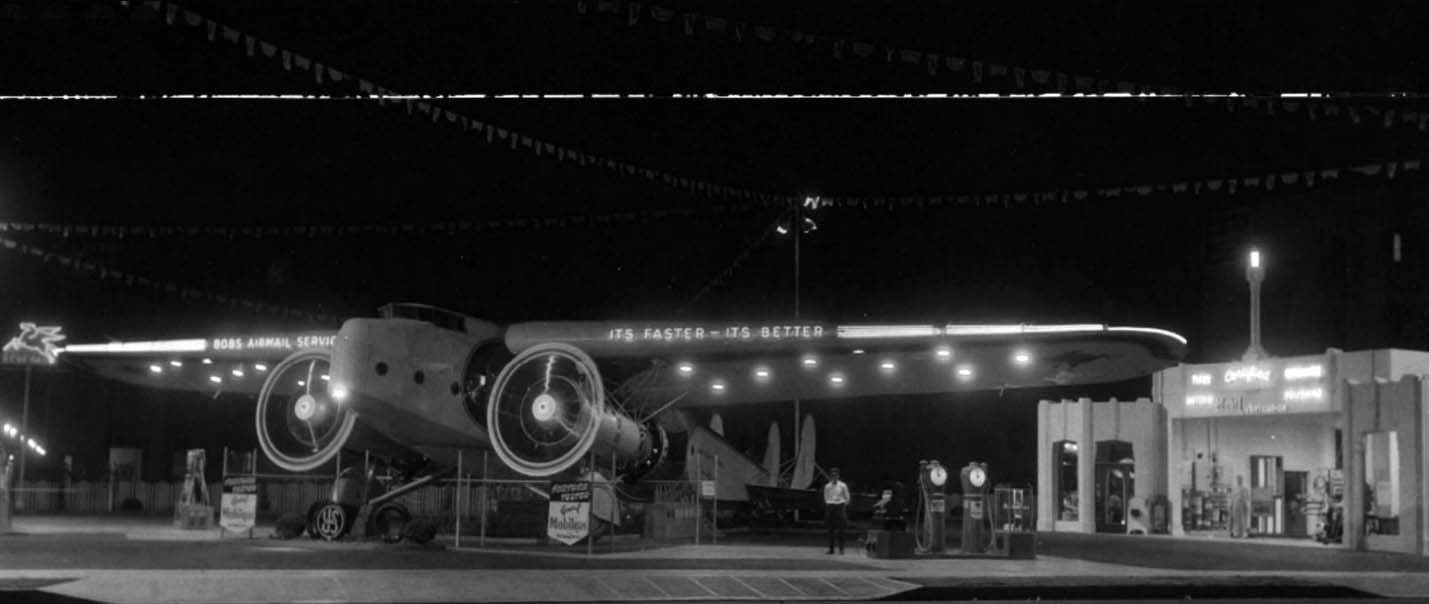 |
|
| (ca. 1938)#^ – Night view showing a man standing in between a Fokker F-32 aircraft with spinning propellers and the gas pumps at Bob's Airmail Service on Wilshire. |
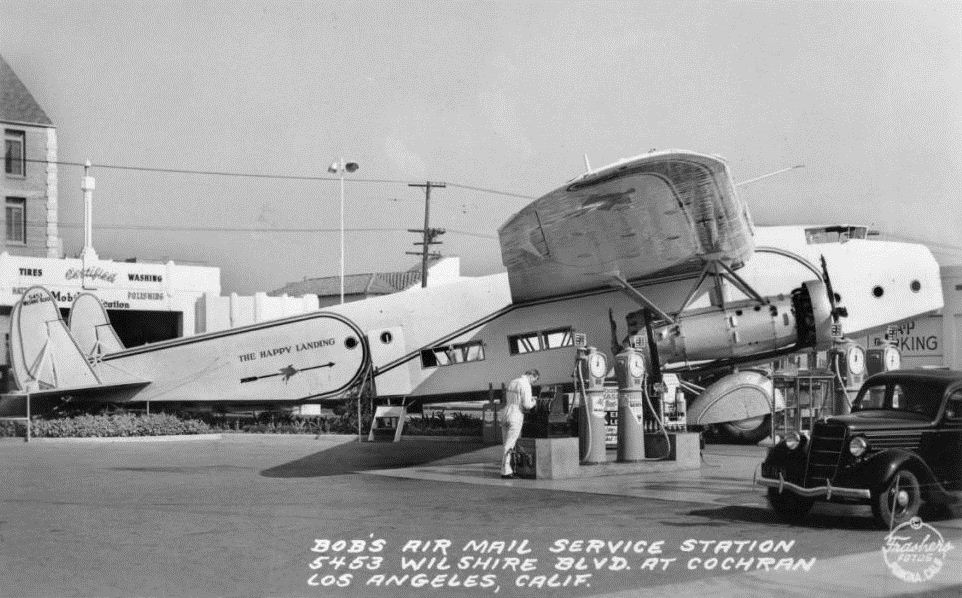 |
|
| (1936)***^ - Another view of Bob's Airmail Service Station at 5453 Wilshire Boulevard. |
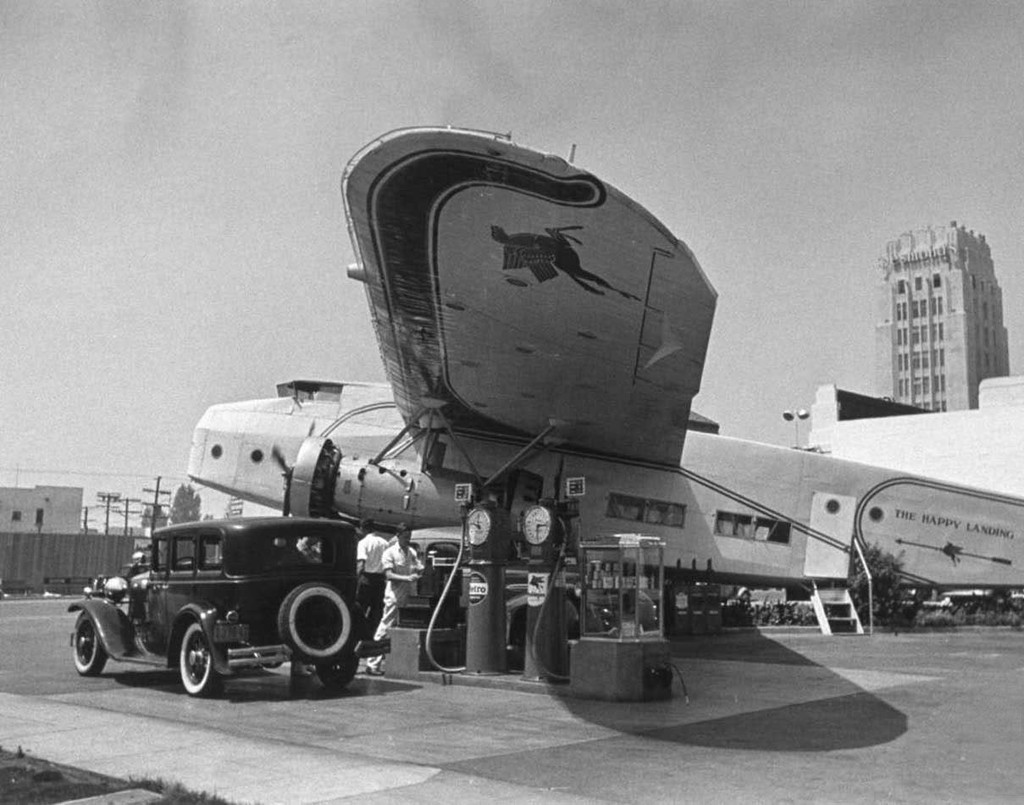 |
|
| (ca. 1936)^*# - Bob's Airmail Service Station on Wilshire. It almost appears as if the plane's propellers are moving. In the background can be seen the Wilshire Tower with the name Desmonds just visible on the top. Click HERE to see more Early Views of LA Gas Stations. |
Flying Wing
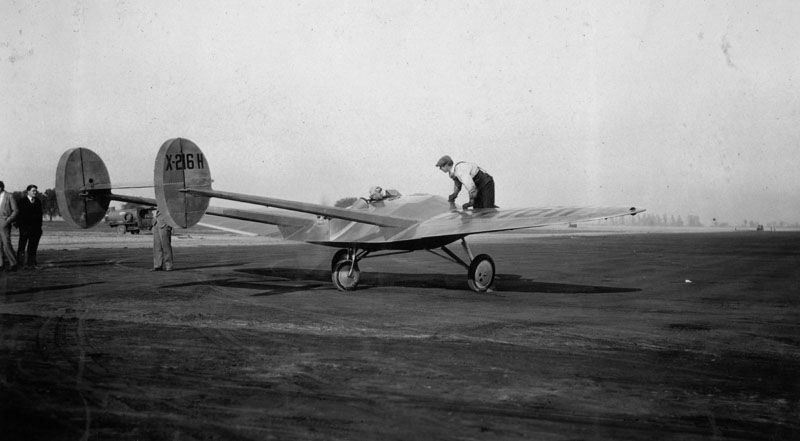 |
|
| (1929)* - The Northrop "Flight Wing" X-216H at United Airport (Bob Hope Airport) in Burbank |
Historical Notes Jack Northrop, who designed the plane, felt that going with an all-wing aircraft would significantly increase overall performance. By 1929 he had produced the X-216H which, while it still used a small twin-boom tail, included a more refined wing and became the first successful example of an all-wing plane.* |
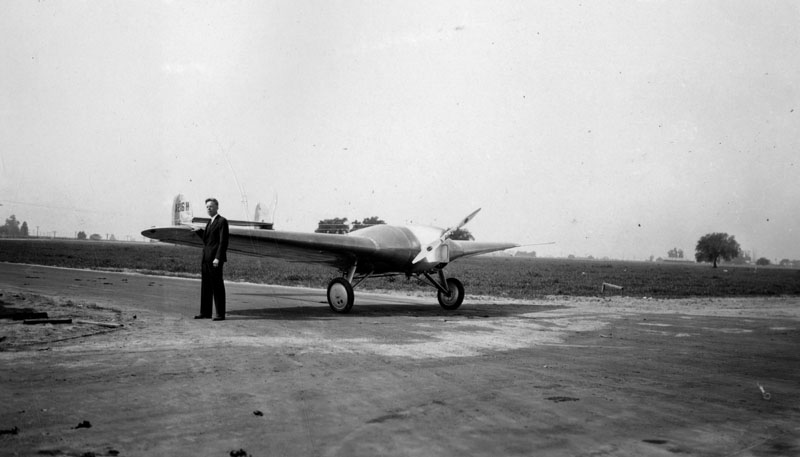 |
|
| (1930)* - Jack Northrop stands next to his "Flight Wing" X-216H at United Airport in Burbank. |
Historical Notes John Knudsen "Jack" Northrop (1895-1981) was an American aircraft industrialist and designer, who founded the Northrop Corporation in 1939.*^ |
 |
|
| (1929) - Northrop Aircraft Co. founder Jack Northrop, right, and pilot Edward Bellande in 1929 with the original "flying wing," a design that evolved into the B-2 stealth bomber decades later |
Historical Notes Jack Northrop's career began in 1916 as a draftsman for Loughead Aircraft Manufacturing Company. He joined the Douglas Aircraft Company in 1923, where in time he became a project engineer. In 1927 he rejoined Lockheed, where he was a chief engineer on the Lockheed Vega transport. He left in 1929 to found Avion Corporation, which he sold in 1930. Two years later he founded the Northrop Corporation. This firm became a subsidiary of Douglas Aircraft in 1939, so he co-founded a second company named Northrop.*^ |
 |
|
| (1946)#** - Northrop's Flying Wing Bomber known as the XB-35 in flight in 1946. The XB-35 was an experimental heavy bomber developed for the U.S. Army Air Force during World War II. |
Historical Notes The Northrop XB-35 and YB-35 were experimental heavy bomber aircraft developed by the Northrop Corporation for the United States Army Air Forces during and shortly after World War II. The airplane used the radical and potentially very efficient flying wing design, in which the tail section and fuselage are eliminated and all payload is carried in a thick wing. Only prototype and pre-production aircraft were built, although interest remained strong enough to warrant further development of the design as a jet bomber, under the designation YB-49.*^ |
 |
|
| (1946)*** - View of the YB-35 prototype, considered to be the "Grandpa" of the B-2 Bomber. It was designed by Jack Northrop and had its first flight on June 25, 1946. |
 |
|
| (1947)** - Head on view of Northrop Flying Wing (YB-49) powered by eight jet engines. Photo taken on aircraft's introduction to the public and media. This photo, a panorama made with three prints, was published in the Sep. 30, 1947 Los Angeles Times |
Historical Notes The Northrop YB-49 was a prototype jet-powered heavy bomber aircraft developed by Northrop shortly after World War II. Intended for service with the U.S. Air Force, the YB-49 featured a flying wing design. It was a jet-powered development of the earlier, piston-engined Northrop XB-35 and YB-35; the two YB-49s actually built were both converted YB-35 test aircraft.^#^ |
 |
|
| (1947)**- Visitors take a close-up look at the Northrop YB-49 Flying Wing during its unveiling. |
Historical Notes The jet engines are mounted in fours, with the black-mouthed exhaust ports jutting from the training edge like stub-barreled cannon. And flanking both engine banks are four vertical fins, or air separators, to give the giant air ship the same directional stability afforded by the whirling propellers of the original Flying Wing. |
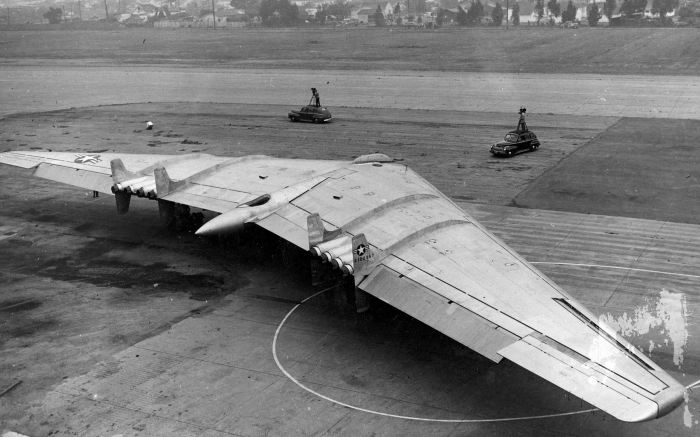 |
|
| (1947)^#^ - Two camera crews with photographers standing on top of their cars take photos during the unveiling of the new Northrop YB-49 Bomber. |
Historical Notes Patterned after the conventionally powered B-35 Flying Wing, the huge silver boomerang was powered with eight J-35 turbo-jet engines developing (in thrust) the equivalent of 32,000 h.p. at a sea level 375 m.p.h. |
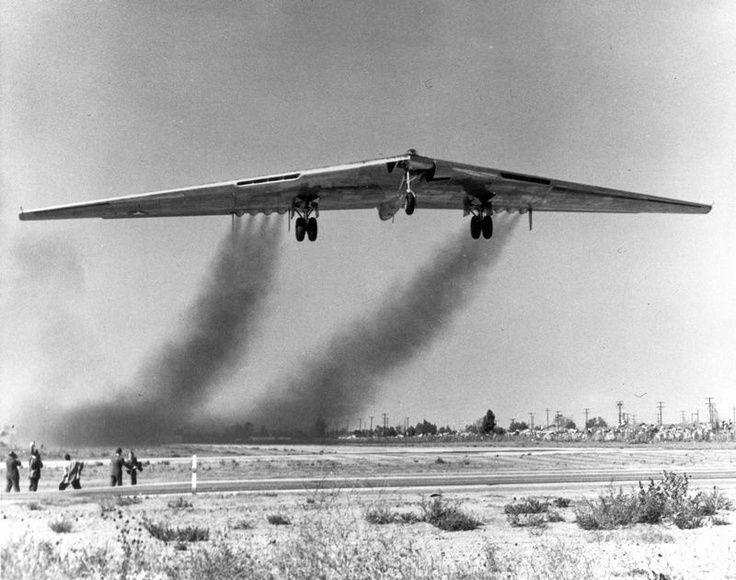 |
|
| (1947)*** - YB-49 Flying wing, a heavy bomber prototype, takes to the air for the first time in 1947. |
Historical Notes The YB-49 never entered production, being passed over in favor of the more conventional Convair B-36 Peacemaker piston-driven design. Design work performed in the development of the YB-35 and YB-49 nonetheless proved to be valuable to Northrop in the eventual development of the current day B-2 Spirit strategic bomber which first entered operational service in the 1990s.^#^ |
_1947.jpg) |
|
| (1947)^#^ - A Northrop YB-49 Bomber on its test flight over the desert. |
Historical Notes Paramount Studios' 1953 film, The War of the Worlds incorporates Northrop color footage of a YB-49 test flight, originally used in Paramount's Popular Science theatrical shorts of the era; in the George Pal film the Flying Wing is used to drop an atomic bomb on the invading Martians.^#^ |
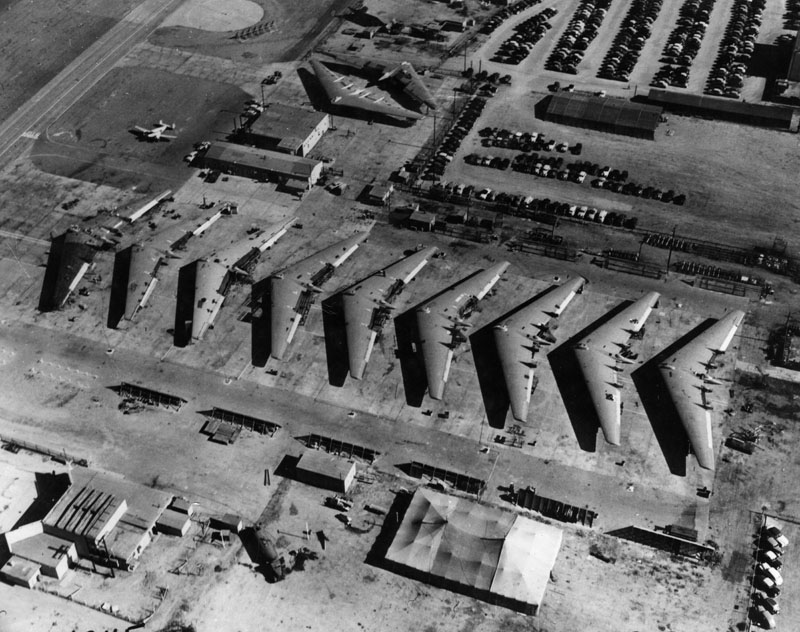 |
|
| (1949)* - Aerial view of Flying Wing planes, the Northrop XB-35, at the Northrop plant in Hawthorne. |
Historical Notes In the end, the program was terminated due to its technical difficulties, the obsolescence of its reciprocating propeller engines, and the program being far behind schedule and over budget. Another contributing factor to the program's failure was the tendency of Northrop to become engaged in many experimental programs, which spread its small engineering staff far too wide. While the competing propeller-driven B-36 was obsolete by that time and had just as many or even more development problems, the Air Force needed a very long range, post-war atomic bomber to counter the perceived Soviet threat. It had more faith that the B-36's "teething" problems could be overcome, compared to those of the new and radical "Flying Wing", the unofficial name that was later associated with all the Northrop "all-wing" designs.*^ |
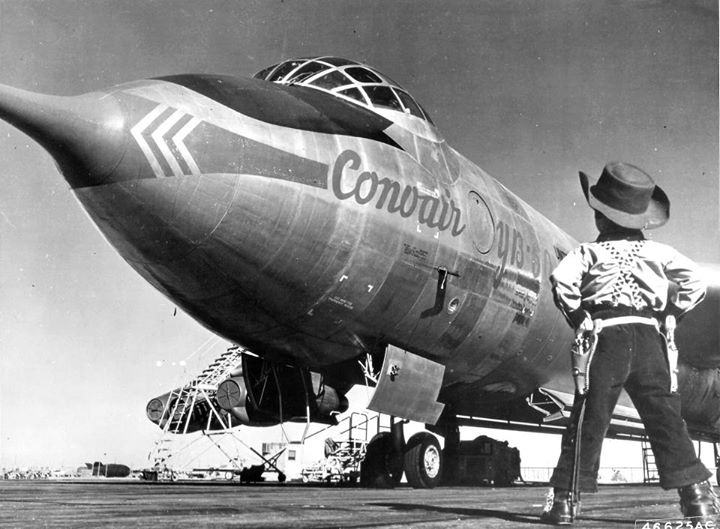 |
|
| (1953)^## - A young “cowboy”, the son of a member of the Air Force Flight Test Center, Edwards Air Force Base, California, looks over the Convair built YB-60 during its visit at Edwards from the Fort Worth, Texas, plant. |
Historical Notes The YB60 was a jet-powered prototype version of the Convair B-36 Peacemaker. Both planes – being integral to the defense of America during The Cold War – were designed to carry nuclear weapons. While the B-36 enjoyed a fairly long career (1946 to 1959), the YB60 never got past experimental stage.^## |
 |
|
| (ca. 1954)*# - View of the full-size mockup of the massive Hughes XH-28 helicopter, pictured inside the former Spruce Goose assembly hangar at Hughes Culver City, shown straddling a cargo platform carrying a truck. |
 |
|
| (1950s)#^^* – View of a one-man helicopter! This unique “go-anywhere vehicle” made by Rotor-craft for military personnel, made demonstration flights back in the 1950s at Van Nuys Airport. |
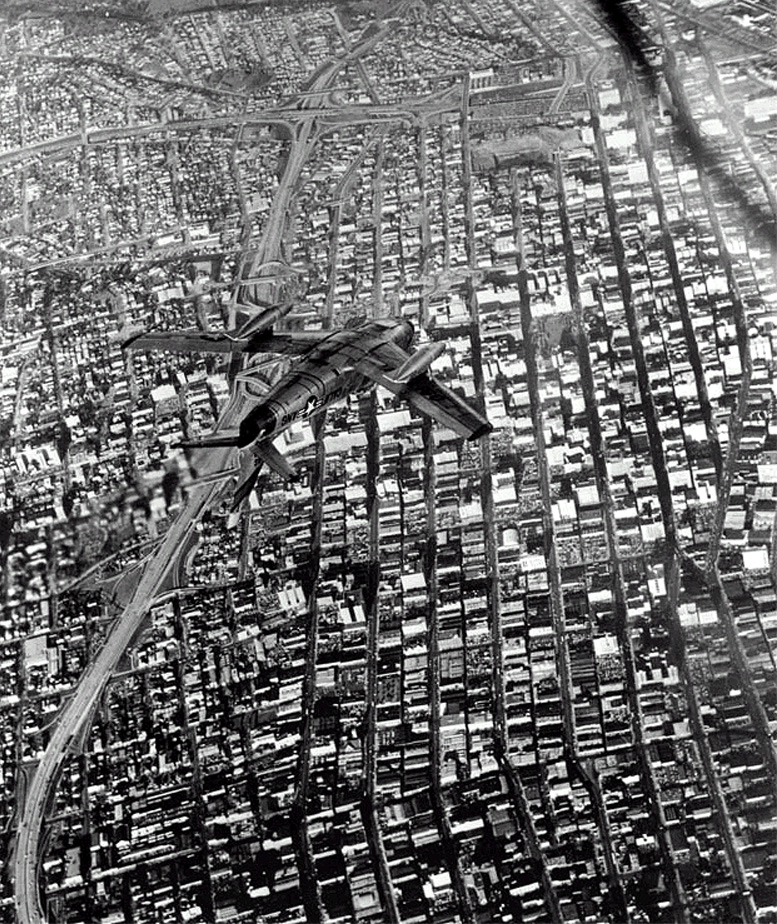 |
|
| (1954)* - Aerial view looking north of an upside down Air Force fighter plane flying over downtown Los Angeles. City Hall can faintly be seen in the upper right corner of the photo. |
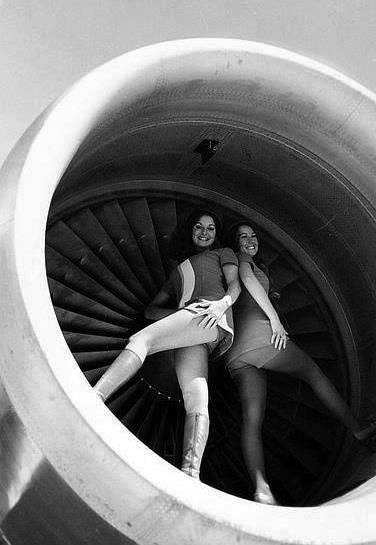 |
(ca. 1968)^.^ - Hot Engine Accessories. Stewardesses from Pacific Southwest Airlines pose in front of an L-1011 TriStar engine to promote their new uniforms of cotton-candy pink, tangelo red, and pumpkin orange; designed to match the colored stripes of PSA's "Smiling Aircrafts". |
|
Historical Notes The first stewardesses were actually nurses hired to make passengers feel safer. Women who wanted to be “sky girls” had to meet strict requirements. In addition to being single, they had to be under 25 years of age, under 5-feet-5 and under 116 pounds. Not only did they tend to passengers, they were also expected to haul luggage, fuel the plane and help pilots push the plane into the hanger after flights. "Stewardess" was replaced with the term: "flight attendant" in the 70s.* |
 |
(ca. 1968)* - Stewardess from Pacific Southwest Airlines poses in front of an L-1011 TriStar to promote the company’s new uniforms. “That’s a very nice L-1011 in the background…” |
|
Historical Notes Between 1968 and 1984, Lockheed manufactured a total of 250 TriStars. The aircraft's sales were hampered by two years of delays due to developmental and financial problems at Rolls-Royce, the sole manufacturer of the TriStar's engines. After production ended, Lockheed withdrew from the commercial aircraft business due to its below-target sales. |
* * * * * |
Glendale Airport (Grand Central Airport)
 |
(1927)*# – Aerial view looking southeast showing the Glendale Airport field in an early configuration with a smaller border (bottom of photo). Note the peach orchard forming the northern border at lower-right. The Slate Aircraft Corporation dirigible hangar is visible on the south side of the field (center) and Griffith Park Airport is visible across the river.
|
Historical Notes In 1922—with prompting from the Aero Club of California, returning World War I pilots and local aviation enthusiasts who wanted to get in on the exciting new world of flying—the Glendale Chamber of Commerce purchased 33 acres adjacent to the Southern Pacific Railroad tracks, directly across the river from the Griffith Airdrome. They cleared a 1,200-ft. runway for the Glendale Municipal Airport. It opened in March 1923. Soon after clearing the field, objections were raised for the City’s plans, and a bond issue was unsuccessful, so citizen supporters, led by Dr. Thomas Young, got together to form the Glendale Airport Association. This group bought the City out, and Glendale finally had an official airport. The first hangar built at Glendale Airport was for the Kinner Airplane & Motor Corporation. Bert Kinner built Amelia Earhart’s first airplane, the Kinner Airster, in 1923. He also manufactured the first government-certified aircraft engine in 1928. |
.jpg) |
|
| (1927)*# – View showing three biplanes and one monoplane in front of the Wilson Aero Corporation hangar, with the Slate Aircraft Corporation dirigible hangar also visible on the left. |
Historical Notes The concept for this airport probably began with Leslie Coombs Brand (1859–1925), a major figure in the settlement and economic growth of the Glendale area. He had purchased land on the lower slopes of Mount Verdugo overlooking the city, and in 1904 built an imposing residence that became known as Brand Castle (which today houses the Brand Library). Just across the mostly dry Los Angeles River he could see the Griffith Park Aerodrome's grass field, built in 1912. Just three years later he decided to build his own grass airstrip below his mansion (Brand Field). He built his first hangar in 1916 and put together a fleet of planes, and held fly-in parties. The only requirement was that guests had to arrive in their own planes and bring passengers. |
* * * * * |
Slate Dirigible
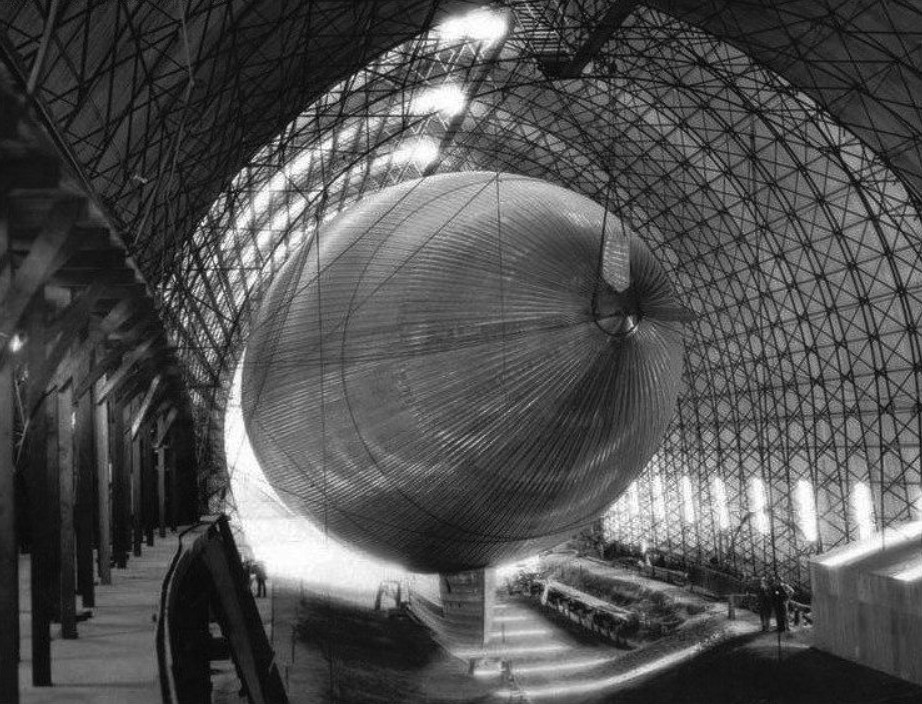 |
|
| (1928)* - The Slate Dirigible is docked in its hanagar at Glendale Airport. At the time, this was the largest built metal hangar in the United States. |
Historical Notes In 1925, Thomas Slate leased space adjacent to the south side of the Glendale Airport for the construction of an all-metal dirigible, a very novel (but ultimately unsuccessful) design. The dirigible was made out of duralumin & was filled with hydrogen. It was forecast to have a cruising speed of 80 mph and would accommodate 40 passengers and 5 crew. The dirigible was to be powered by oil and driven by steam-turbine, using one rotary blower, which would create a vacuum, instead of traditional propellers. Slate also constructed a metal hangar, the largest built in the United States at the time.* |
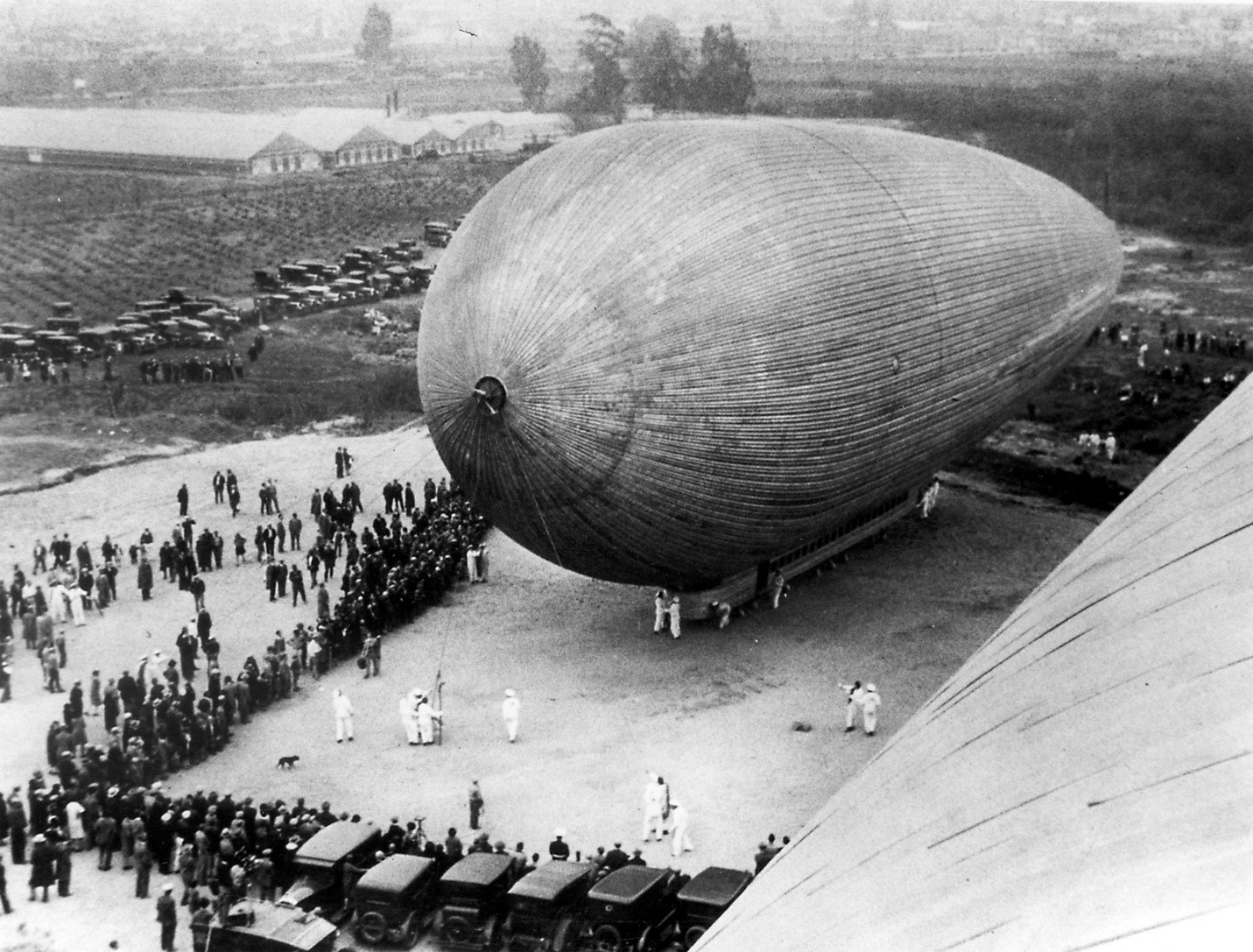 |
|
| (1929)*– Large crowd surrounds a Slate Dirigible at Glendale Airport. |
Historical Notes Dec. 19, 1929- Thomas Benton-Slate was an entrepreneur who invented dry-ice. This day in the suburb of Glendale, he attempted to fly the first all metal dirigible, the City of Glendale. He brought it out two days ago and it immediately began to pop rivets in the heat and fall apart. So he brought it in for repairs. This day he tried one more time, but the sun’s heat expanded the shell, causing rivets to pop again, followed by a metallic explosion and escaping gas. He had it dragged back into the hanger and forgot about it. * |
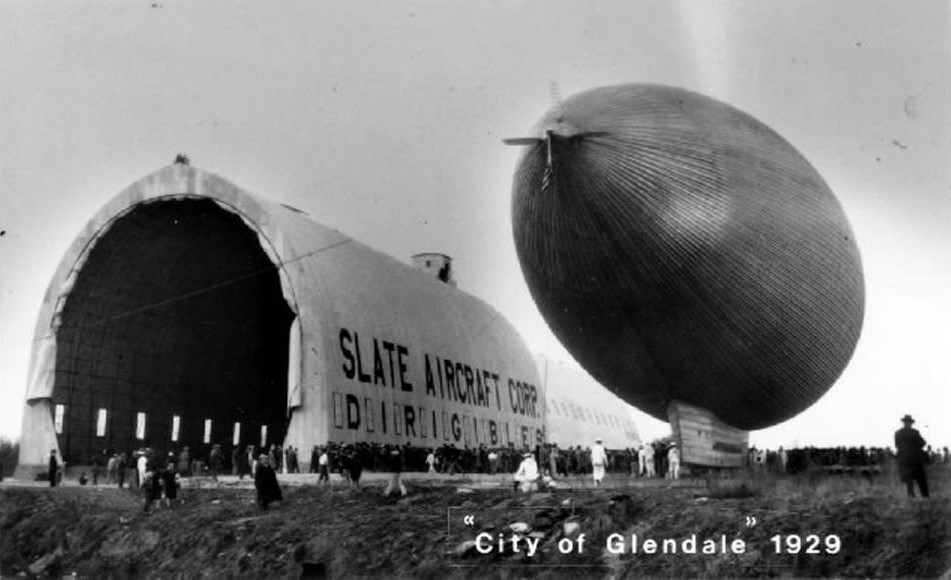 |
|
| (1929)* - Thomas Benton-Slate’s dirigible outside its hangar. |
* * * * * |
Glendale Airport (Grand Municpal Airpot)
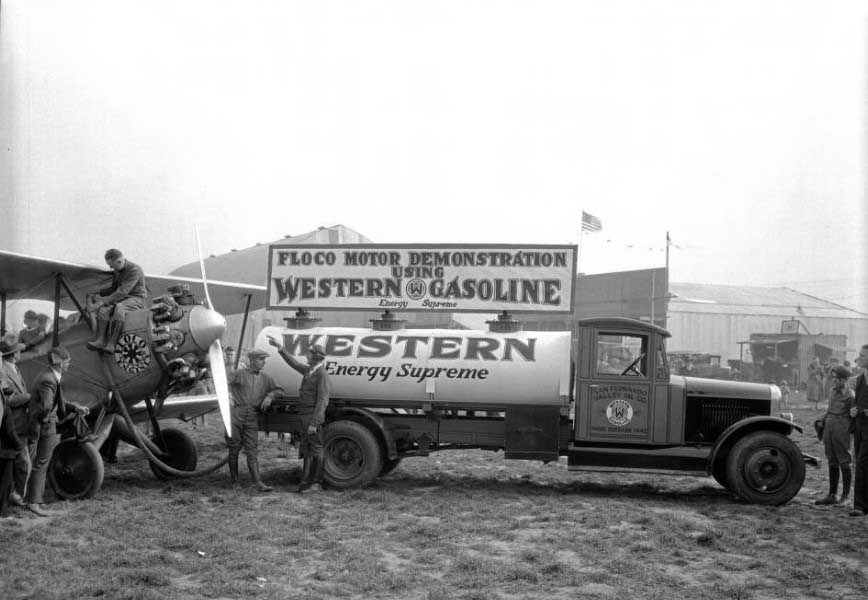 |
|
| (1928)#* - Men refuel a biplane at the Glendale Airport. A sign on the top of the fuel truck reads "Floco motor demonstration using Western Gasoline : energy supreme". The truck has the business's name, San Fernando Valley Oil Co., painted on the side of the cab. Photo by "Dick" Whittington |
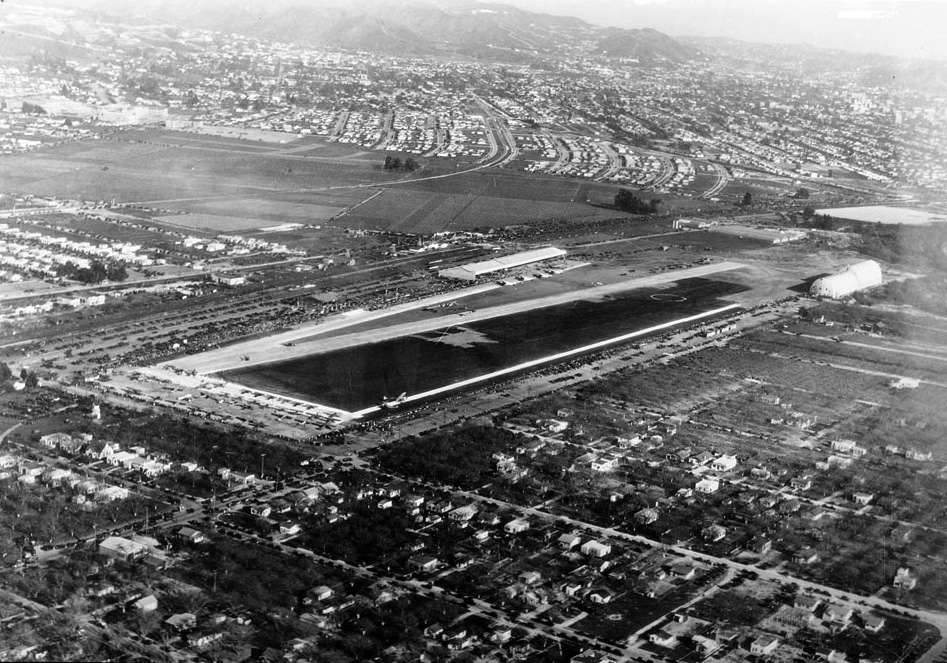 |
|
| (1929)^* - Aerial view of Grand Central Air Terminal, Glendale, 1929. The airfield can be seen at center and a single runway is visible. Hundreds of cars can be seen parked near the runway at left, and planes are visible on the taxiways. Closely spaced houses can be seen in the foreground and in the background. |
Historical Notes The Glendale Municipal Airport was renamed "Grand Central Air Terminal" (GCAT) when it was purchased by other venture capitalists, who expanded it to 175 acres. On February 22, 1929 a terminal with a control tower had been built, and was opened to much fanfare. Designed by Henry L. Gogerty, the intention was to construct an air terminal along the lines of a classic railroad terminal. It combined a style consisting of Spanish Colonial Revival with Zig-zag Moderne influences (Art Deco). GCAT became a major airport of entry to Los Angeles and provided the first paved runway west of the Rocky Mountains. Within a year, the entire enterprise was sold to a group calling itself the Curtiss-Wright Flying Service, managed by Major Corliss C. Moseley, a co-founder of the future Western Airlines. It became the city's largest employer. |
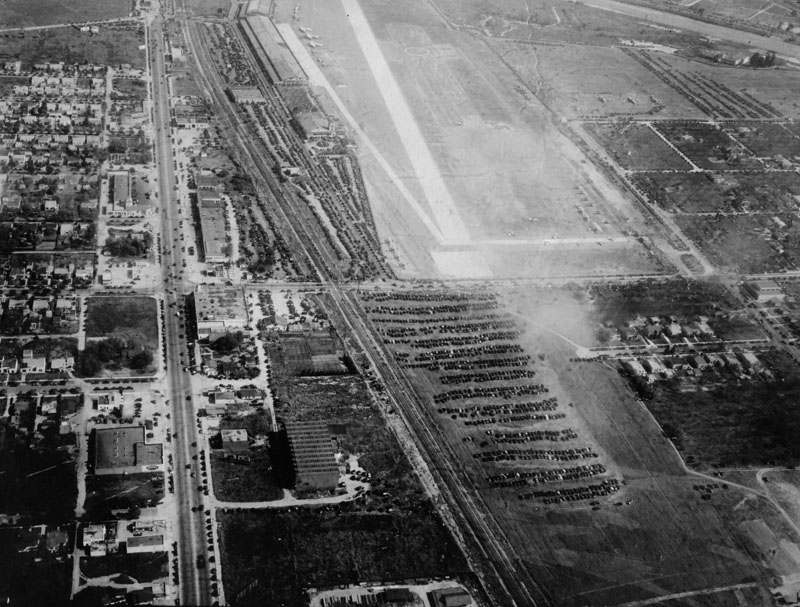 |
|
| (ca. 1929)* - Aerial view of Grand Central Aiport in Glendale on U.S. Army Air Force Day. Planes are parked in front of hangers and on the field. A large number of cars are parked on a field below the airport. A crowd stands between the Grand Central Air Terminal building and the hangars. |
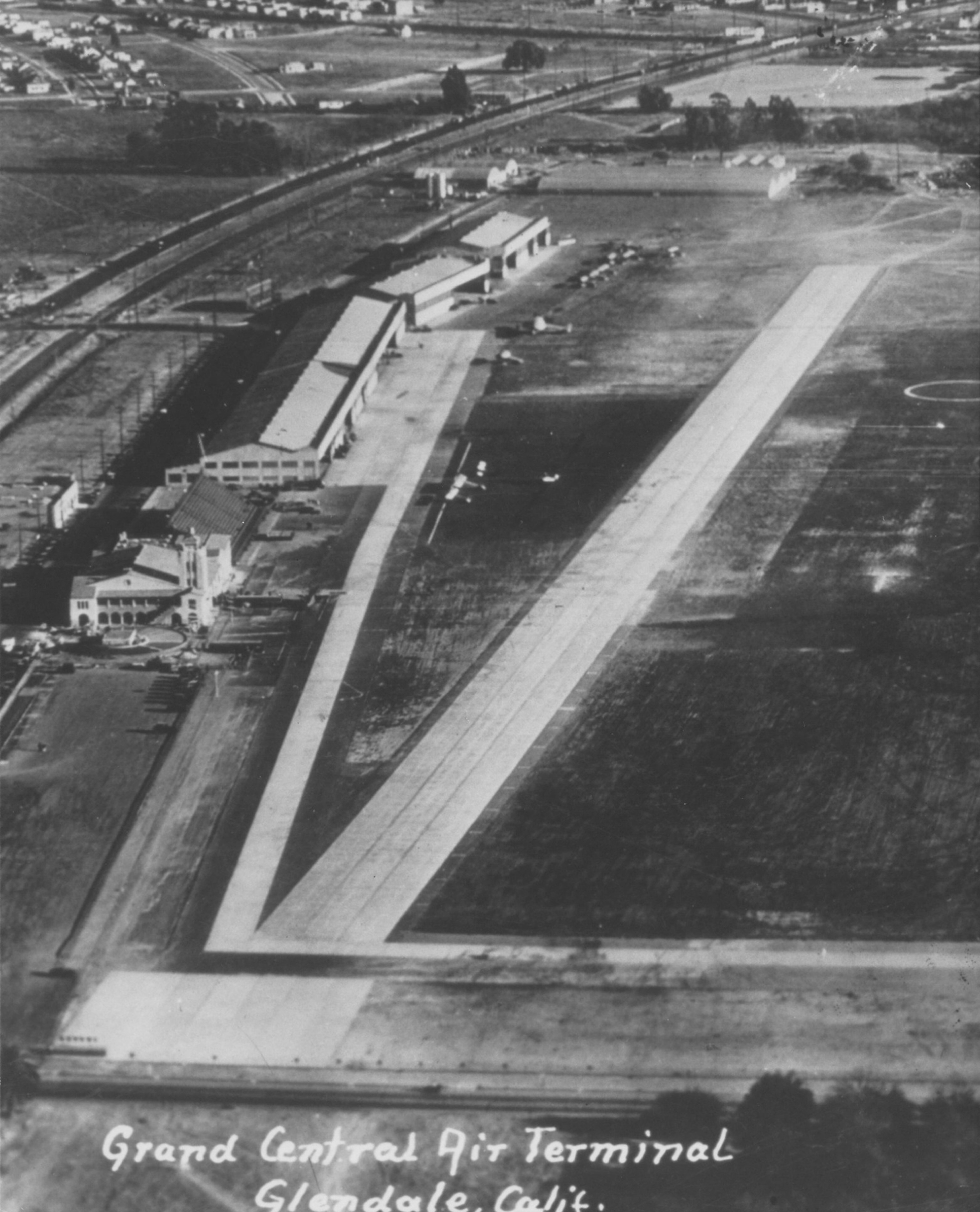 |
|
| (ca. 1930)* - Close-up arial showing Grand Central Aiport and Terminal. |
.jpg) |
|
| (ca. 1930s)^* - Birdseye view of a crowd along the runway at the Grand Central Air Terminal in Glendale. The runway goes from the foreground at right to the background at left. A large crowd of people can be seen around the entire periphery of the runway. It appears that they're waiting to see an air show. |
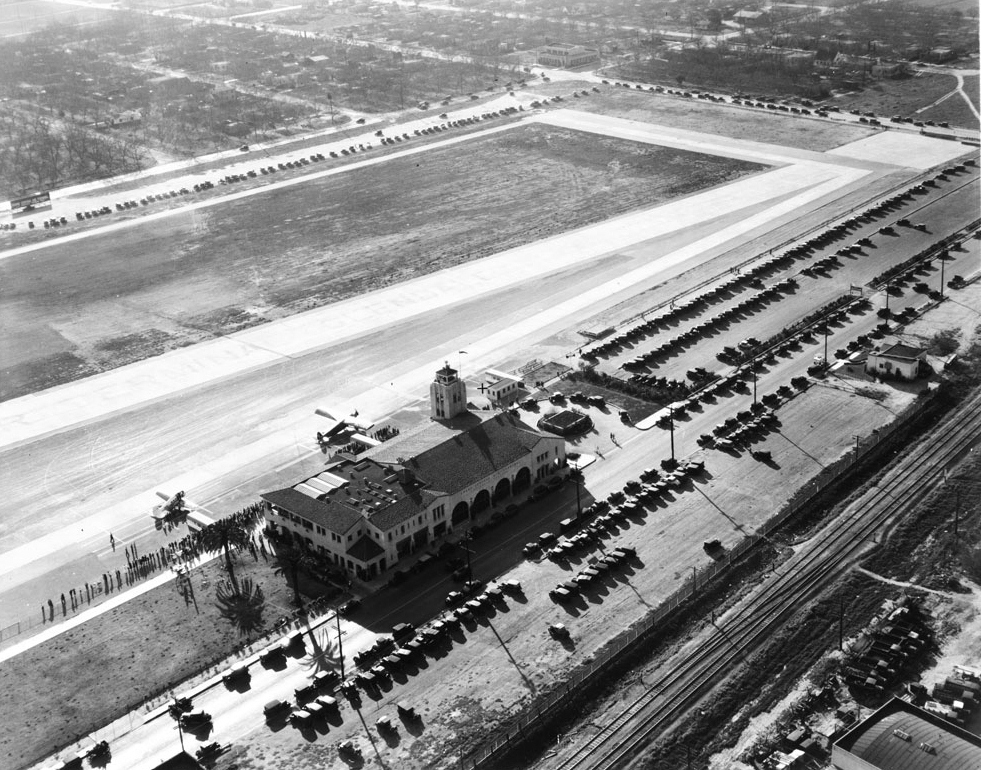 |
|
| (1932)^* - Aerial view of Grand Central Airport in Glendale, February 28, 1932. The terminal is at center and is a large, rectangular, mission-style structure. A tall control tower sticks up from the upper right corner. Two small aircraft are parked directly in front of the terminal, and hundreds of automobiles are parked in a lot behind the terminal. Many people are lined up near the aircraft. The runway is at center and borders a large dirt field. In the distance at left, a neatly arranged neighborhood is visible, while railroad tracks can be seen in the foreground at right. |
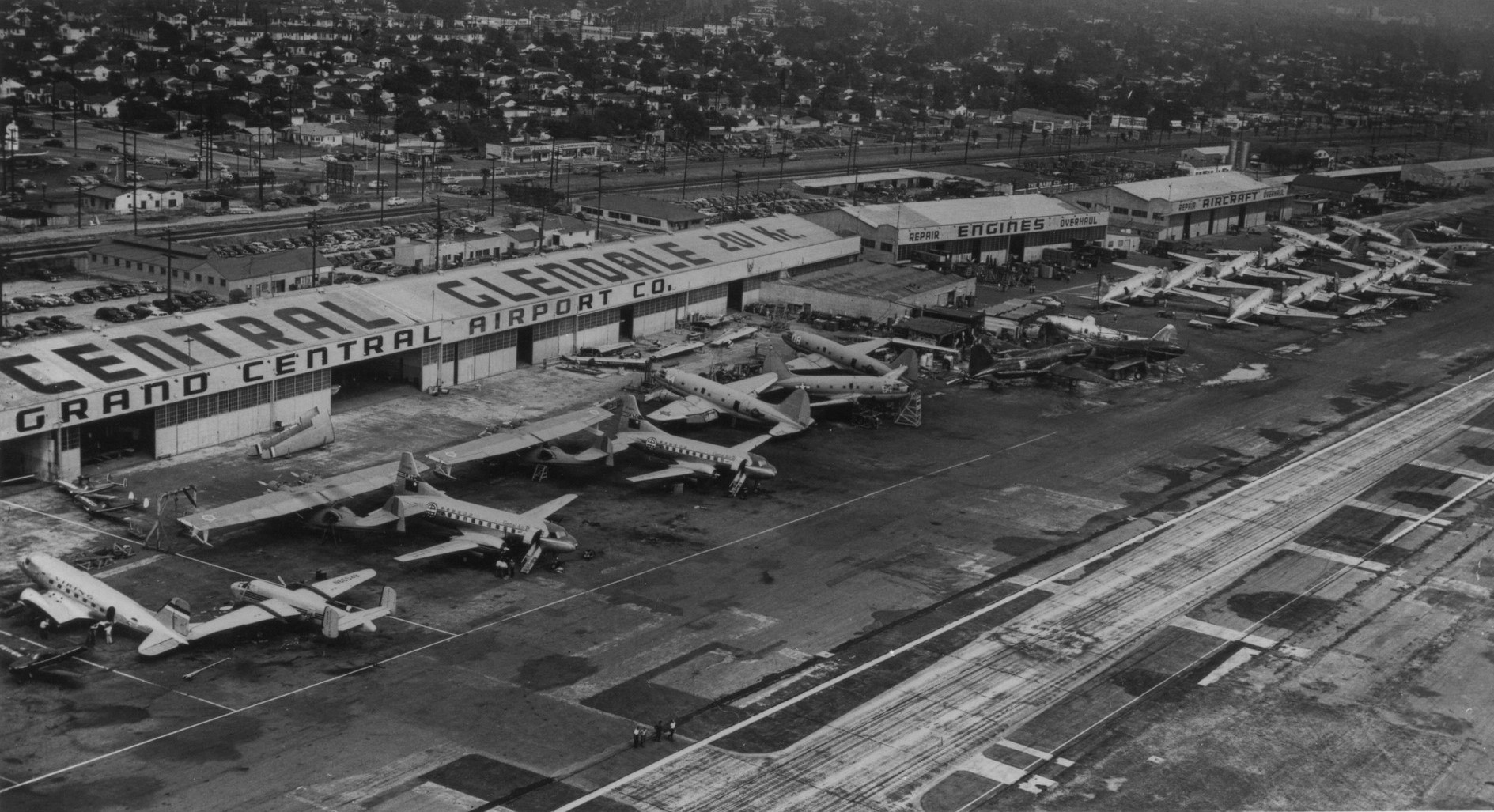 |
|
| (ca. 1940s)* - Glendale Central Air Terminal with passenger planes |
Historical Notes In 1947 the runway was cut back to 3,800' (southeast of Sonora Ave) due to pressure from local government. The airport was returned to private use, renamed Grand Central Airport, ceased to be profitable, and was closed in 1959 to make way for the development of the Grand Central Business Park, which today houses corporate offices of the Walt Disney Company as well as the headquarters for Walt Disney Imagineering. For a number of years the Southwest corner was used as a commercial helicopter base. That space is now occupied by the DreamWorks Animation SKG production company. The city of Glendale retains some interest in aviation, for it is part owner of the Bob Hope Airport (formerly "Burbank-Glendale-Pasadena Airport"). |
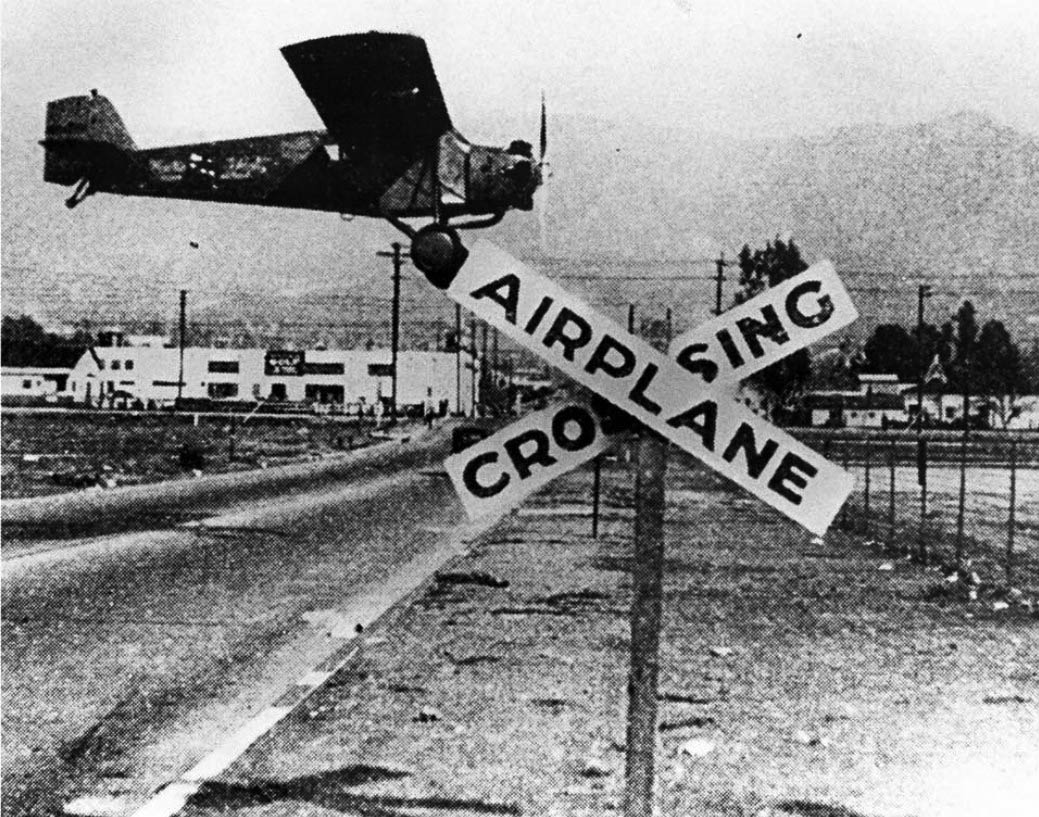 |
|
| (1930)*- Airplane Crossing sign at Grand Central Airport in Glendale. |
* * * * * |
Grand Central Terminal
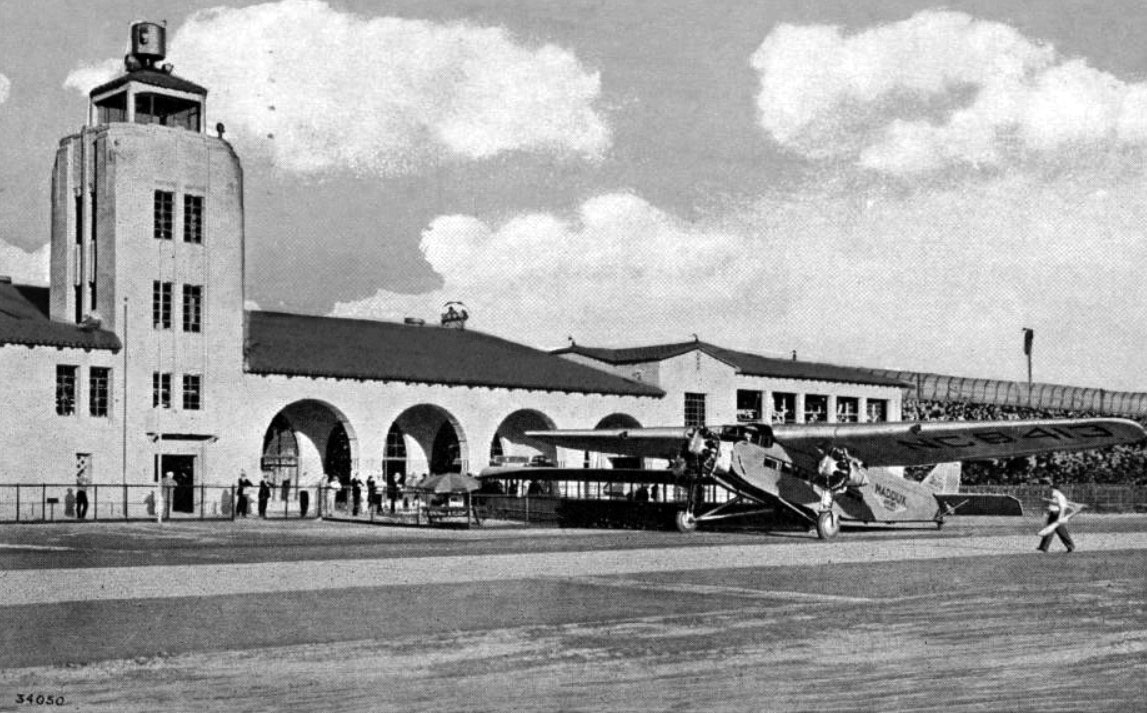 |
|
| (ca. 1930)* – Postcard view showing the Administration Building at the Grand Central Airport in Glendale. A small airplane numbered NC-8413 is in front of the building. |
Historical Notes The Grand Central Airport Terminal was designed by Henry L. Gogerty in 1928 blending the Spanish Colonial Revival style with Art Deco influences. The Airport first began its service between Los Angeles and New York, and it played a vital role as the premier airport in Southern California. The building represents the simple concept of early airport terminal design, and it is listed on the Glendale Register of Historic Resources. The airplane shown in this image was a Ford 4-AT Tri-motor owned by the Maddux Air Lines, which carried 12 passengers from San Diego to Los Angeles during its inaugural flight in California. |
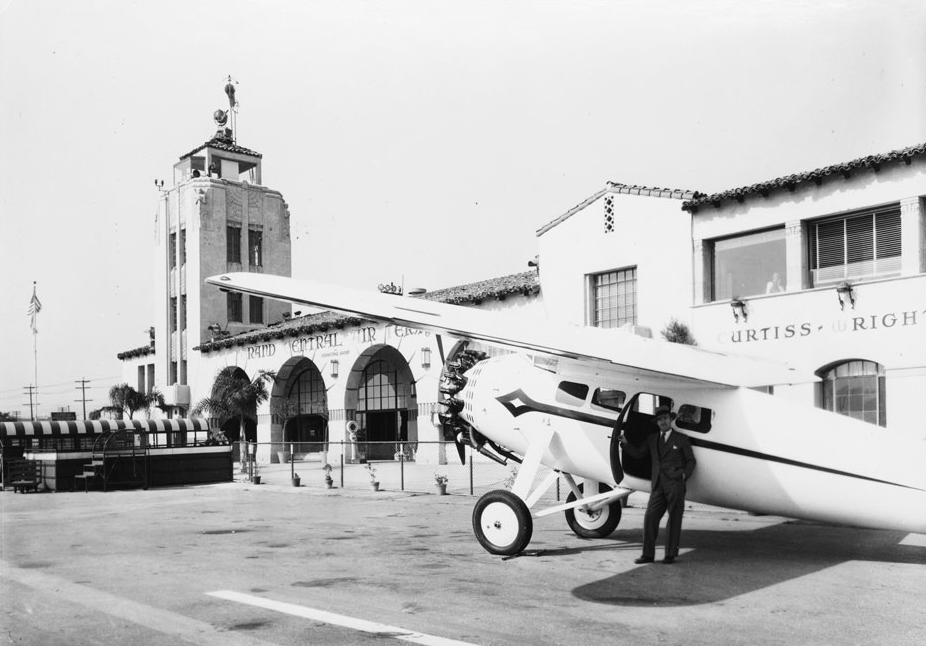 |
|
| (ca. 1930s)^* - Photograph of a radial-engine airplane outside the Grand Central Airport. The high-wing monoplane can be seen in the foreground at right, and a man in a suit is visible near an open door under the wing. The Spanish-style air terminal can be seen in the background. It is a two-story structure with a terracotta tile roof. In the background at left, a tall rectangular control tower is visible. Legible signs include "Grand Central Air Terminal" and "Curtiss-Wright". |
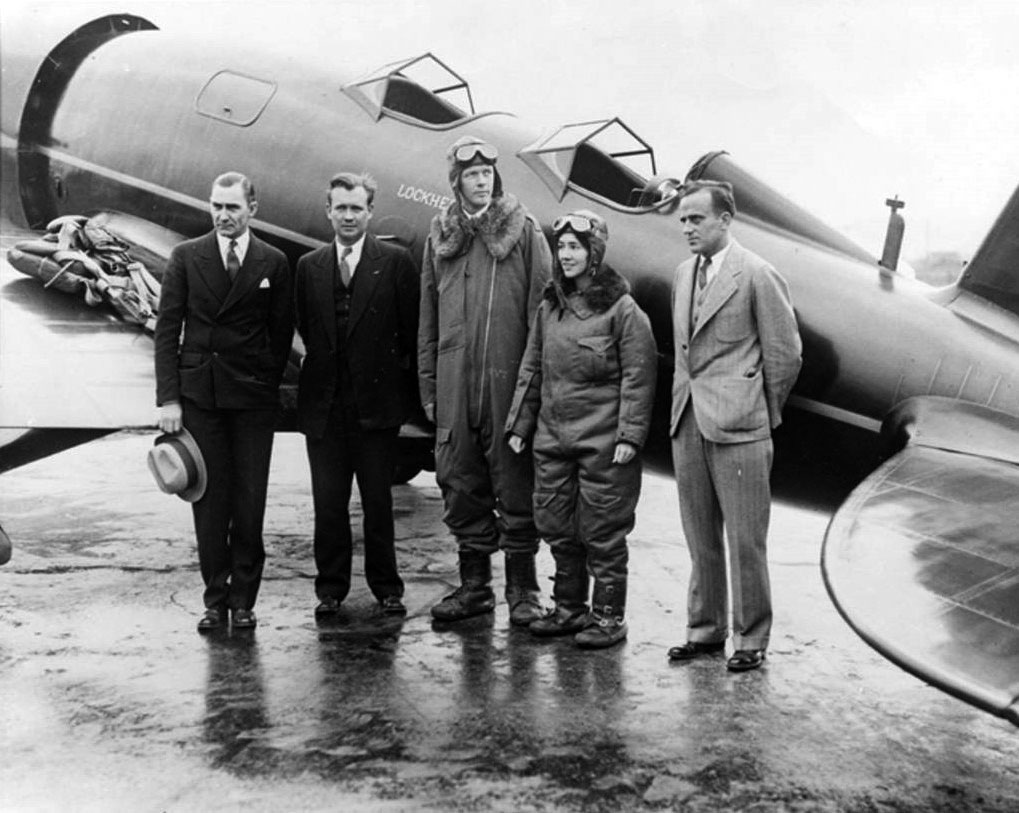 |
|
| (1930)^ – View of Charles A. Lindbergh and his co-pilot/navigator, Anne Lindbergh beside their Sirius, built according to the specifications of Lindbergh, by Lockheed. |
Historical Notes On Easter, 1930, Colonel Lindbergh and his wife, Anne, took off from Glendale (Calif.), bundled up in their bulky, electrically heated flying suits, to test the advantages of weather at high altitudes, and to set new transcontinental records. The sliding canopies, covering both formerly open cockpits, were suggested by Mrs. Lindbergh, who set a women's record for coast to coast flights on this first Lockheed Sirius. The sliding canopies were later put into common use. While the ship was being built, Lindbergh, shy of publicity, was secluded from hero-worshippers in the Hamilton Propeller Shop at the Burbank Field. He seemed happy and relaxed working quietly along with the mechanics. Some who were there have left stories of their admiration for this warm, friendly man, a perfectionist, interested in everything concerning his plane. They fondly told how he politely by-passed invitations from Very Important People, and went to lunch day after day with the crew. On occasions, Mrs. Lindbergh waited for her husband to finish his work in their car, parked in the shade of the hangar. The working crew would bring her sandwiches and cold drinks from the lunchroom nearby. The photograph was probably taken in Glendale, but it is a Lockheed plane, made in Burbank.^ |
 |
|
| (1931)** - Amelia Earhart with the Beech-Nut Pitcairn PCA-2 Autogiro at Glendale Grand Central Air Terminal on June 7, 1931. Earhart arrived from PA on what she thought was the first transcontinental Autogiro flight only to discover that John M. "Johnny" Miller had beaten her by 9 days. |
Historical Notes The PCA-2 was the first rotary-wing aircraft to achieve type certification in the United States and was used in a number of high-profile activities including a landing on the White House lawn and the first flight across the United States in a rotorcraft. This latter feat was attempted by Amelia Earhart, flying for the Beech-Nut food company, but was actually accomplished by John M Miller who completed his flight nine days before Earhart on 28 May 1931, in his PCA-2 named Missing Link. Learning of Miller's achievement upon her arrival in California, Earhart set out to turn her flight into a round-trip record by flying east again, but abandoned the attempt after three crashes. Earhart set an altitude record in a PCA-2 on 8 April 1931 with a height of 18,415 ft. This record was broken in another PCA-2 by Lewis Yancey who flew to 21,500 ft on 25 September 1932. ^ |
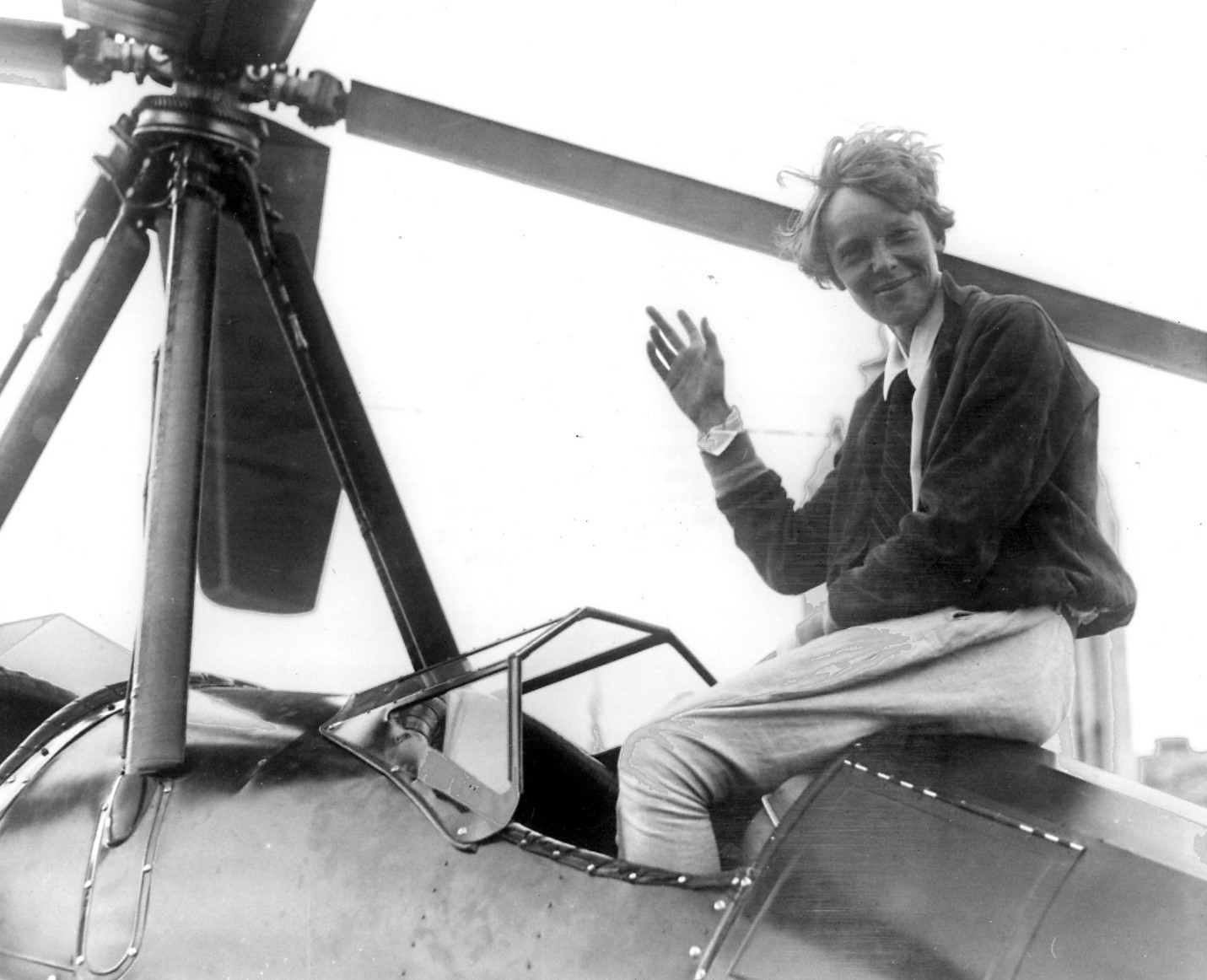 |
|
| (1931)+## - Amelia Earhart is seen sitting on plane mounted with a horizontal propeller (Pitcairn PCA-2 Autogiro) at Grand Central Airport. |
Historical Notes Amelia Earhart became famous when she was the first female aviator to fly solo across the Atlantic Ocean in 1928, so it was newsworthy when she landed an autogiro (which is kind of like a helicopter) at Grand Central Air Terminal, Glendale on June 7, 1931. At the time she was attempting the first transcontinental autogiro flight from Newark, NJ to Los Angeles, and landed at about 5 p.m. to replenish her gas supply. At the time, Grand Central was a busy and important airport, and due to its eye-pleasing design and proximity to the movie studios, was often used in the movies. |
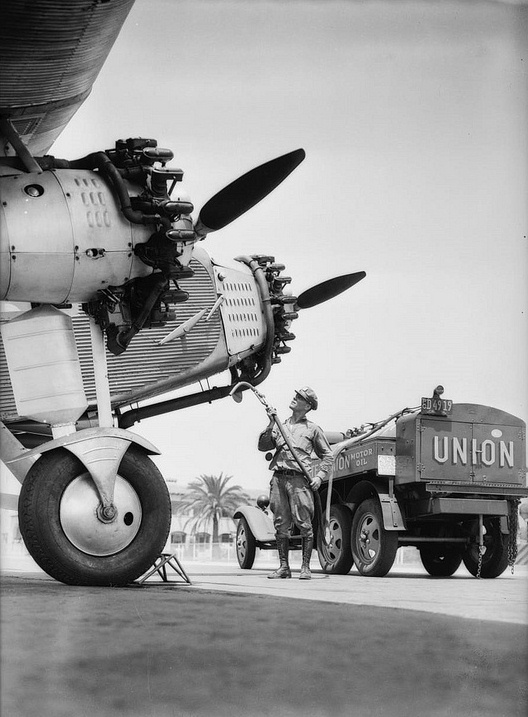 |
|
| (ca. 1931)^*# - Plane being refueled by a tank truck labeled Union Motor Oil, at Grand Central Airport. |
 |
|
| (1933)^.^ – View showing the 12-passenger DC-1, Douglas Commercial Model No. 1, at Grand Central Air Terminal. |
Historical Notes The DC-1 was specifically designed for TWA. Its inaugural flight was on July 1, 1933, but it was nearly the last when both engines quit during the climb out. After modifications, the new plane met all of TWA’s requirements, most importantly of which was to be able to fly with only one of the two engines. TWA placed an immediate order for 25 Douglas airliners, but with more refinements as the DC-2. |
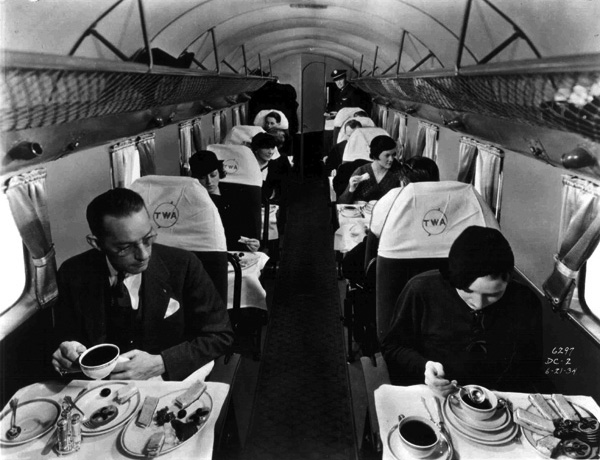 |
|
| (1933)* – View showing showing passengers dining in a TWA DC-2, (refined DC-1). |
Historical Notes The DC-2 was increased in size with a wider diameter fuselage to allow for the taller passengers to stand in the cabin. Its length was increased by two feet to allow for an extra row of seats that increased total seating to 14. There were other improvements as well. The payload was increased, the service ceiling was increased, the speed was increased and even in-flight movies were introduced. The DC-2 was now the most luxurious airliner in the world. Only four months after the Model 247 entered service, the first DC-2 was handed over to TWA. It flew in record time between Los Angeles and New York. TWA advertised Coast-to-Coast service in a 200 mph luxury airliner called the Sky Chief. Transcontinental flights consisted of four legs from New York (Newark) to Chicago, Kansas City, Albuquerque and Los Angeles. Flights left at 4:00 p.m. and arrived at 7:00 a.m. the next day. |
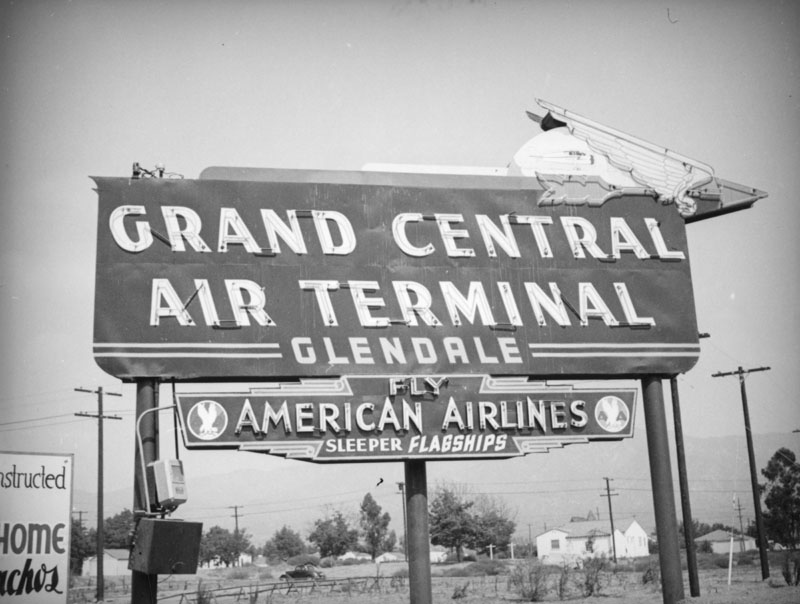 |
|
| (ca. 1937)* - A wing and arrow top this neon sign for the Grand Central Air Terminal, located at 1310 Air Way in Glendale. A smaller sign hangs below encouraging one to fly the American Airlines Sleeper Flagships. A log fence and telephone lines separate the neighboring Spanish style ranch houses from the field surrounding the sign. A painted sign advertising the new development of "Ranchos" is cut off in the foreground. |
 |
|
| (1937)* - View of an American Airlines DST (Douglas Sleeper Transport - an early version of a DC-3) prop plane carrying mail on the landing at the Grand Central Air Terminal, located at 1310 Air Way in Glendale. |
Historical Notes The Grand Central Air Terminal was designed by Henry L. Gogerty in 1928 in the Spanish Colonial Revival style with zig-zag moderne elements. The terminal is a City of Glendale registered landmark.* |
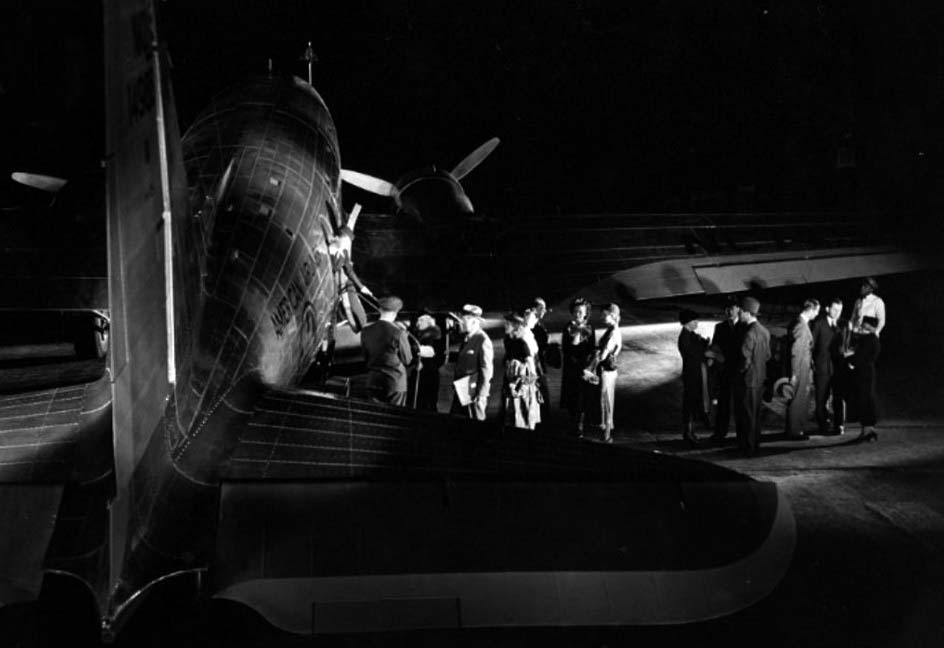 |
|
| (ca. 1940)#^ - Night departure of a DC-3, Grand Central Air Terminal, Glendale. Hagley Digital Archives |
Historical Notes The DC-3 was a twin-engine metal monoplane, developed as a larger, improved 14 bed sleeper version of the Douglas DC-2. It had many exceptional qualities compared to previous aircraft. It was fast, had a good range and could operate from short runways. Its construction was all-metal. It was reliable, easy to maintain and carried passengers in greater comfort. Before the war it pioneered many air travel routes. It was able to cross the continental United States, making transcontinental flights and worldwide flights possible, and is considered to be the first airliner that could make money by carrying passengers alone.*^ |
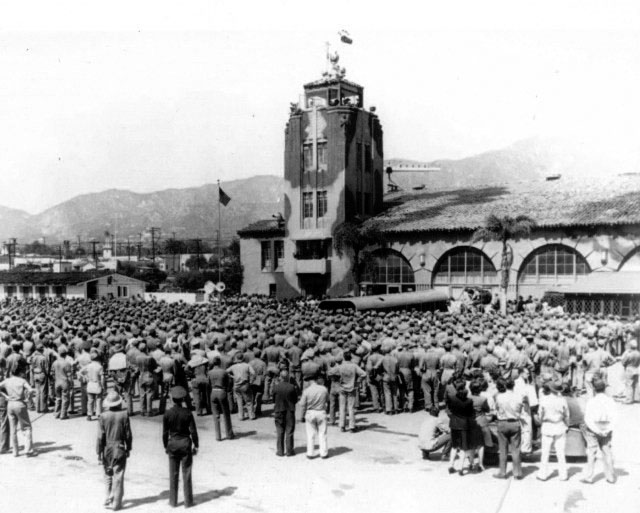 |
|
| (1942)^.^ – View showing hundreds of recruits gathered to hear Air Marshall W. A. Bishop speak in front of the Grand Central Air Terminal during WWII. Note that the tower has already been painted with camouflage. |
Historical Notes When Pearl Harbor was attacked on December 7, 1941, Grand Central Airport (like all other west coast airports) was immediately closed to private aviation. (The remaining airlines had already moved to Burbank.) The government moved in, heavily camouflaged the place, and converted it into an important defense base for Los Angeles. In 1942 the runway, which originally ended at Sonora Avenue, was extended North to Western Avenue, giving it a 5,000' length to accommodate large airplanes and future jet aircraft. After the war, geographic constraints hindered the airport’s ability to accommodate new—and larger—commercial aircraft. |
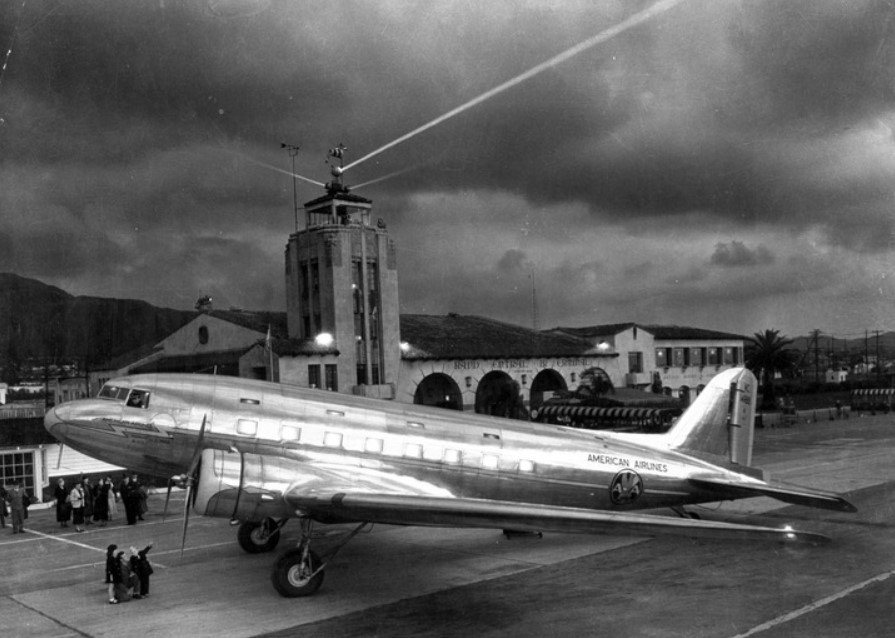 |
|
| (1940s)^*^ - A shining DC-3 parked in front of the Grand Central Airport terminal as night falls. |
Historical Notes In 1947 the runway was cut back to 3,800' (southeast of Sonora Ave) due to pressure from local government. The airport was returned to private use, renamed Grand Central Airport, ceased to be profitable, and would eventually be closed in 1959. The closed airport was then used as a private heliport for the Los Angeles Police Department's fleet of police helicopters, some Bell 47's ("recips") and some Bell 206's ("Jet Rangers"), until the hew LAPD Hooper Heliport opened on top of the Piper Tech Building in downtown Los Angeles in 1983. The runways were torn out and replaced by a street named Grand Central Avenue. Over 70 new “tilt up” manufacturing buildings were constructed under the direction of the Grand Central Industrial Centre. The redeveloped airport property was eventually purchased by the Prudential Insurance Company and leased out as an investment. When Walt Disney was developing Disneyland in the early 1950s, he wanted a place away from the main studio where he could work on new ideas undisturbed. He rented an industrial building at 1401 Flower St. on the old airport property. WED (Walter E. Disney) Enterprises also rented the old terminal building during the busy years of Epcot and Disney World development. Dreamworks was created in 1994, and their new buildings soon appeared on part of the old airport land just down the street from Disney’s leased building. The Disney Corporation soon purchased the remaining land from the airport and have announced a 15-year plan to turn it into a corporate “creative campus” behind security gates. Disney has stated their intention to rework the old terminal by the year 2015 to its original look. Much of the original metal work, railings and lights have been stripped away over the years, but the Disney representative feels that their company can easily reproduce replacement pieces. There are also two original hangars left—one very modified into a cold storage facility and the other is now used by Disney Imagineering for special effects mock-ups.+## |
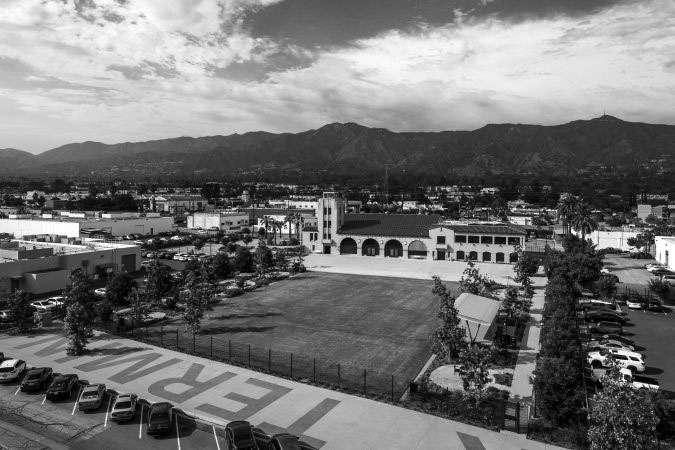 |
|
| (2017)^ - View showing the Grand Central Air Terminal as it appears today. Photo by Paul Turang, Los Angeles Conservancy |
Historical Notes The Grand Central Air Terminal remained untouched until 2012, when its current owner embarked on a project to transform the airport for new uses. The project team rehabilitated the entire property, including the airport concourse, runway, and taxiway. They completely restored the building’s exterior and significant interior spaces. The team thoroughly researched and meticulously restored, or recreated, missing or degraded character-defining features, such as light fixtures and decorative tile.* |
* * * * * |
Metropolitan to Van Nuys Airport
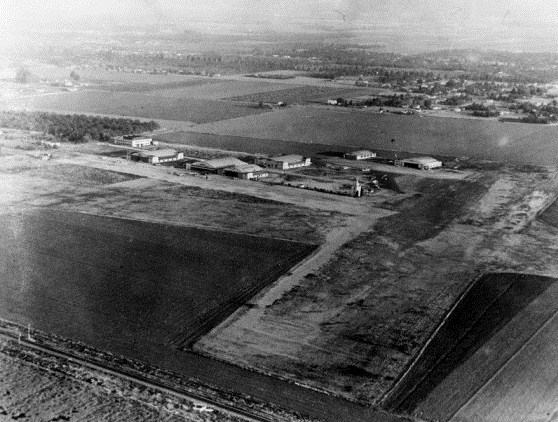 |
|
| (1930)^ - Aerial view of Van Nuys Airport when it was known as Metropolitan Airport. |
Historical Notes Los Angeles Metropolitan Airport opened in 1928 and was spread over 80 acres amid the trees and farmland. In 1929, Hollywood discovered the airport. Howard Hughes, Hoot Gibson, Cecil B. DeMille, Gene Autry and Wallace Beery were among the growing number of stars flying at the new airport. The airport continued to expand and grow with three factories, six hangers, and a control tower on airport grounds. The airport also began hosting air races. During one such race in 1929, Amelia Earhart set a new speed record.*^# |
 |
|
| (1929)^.^ – View showing the westernmost hangar (the one closest to the control tower) while it was under construction in the fall of 1929. At that time, it was the only hangar at the airport. When it was completed, "Los Angeles Metropolitan Airport" was painted in large letters on the roof. |
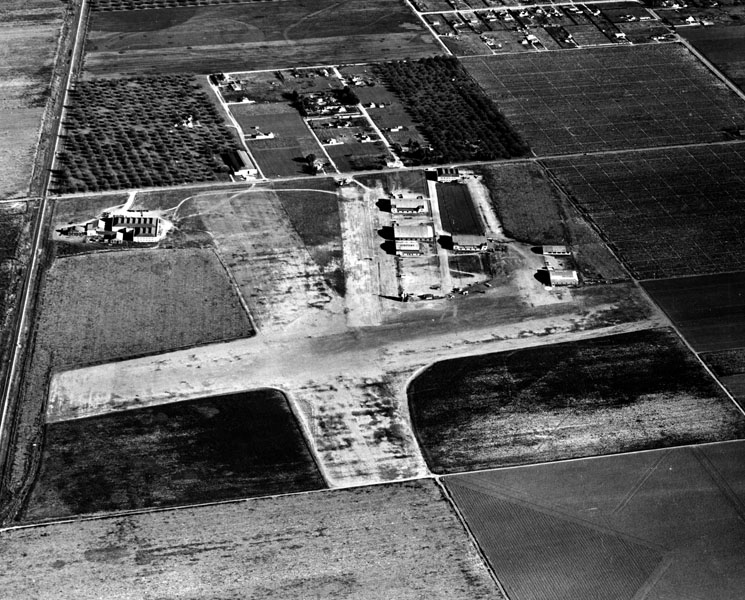 |
|
| (1940)* - Aerial view showing the Metropolitan Airport, later Van Nuys Airport, on April 15, 1940. |
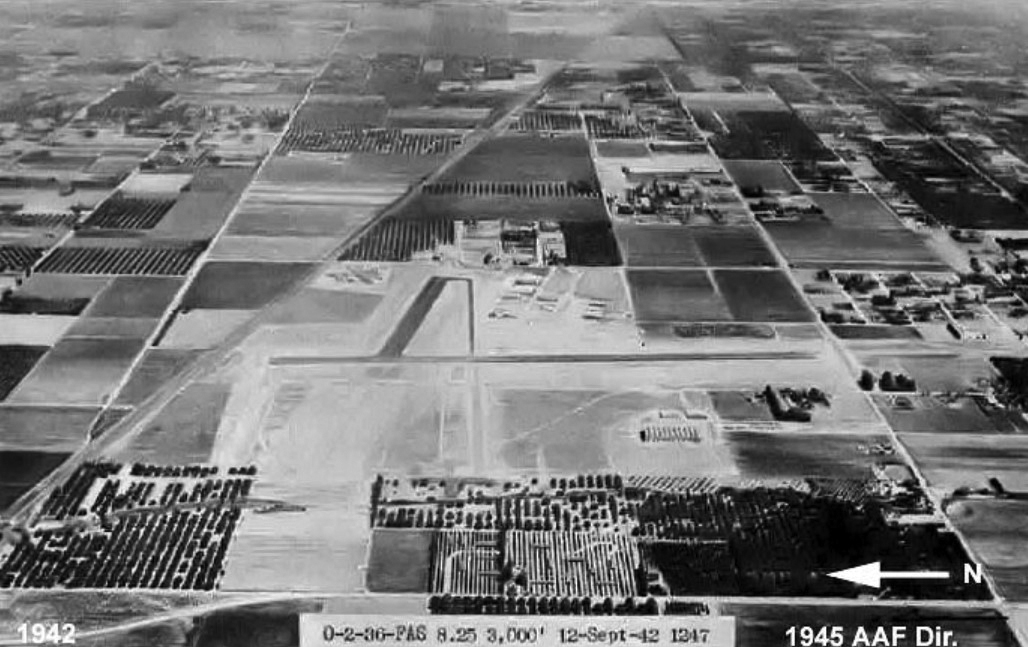 |
|
| (1942)*^ – Aerial view looking east showing the Van Nuys Army Airfield. Note the vast open land around the airport. |
Historical Notes In 1942, with the outbreak of World War II, the U.S. government purchased Metropolitan Airport and converted it into a military base to help protect the West Coast. The military also purchased an additional 163 acres of land for the construction of the Van Nuys Army Airfield, using new runways to train hundreds of P-38 Lightning pilots.*#^ |
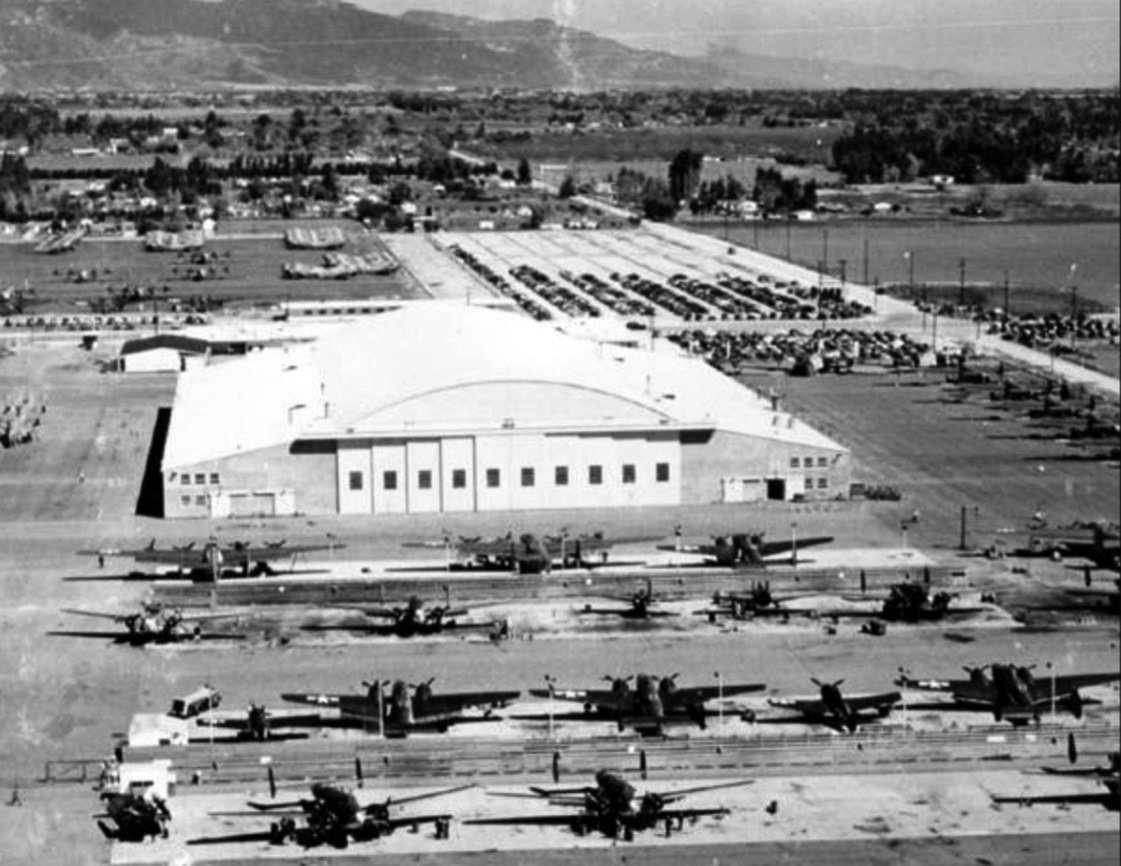 |
|
| (1940s)* - Fighter aircraft at Lockheed facility, Metroplitan Airport (later Van Nuys Airport). |
Historical Notes The airport became a vital defense-manufacturing center during the war. In 1944, a joint venture between the U.S. Navy and Lockheed Corporation created an aircraft modification facility known as the Navy Lockheed Plant. |
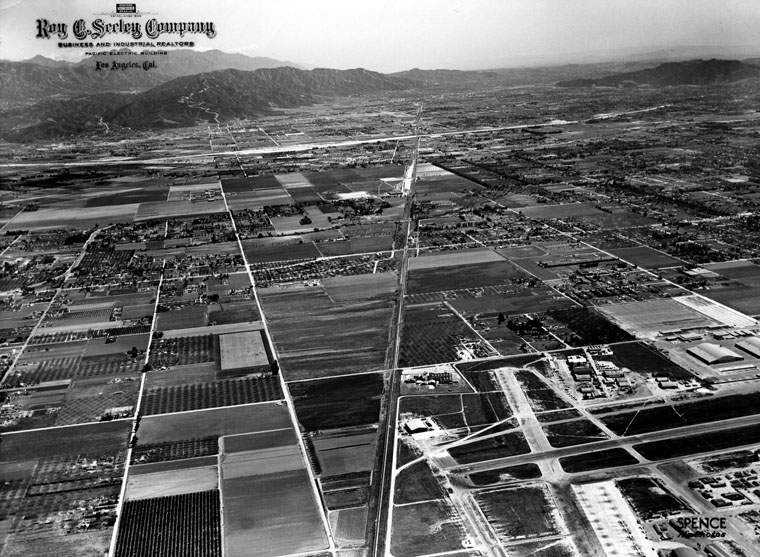 |
|
| (ca. 1944)* - Aerial view, looking east, of the San Fernando Valley. The Metropolitan Airport is seen at lower right after its expansion. |
 |
|
| (1946)* - Aerial view of San Fernando Valley, north of the Metropolitan Airport, now known as Van Nuys Airport. |
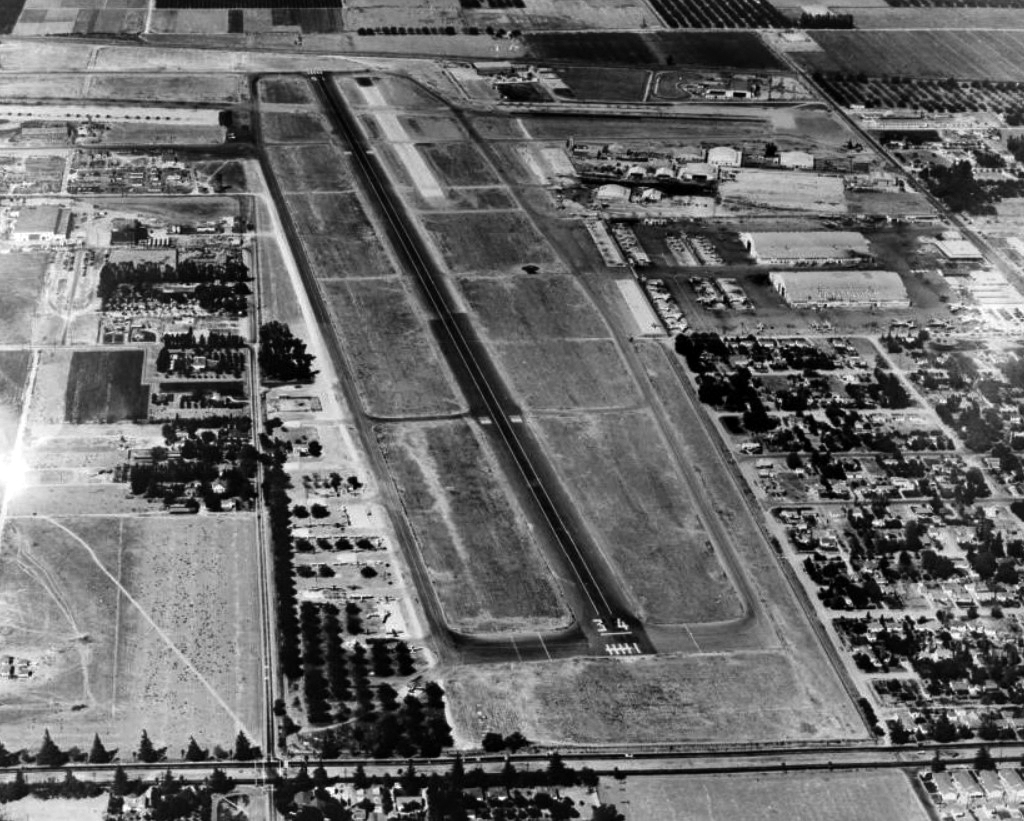 |
|
| (1950)#* - Aerial view looking down on the runway and buildings of the Metropolitan Airport in Van Nuys, bordered at the southern end by Sherman Way and by railroad tracks to the north. |
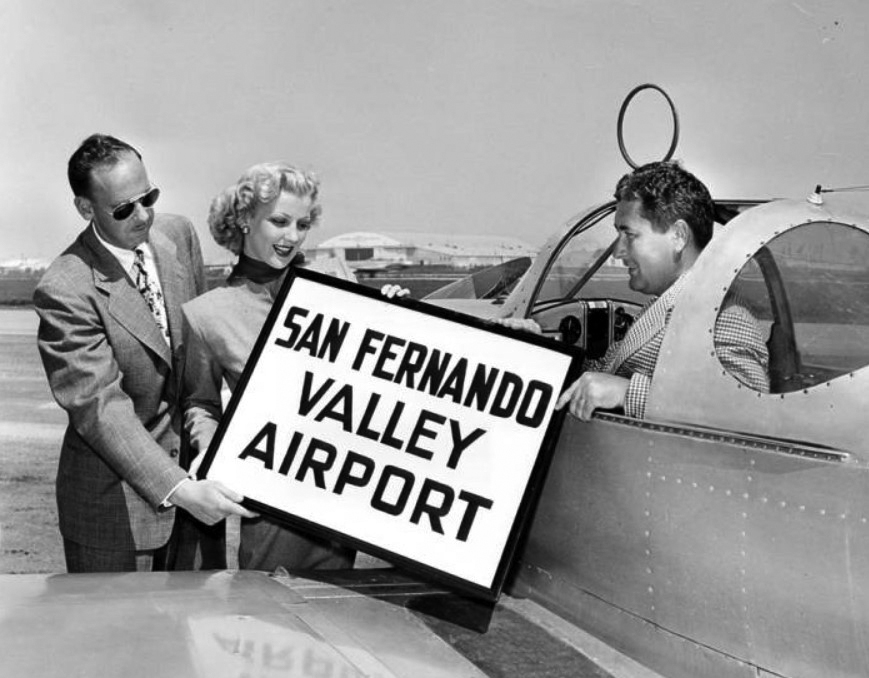 |
|
| (1950)^ - Metropolitan Airport is renamed San Fernando Valley Airport. |
Historical Notes In 1949, the city of Los Angeles purchased the airport from the War Assets Administration for a token payment of one dollar, with the condition that it remain the home of the California Air National Guard until 1985. One year later, the airport was renamed San Fernando Valley Airport.*# |
 |
|
| (1955)^ - Several F-86s from the Air National Guard's 146th Tactical Fighter Wing resting on the ramp at San Fernando Valley Airport in Van Nuys. |
Historical Notes Following World War II, previously splintered Army National Guard and Army Guard Air Corps units were reformed and restructured under the newly created Department of Defense. On September 16, 1946, the 62nd Fighter Wing, 146th Fighter Group and 115th Bombardment Squadron (the former 115th Observation Squadron) were given Federal recognition, and flew their first missions out of Van Nuys Air National Guard Base, later to become Van Nuys Municpal Airport in the San Fernando Valley north of Los Angeles. In 1948, several units of the new wing moved to Burbank Airport, only to return to Van Nuys a short time later, after too little ramp space at Burbank proved a hindrance to accomplishing the wing's missions.* |
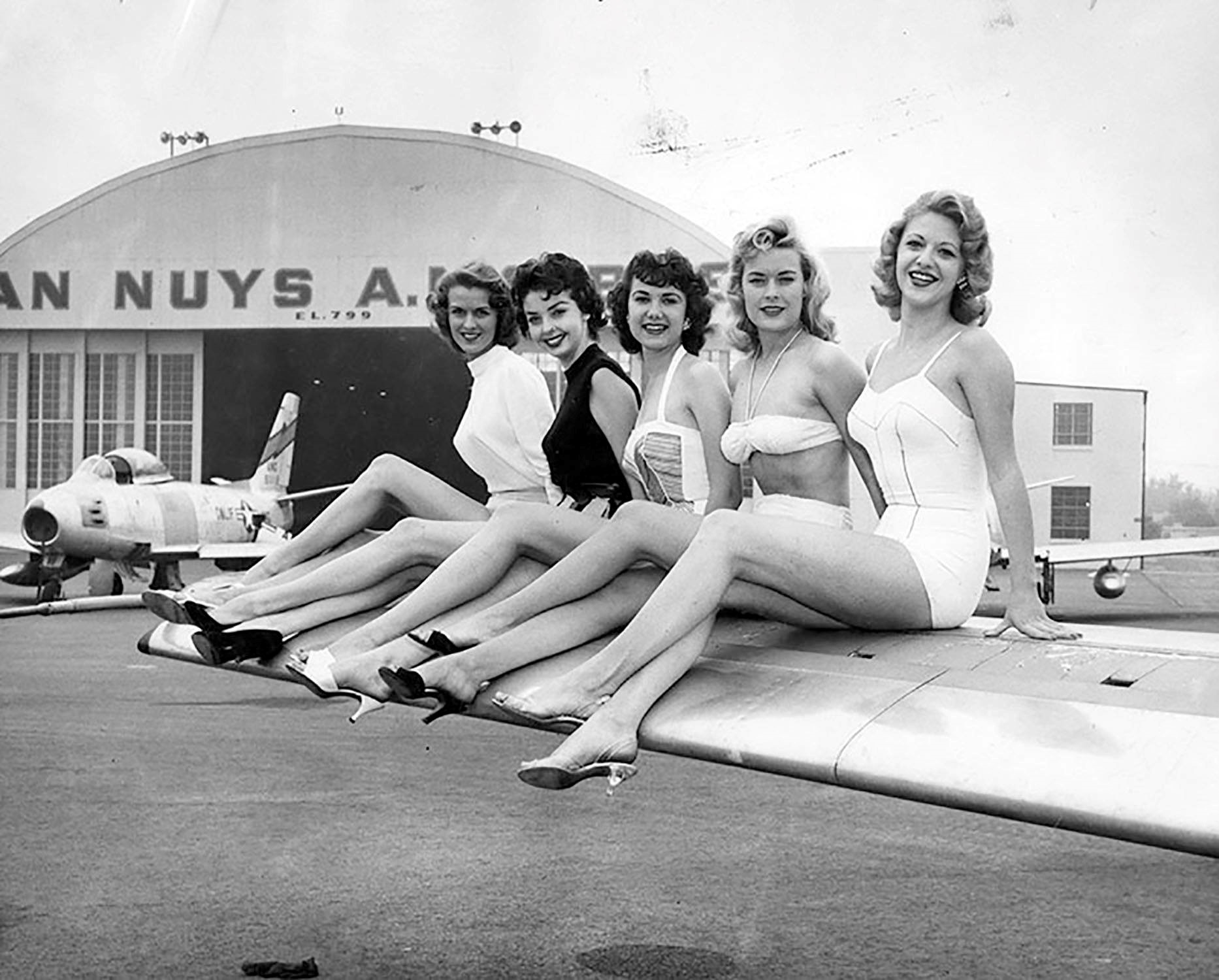 |
|
| (1956)* – View showing models posing for the camera while sitting on the wings of airplane. In the background stands an F-86 Sabre with leading edge slats and deployed air brake in front of a Van Nuys Air Force hangar. |
Historical Notes Valley Times Photograph caption dated April 26, 1956 reads "Beauties above will assist during open house program May 19-20 at San Fernando Valley Airport by posing for amateur photographers and serving as models for a fashion show. From left they are Gloria Robertson, Camille Williams, Babs Manausa, Barbara Thompson and Ree Regul. Open house will tie in with Armed Forces Day." The Metropolitan Airport opened on December 17, 1928. In 1950 it was renamed San Fernando Valley Airport and in 1957 the name changed to Van Nuys Airport. The airport is located at 16461 Sherman Way, Van Nuys.* |
 |
|
| (1950)^ – Postcard aerial view of the runway at Van Nuys Airport. |
Historical Notes The above photo is mislabeled. In 1950 the airport was still known as the San Fernando Valley Airport. It would be renamed Van Nuys Airport in 1957.*^# |
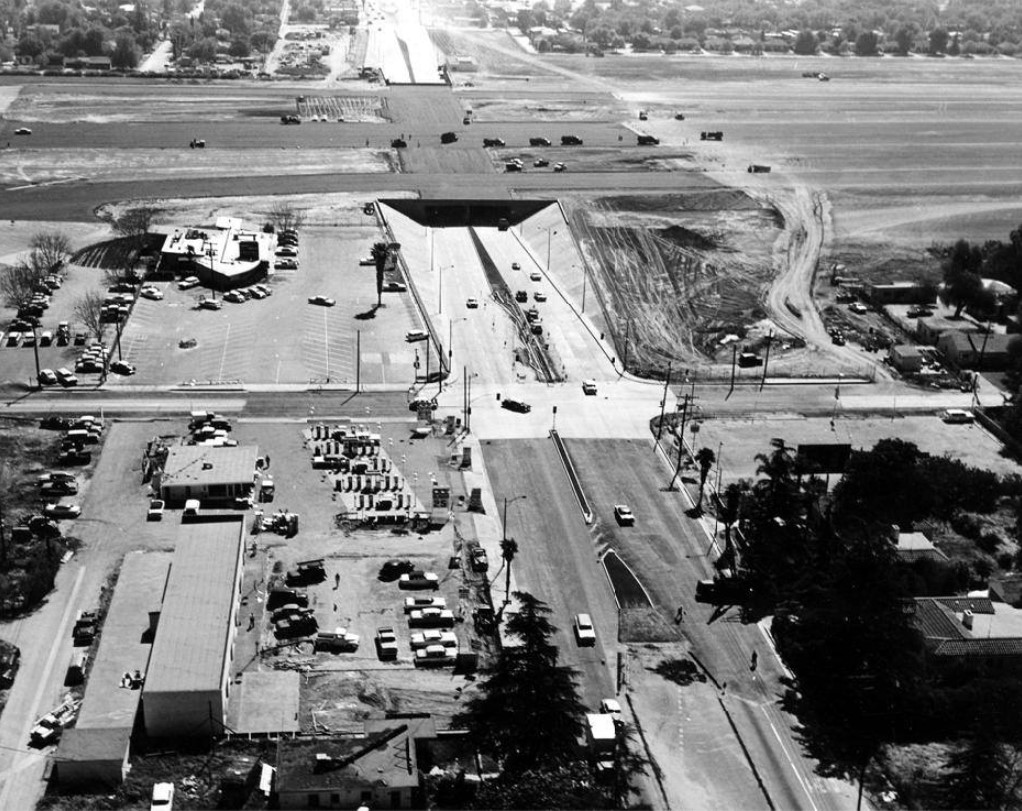 |
|
| (1958)#^^* – Aerial view showing the construction of the Van Nuys Airport runway extension and Sherman Way Tunnel. |
Historical Notes At one point the Van Nuys Airport was envisioned as a base for Air Force fighter/interceptor planes to defend against a feared attack by Soviet-piloted bombers from Siberia. To provide the space needed for early jet fighters, a runway was extended an additional 2,000 feet south from Saticoy Street to Vanowen Street. To avoid blocking busy Sherman Way, the street was routed into a tunnel under the runway, which is still in use today. But, by the time hundreds of homes had been razed and the expansion completed, the defense role was taken over by Nike anti-aircraft missiles, leaving the airport with an extraordinarily long (8,000 feet!) runway for a general aviation field, an unintended legacy of the Cold War.*^# |
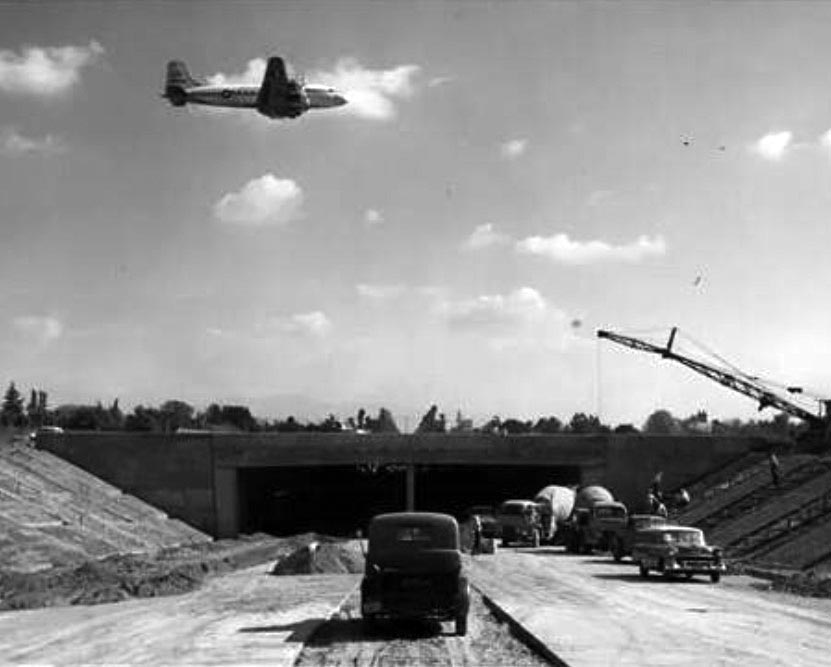 |
|
| (1958)*^## - View of the Van Nuys Airport runway extension and building of the Sherman Way tunnel with a DC-4 flying overhead. |
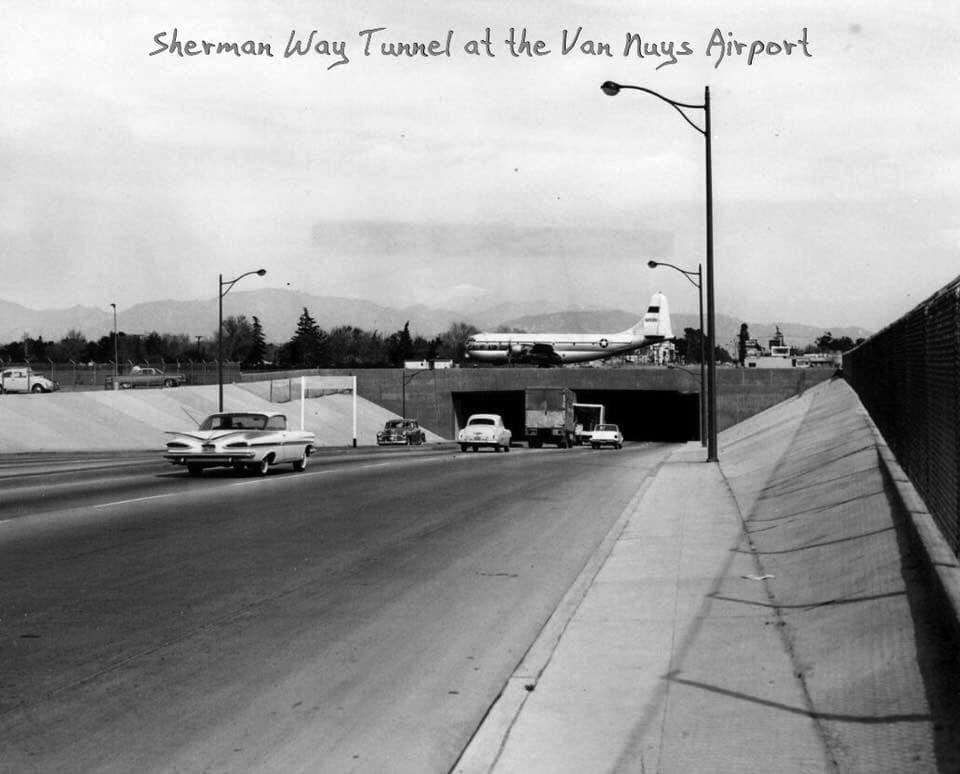 |
|
| (1959)^.^ - A C-97 taxis over the Sherman Way tunnel at the Van Nuys Airport. At left, a 1959 Chevrolet Coupe with its large tailfins is seen heading toward the tunnel. |
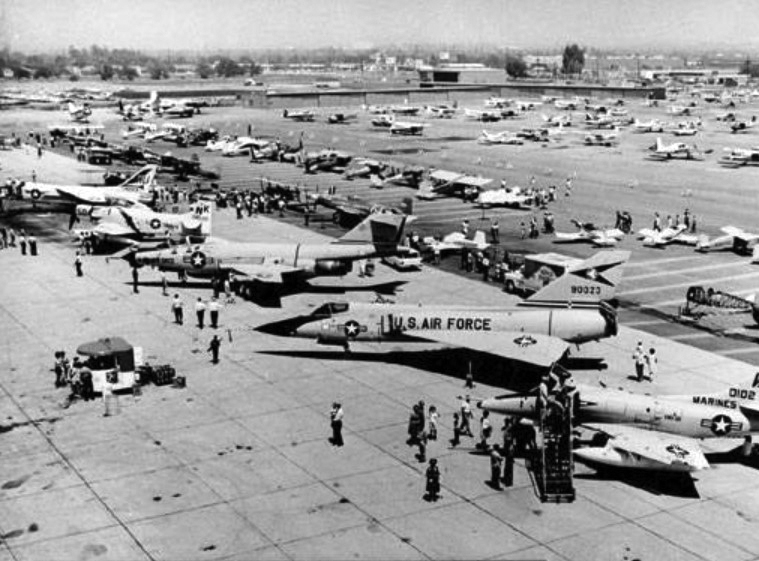 |
|
| (1965)#^** – View showing the Van Nuys Airport Air Show displaying the latest military aircraft including the: A-4, F-102, and F-1-1. Note the lack of high priced "millionaire" hangers that are in dominance today! |
Historical Notes The annual Van Nuys Airport Air Shows lasted nearly four decades until the Air Force stopped them mainly due to low turnouts and security problems. |
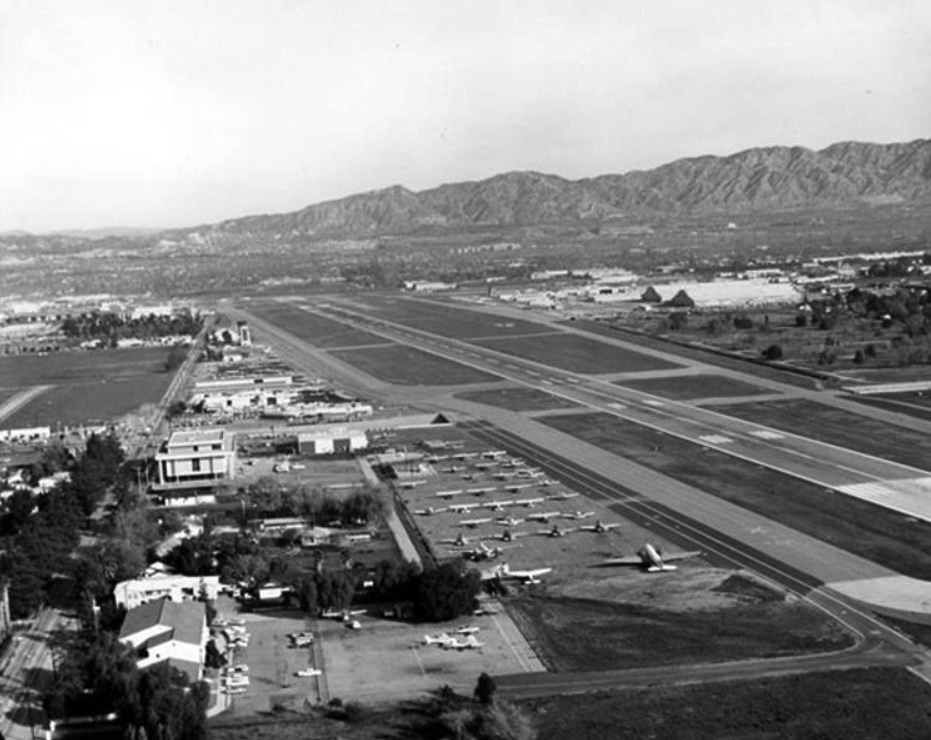 |
|
| (1966)^ – Aerial view looking north showing the Van Nuys Airport and the north end of the San Fernando Valley on a clear day. |
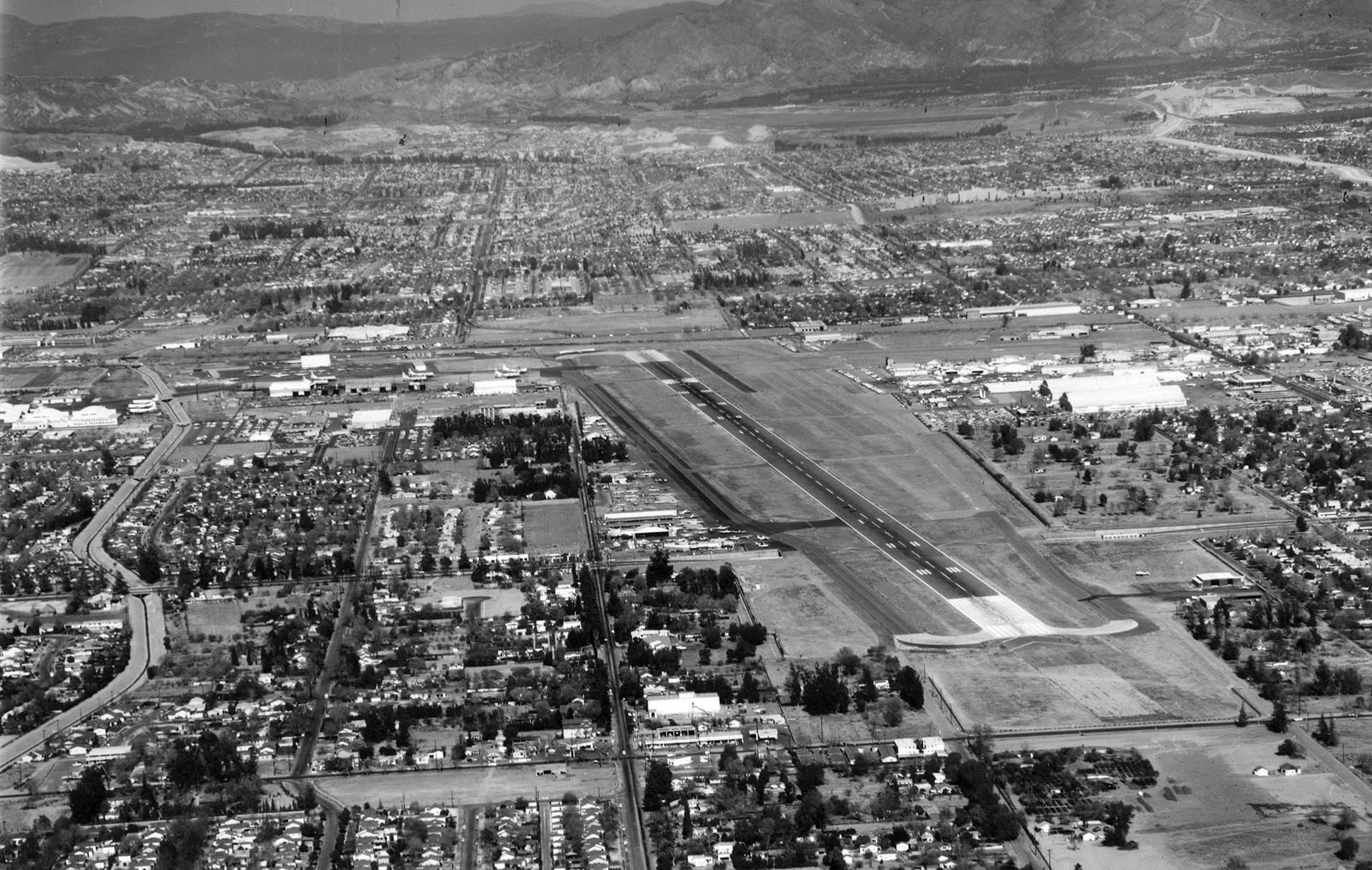 |
|
| (1968)^^# – Aerial view looking north showing Van Nuys Airport and surrounding area. |
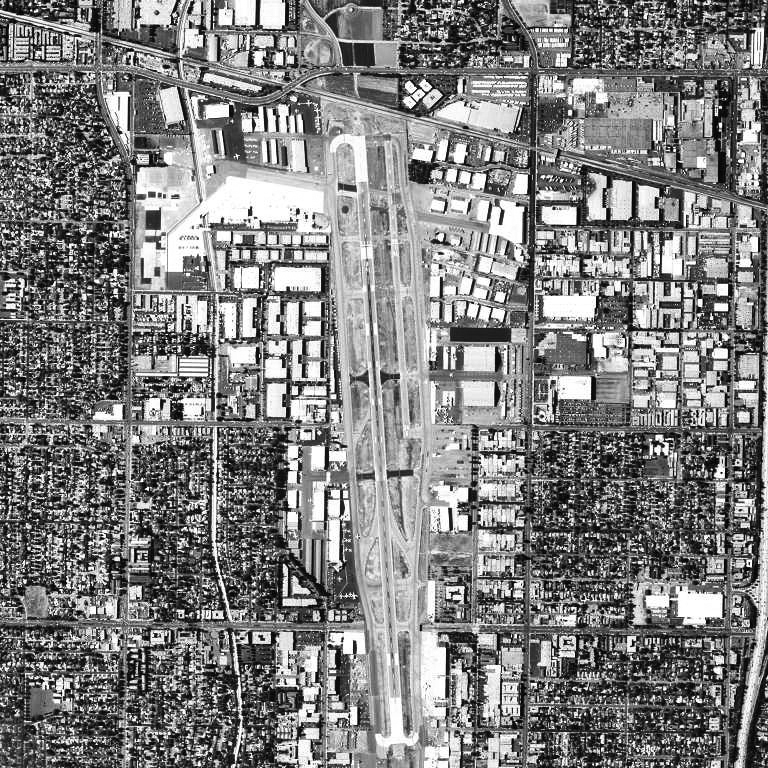 |
|
| (2006)*^ - Aerial view of Van Nuys airport as it appeared in 2006. |
Historical Notes Van Nuys Airport is owned and operated by Los Angeles World Airports. Through 2005, it was the busiest general aviation airport in the world (the second busiest being Phoenix Deer Valley Airport). In terms of takeoffs and landings, it was also the 25th busiest airport in the world. With two parallel runways, Van Nuys Airport handled 448,681 aircraft movements in 2005, averaging over 1,200 operations/day; in 2006 it handled 394,915 movements, nearly 1,100 per day. That’s amazing considering no major airlines fly into this airport. Los Angeles International Airport (with 4 runways and many airline flights) has roughly 1,700 operations a day.*^ |
 |
|
| (2017)* - Aerial view of Van Nuys Airport. Photo Van Nuys Airport |
 |
|
| (2014)* – The Pilot View - Night landing at Van Nuys Airport. |
* * * * * |
Whiteman Airport (aka Whiteman Air Park, Pacoima)
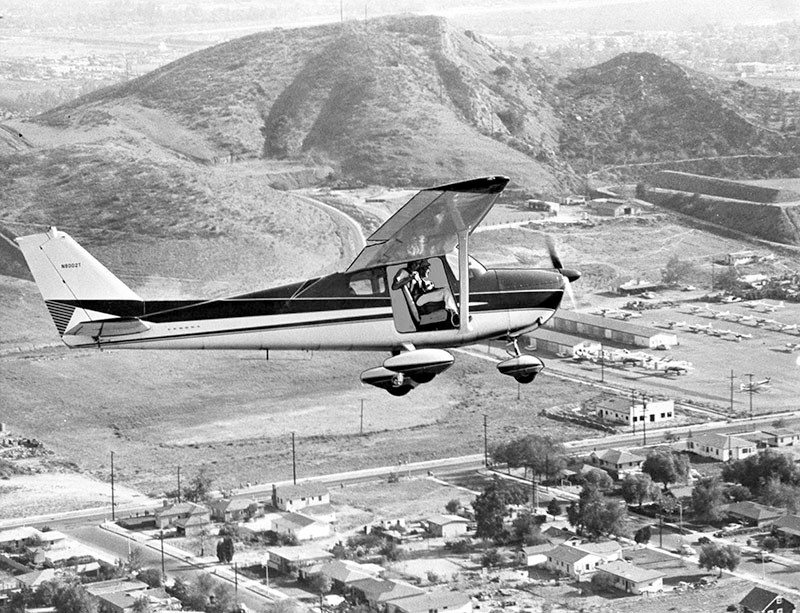 |
|
| (1960)* - View showing an airplane coming in for a landing at Whiteman Air Park located at San Fernando Road and Pierce Street in Pacoima. |
Historical Notes Whiteman Airport was founded as "Whiteman Air Park" in 1946 on a farm by pilot Marvin Whiteman Sr. as a non-tower controlled, private airport. Later Whiteman Manufacturing Co. was built on the airport's west side. In 1970 the airport was purchased by the County of Los Angeles. During the 1980s the name was changed to "Whiteman Airport", but it is still commonly referred to as "Whiteman Airpark" by old-time local pilots to this day. |
 |
|
| (1963)* - Ground view showing Whiteman Air Park in Pacoima. The 'Air Park' did not have a control tower at the time. |
Historical Notes In 1988, an FAA-approved and funded control tower was installed in Whiteman Airport. |
* * * * * |
From Clover Field to Santa Monica Airport
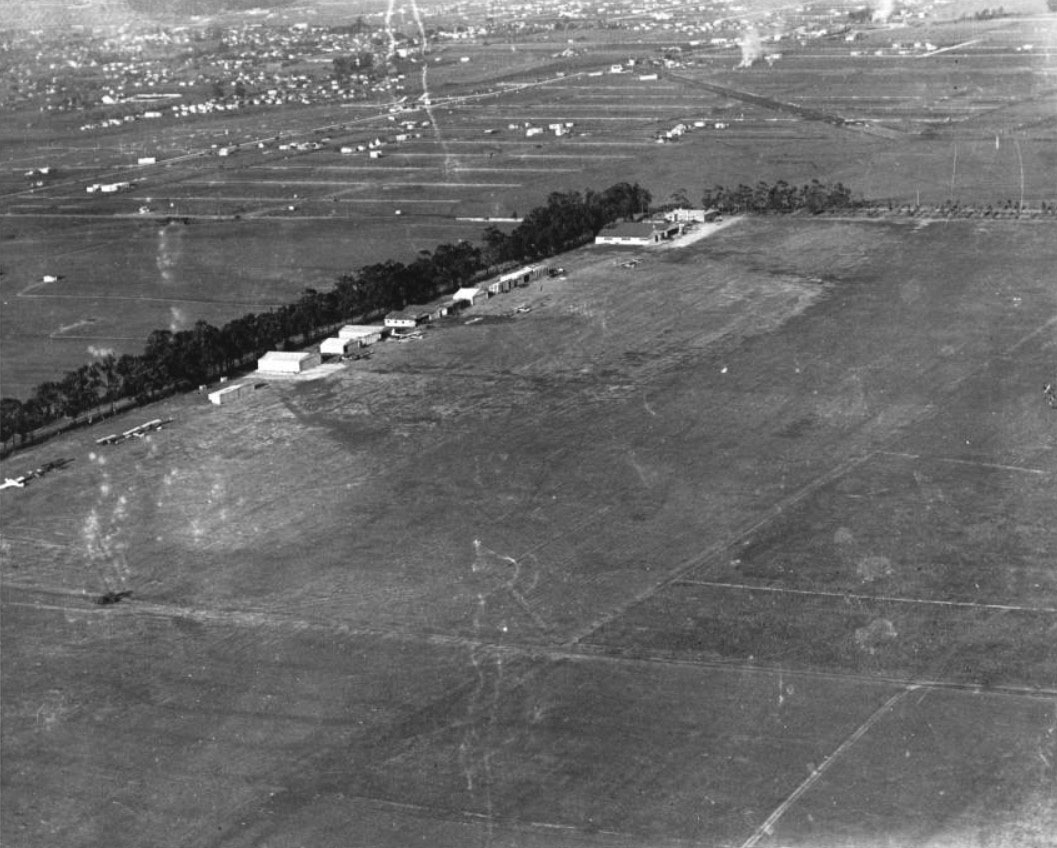 |
|
| (ca. 1924)* - Aerial view of Clover Field Airport in Santa Monica, showing residences in the distance. Hangars and other buildings are seen at center, amidst large expanses of open land. Several airplanes sit in the grass in front of and to the left of the buildings. A row of trees sits behind the building, running diagonally across the upper left corner of the image. |
Historical Notes As early as 1917, aviators were landing on this grassy runway perched atop a mesa just southeast of Santa Monica. It was surrounded by stalks of barley. Soon the landing strip became a military airfield, and in 1922 the U.S. Army named it Clover Field in honor of Greayer Clover, a fighter pilot killed in France during the First World War. Since then the site has served many purposes. First it was the western headquarters of the Army’s reserve air corps, and later Douglas Aircraft produced its line of DC planes there. |
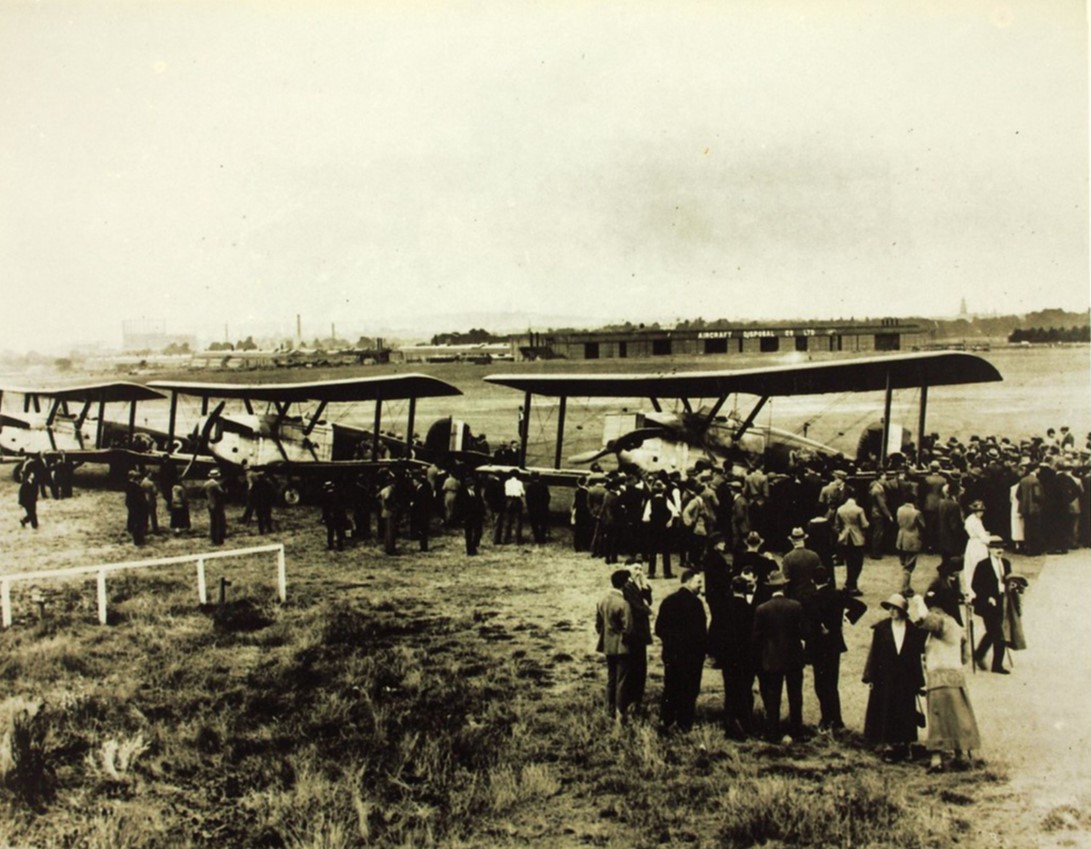 |
|
| (1924)* - A growing crowd of spectators at Clover Field inspect the World Cruisers before their epic flight. |
Historical Notes Clover Field, now known as Santa Monica Airport, played a pivotal role in the first aerial circumnavigation of the world in 1924. As the home base of the Douglas Aircraft Company, it was where the four Douglas World Cruisers—Seattle, Chicago, Boston, and New Orleans—were built and prepared for their historic journey. On March 17, 1924, these aircraft took off from Clover Field for a preliminary flight, marking the unofficial start of their global expedition. Although the official circumnavigation began on April 6 from Seattle, Clover Field's contribution was significant enough to warrant a historical marker commemorating it as the "Site of the first round the world flight." This event not only solidified Clover Field's place in aviation history but also contributed to its reputation as a hub for pioneering developments in flight. The airport's involvement in this milestone is memorialized in Santa Monica's urban landscape through Cloverfield Boulevard, serving as a lasting reminder of the area's crucial role in this groundbreaking achievement in aviation history. |
_Filtered2.jpeg) |
|
| (1924)* - On This Day: September 23, 1924 Douglas Aircraft's World Cruiser airplanes return to Clover Field following the first around the world flight. |
Historical Notes Two planes made it back, after having covered 27,553 miles in 175 days, and were greeted on their return September 23, 1924 by a crowd of 175,000 (likely an overestimate). Clover Field played a pivotal role in the return of the Douglas World Cruiser aircraft during their historic global circumnavigation. On September 23, 1924, the surviving aircraft, Chicago and New Orleans, landed at the Santa Monica airfield to a hero's welcome, with an estimated 175,000 people gathering to celebrate their achievement. As the original home of the Douglas Aircraft Company where the planes were designed and built, Clover Field was more than just a refueling stop—it was a symbolic homecoming. The crowds were so enthusiastic that they surrounded the aircraft, making immediate refueling impossible. Donald Douglas himself wanted to celebrate the achievement in Santa Monica before the final leg to Seattle, underscoring the field's importance in this historic moment. This triumphant return to Clover Field not only marked a significant milestone in aviation history but also highlighted the crucial role of Santa Monica and the Douglas Aircraft Company in pushing the boundaries of long-distance flight in the early 20th century. |
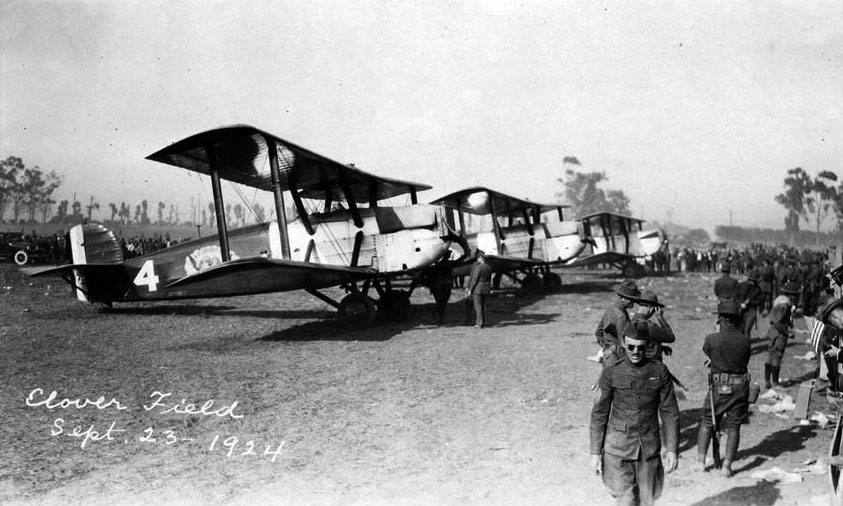 |
|
| (1924)* - Douglas World Cruisers return to Clover Field, Santa Monica, CA on September 23rd, 1924. |
Historical Notes On Sept. 23, two of the pioneering planes returned, completing the first aerial circumnavigation of the world. Of the four planes that began the journey, only two completed it, covering 27,553 miles in 175 days. The planes were piloted by a team from the United States Army Air Service, the precursor to the United States Air Force. |
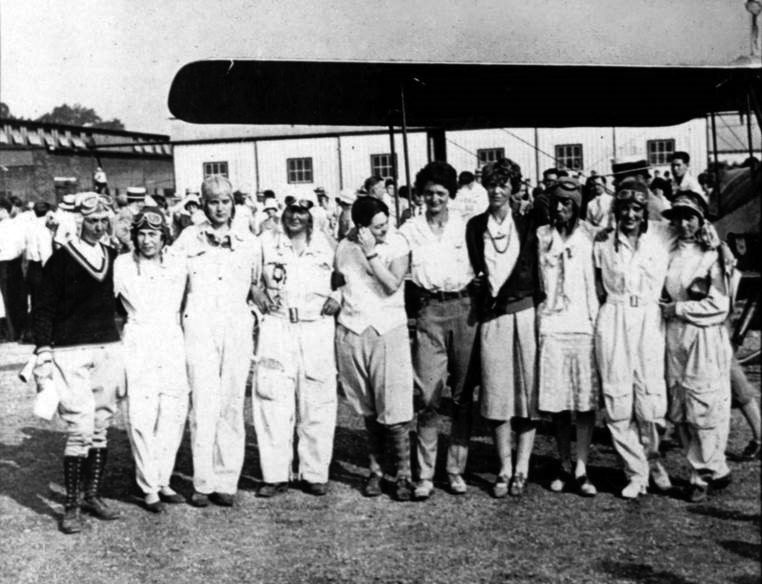 |
|
| (1929)* – View showing some of the female aviators who competed in the first women’s transcontinental air derby which began in Santa Monica on August 18, 1929. Amelia Earhart is fourth from the right. Louise Thaden, who won the 2700-mile race, is fifth from the right. |
Historical Notes In August 1929, seventy women held a United States pilot’s license. Of those, twenty young female aviators assembled at Clover Field on the afternoon of August 18 to take part in the groundbreaking competition. Navigating the 2700-mile course with only road maps on their laps, the women flew from Santa Monica to Cleveland via stops in Arizona, New Mexico, Texas, Oklahoma, Kansas, Missouri, Illinois and Indiana. Along the way, there were continuous mishaps and a constant need for maintenance. Some competitors were forced to drop out of the race. Florence “Pancho” Barnes and Ruth Nichols crashed their aircraft. Margaret Perry contracted typhoid fever. Claire Fahy’s plane was found to have suspicious mechanical damage. Sadly, pilot Marvel Crosson, who had just set an altitude record at 23,996 feet the previous May, perished in a tragic crash. The race continued despite these perils, malfunctions and calamities. And at every stop, enthusiastic crowds gathered to meet the female flyers they had read about in the press. At the Cleveland Municipal Airport, a throng estimated at 18,000 people greeted the pilots as they finished the race. Louise Thaden came in first, and she was followed by fourteen others: Amelia Earhart, Ruth Elder, Edith Foltz, Mary Hazlip, Jessie Keith-Miller, Opal Kunz, Blanche Noyes, Gladys O’Donnell, Phoebe Omlie, Neva Paris, Thea Rasche, Bobbi Trout (finished untimed because of two forced landings), Mary von Mach, and Vera Dawn Walker. The Air Derby set the stage for other major air race competitions for women and supported the notion, highly suspect at the time, that women could be accomplished pilots. The race also strengthened the bonds between the participants and inspired them to organize. A few months later in 1929, most of these female aviators became founding members of The Ninety-Nines, an organization of licensed women pilots founded to promote and support women in aviation. |
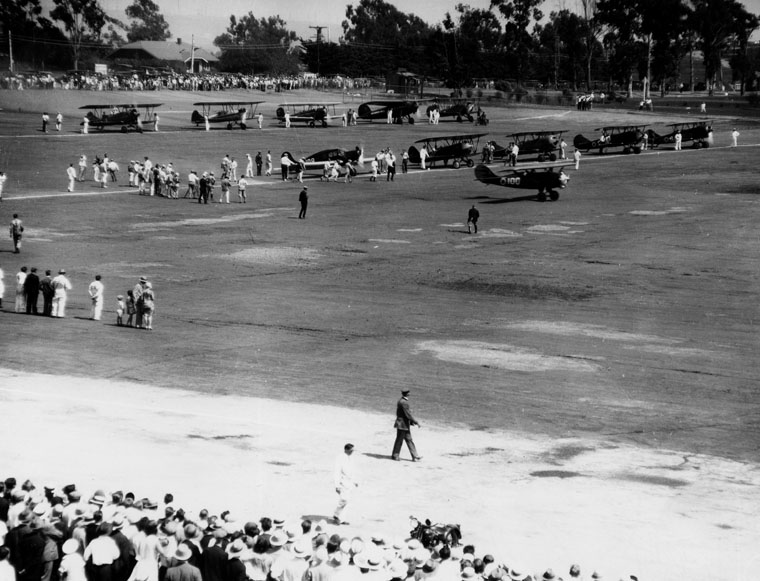 |
|
| (1929)* - Crowds gathered on the sides of Clover Field (Santa Monica Airport) to watch the air show. Several planes are parked on the field, waiting their turns to takeoff. |
Historical Notes On June 15, 1927 Santa Monica City Council changed the name of Clover Field to Santa Monica Airport (SMO). In 1928, the City acquired an additional 60 acres to expand the Airport and to accommodate an expanding Douglas plant. |
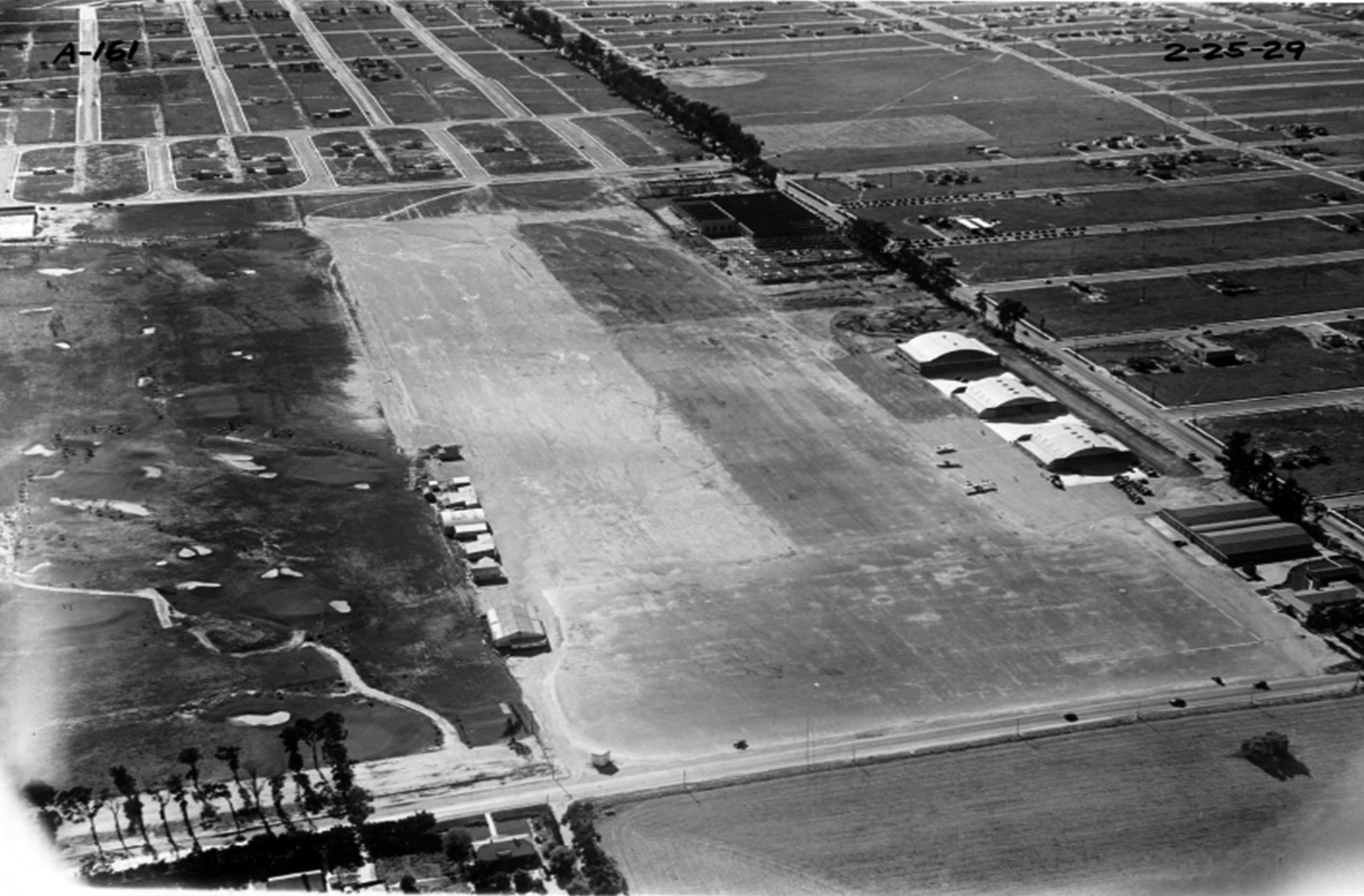 |
|
| (1929)* - View showing the Santa Monica Airport (previously named Clover Field). The Douglas Aircraft plant can be seen on the right. |
Historical Notes Donald Wills Douglas, Sr. founded the Douglas Aircraft Company in 1921 with his first plant on Wilshire Boulevard. He built a plant in 1922 at Clover Field (Santa Monica Airport), which was in use for 46 years. In 1924, four Douglas-built planes took off from Clover Field to attempt the first aerial circumnavigation of the world. Two planes made it back, after having covered 27,553 miles in 175 days, and were greeted on their return September 23, 1924 by a crowd of 200,000 (generously estimated). In 1929, Douglas enlarged its Santa Monica Airport operations, closed other facilities, and began to develop its early DC-2 and DC-3 airliners as well as other projects. |
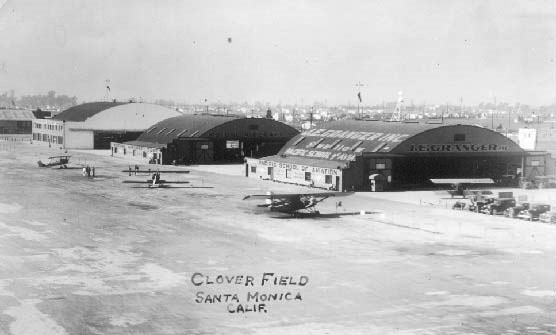 |
|
| (1930s)* – Close-up view of the original three big hangars on the north side of Clover Field. The large hangar at the back is the first Douglas Aviation hangar on the field, circa early 30's. |
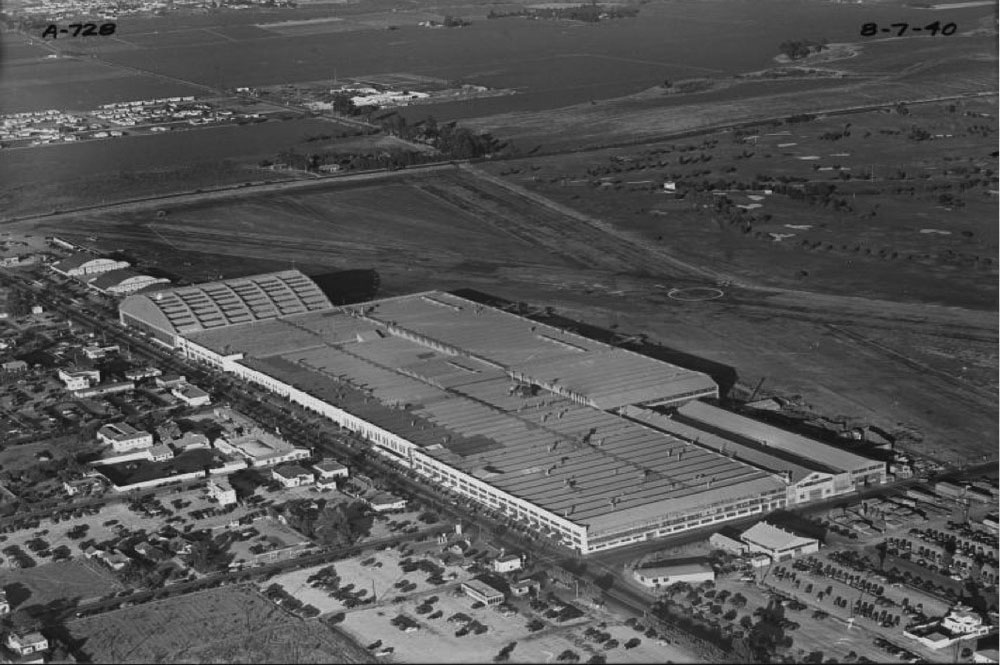 |
|
| (1940)* – Aerial view of the Santa Monica Airport looking towards the southeast with the Douglas plant filling the bottom half of the photo. Photo Date: August 7, 1940 |
Historical Notes Between 1941 and 1944 (During World War II), Douglas Aircraft becomes a major defense contractor, employing up to 44,000 workers who work three shifts, seven days a week. This economic engine transforms the city as thousands of new homes are built for the Douglas workers, creating Sunset Park and other neighborhoods. |
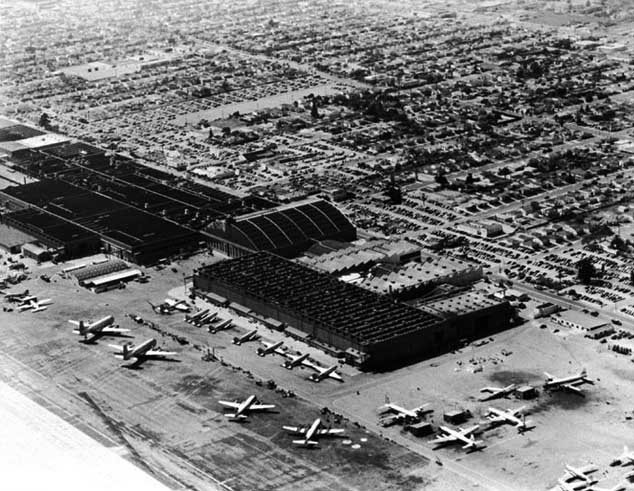 |
|
| (1940s)* - View of Douglas Aircraft with numerous planes positioned all around its plant. The surrounding neighborhood has been built up when compared to previous photo. |
Historical Notes Douglas Aircraft Co. was a major player in the aircraft industry during World War II. Local historians note that World War II affected Santa Monica more than most places, as the Federal Government (for national security reasons) leased the Airport from the City to provide protection for Douglas Aircraft – then a major defense contractor located in Sunset Park. The government also participated in the expansion of the facility to accommodate the ever-growing production of military aircraft by Douglas Aircraft. |
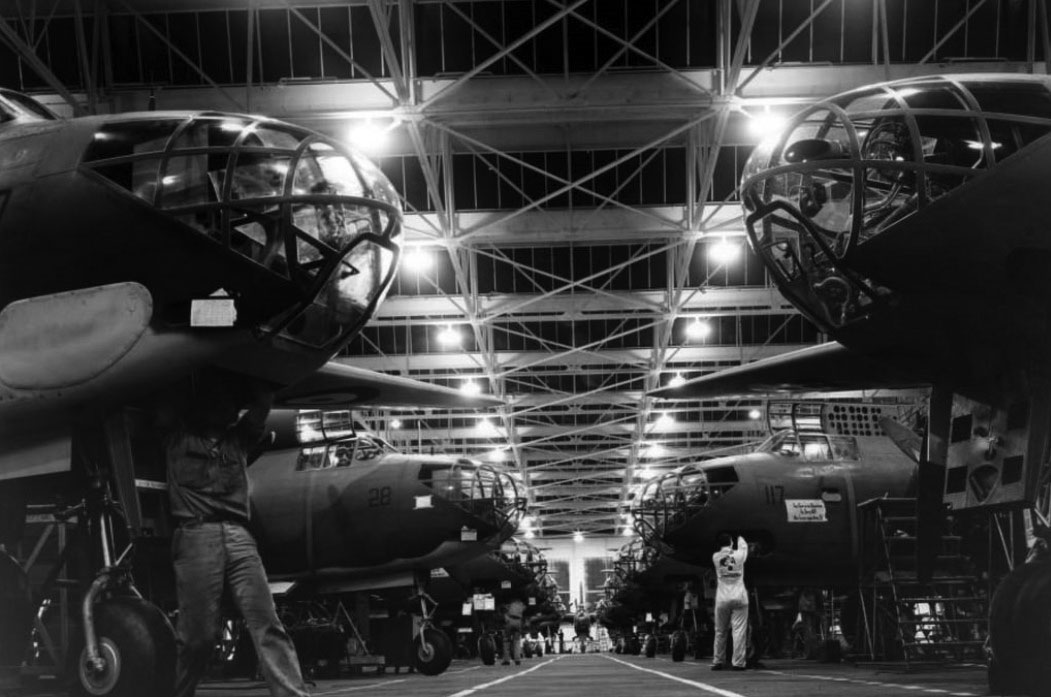 |
|
| (1940s)* – View showing night production of fighters at Douglas Aircraft Company's assembly plant in Santa Monica. |
Historical Notes Santa Monica CA- Along brilliantly lit assembly lines of Douglas Aircraft Company’s plant here, night crews are rushing production of DB-7B attackers bombers, recently acclaimed as night fighters in the defense of blacked out Britain. Equipped with heavy armament self-sealing fuel tanks and armor plating, these ships are proving swift and deadly in interception and downing Nazi raiders. R.A.F. early designated the DB-7 type the Boston and more recent the Havoc. Under a backlog in excess of $400,000,000 nearly 28,000 Douglas employees are working around the clock on attack ships, dive bombers and military transports for Americans and Britain. |
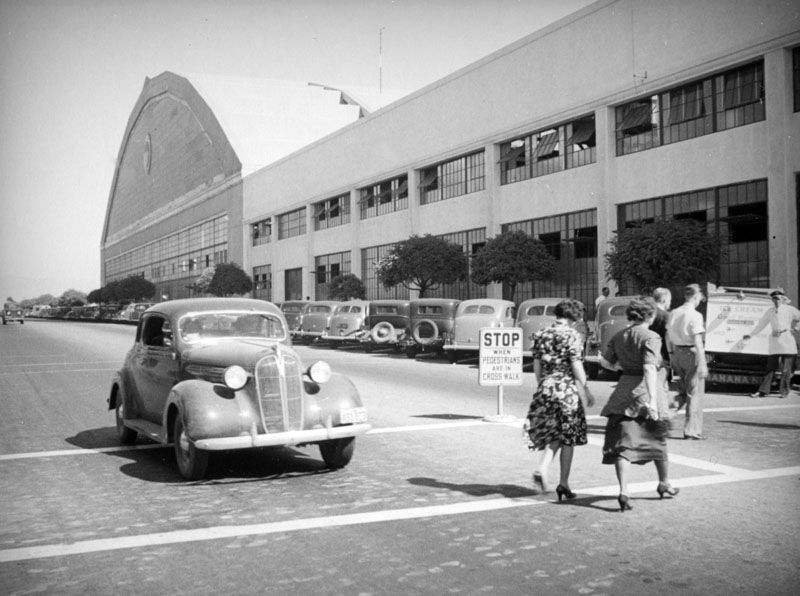 |
|
| (ca. 1940)* - An impatient car starts across the crosswalk while men and women are still crossing towards the Douglas Aircraft Company factory, located at 2700 Ocean Park Boulevard, Santa Monica. An ice cream truck is parked and the attendant is ready to catch workers as they return to work. |
Historical Notes At its peak, Douglas Aircraft, and Santa Monica Airport grew in size to its present 227 acres, employing 40,000 individuals. |
 |
|
| (ca. 1945)* - Playing such a vital role in military aircraft production during World War II, camouflage was used to make the plant and airstrip disappear - at least from the air. |
Historical Notes During the war the airport area was cleverly disguised from the air with the construction of a false "town" (built with the help of Hollywood craftsman) suspended atop it. |
 |
|
| (ca. 1950)* – Santa Monica Airport with the Douglas Aircraft plant seen at right. |
Historical Notes Clover Field (Santa Monica Airport) was once the site of the Army’s 40th Division Aviation, 115th Observation Squadron and became a Distribution Center after World War II. After World War II, Douglas Aircraft at Santa Monica Airport experienced a dramatic transformation. Having been a critical wartime manufacturer that produced nearly 30,000 aircraft and employed 160,000 workers, the company sought to pivot back to commercial aviation in the late 1940s and early 1950s. However, a pivotal moment came in 1958 when the city of Santa Monica refused Douglas's request to extend the airport runway for producing and testing the DC-8 jetliner. This decision prompted Douglas to close its Santa Monica plant, which had been a cornerstone of local industry, and relocate airliner production to Long Beach Airport. The departure marked the end of an era for Santa Monica Airport, which transitioned from a major aircraft manufacturing center to a general aviation facility serving business, training, and personal aircraft. In 1968, the Federal Aviation Administration formalized the airport's new role through a contract that committed the land to aviation services until 1988. This shift represented a significant change from the airport's previous status, where it had been responsible for manufacturing 90% of commercial air travel aircraft during the 1930s and 1940s, to a more localized aviation support role in the Greater Los Angeles area. |
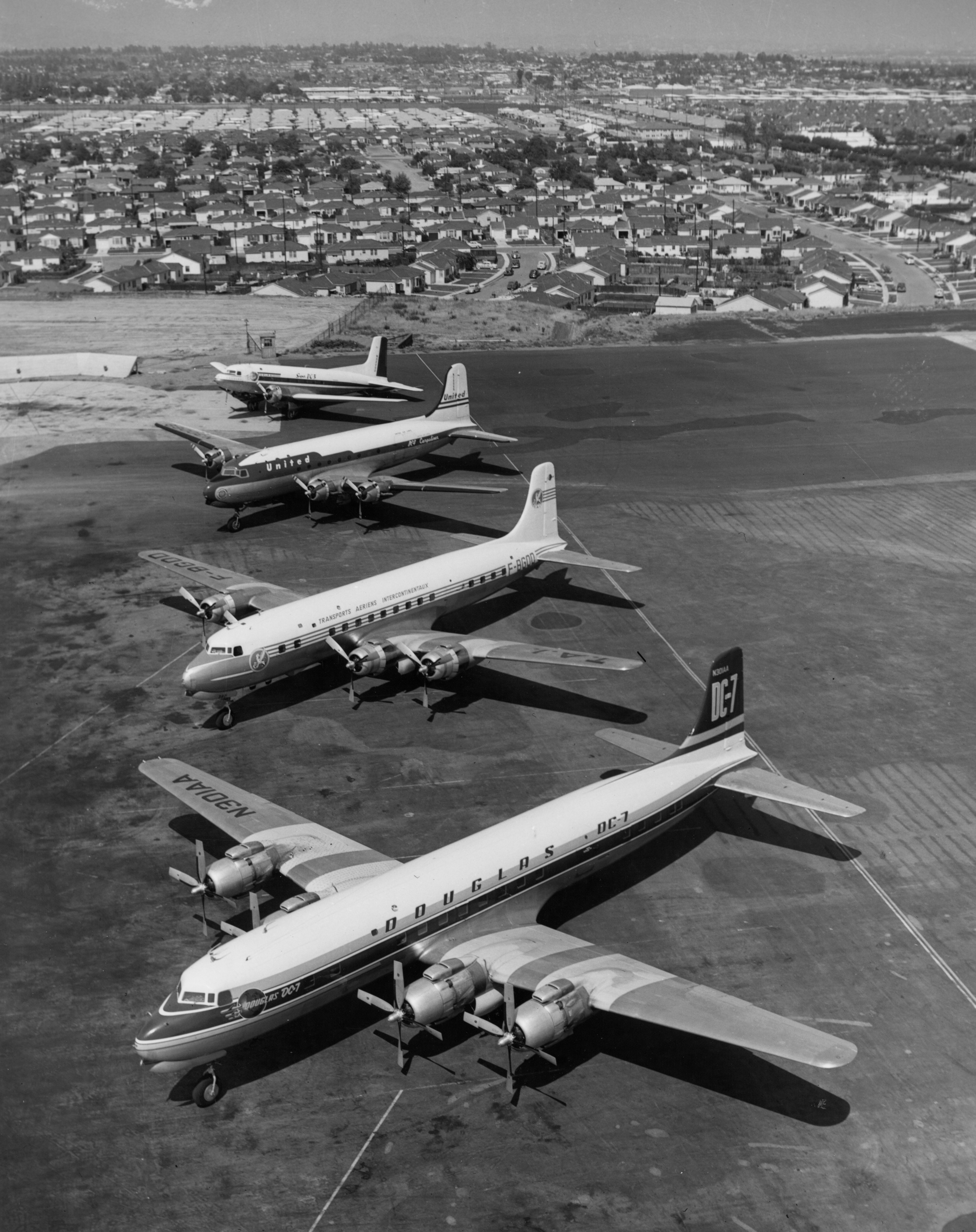 |
|
| (1953)*- Douglas DC-3, DC-4, DC-6, DC-7 lined up on the NE end of the Santa Monica Airport. The view is looking towards the east. |
Historical Notes In the 1950s, Santa Monica Airport underwent a significant transformation as it transitioned from a major aircraft manufacturing hub to a general aviation facility. The decade was marked by the departure of Douglas Aircraft, which closed its Santa Monica plant in 1958 after the city refused to lengthen the runway for the production of the DC-8, despite the company's historical significance at the airport. Douglas had previously employed tens of thousands of workers during World War II and dominated commercial aviation during the 1930s and 1940s. Following Douglas's exit, Santa Monica Airport shifted its focus to general aviation, accommodating business and personal aircraft, as well as flight training operations. In 1968, the Federal Aviation Administration (FAA) entered into a contract with the city, stipulating that airport land be used exclusively for aviation services until 1988, which included fuel services and aircraft maintenance. This period marked a notable shift in the airport's role within the Greater Los Angeles area, moving away from large-scale aircraft production to serving local aviation needs. |
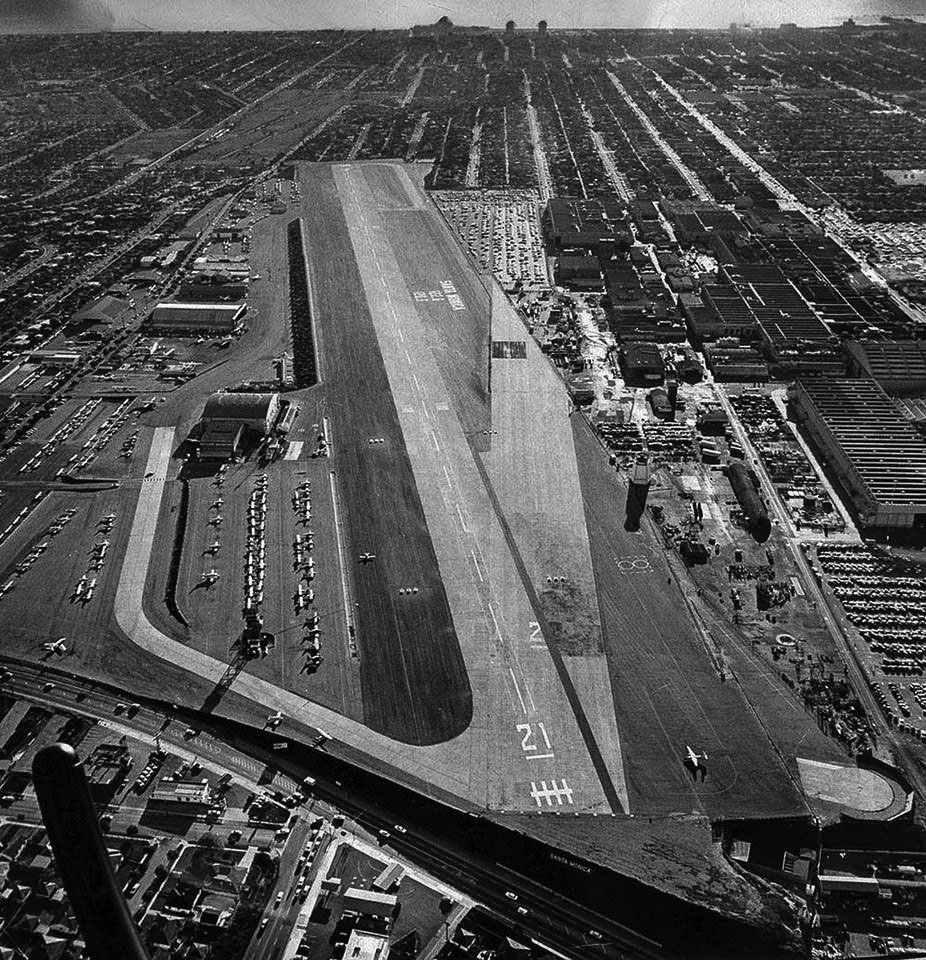 |
|
| (1967)* – Aerial view looking west toward the Pacific Ocean showing Santa Monica Airport. The Douglas Aircraft plant is on the right. |
Historical Notes In later years, Douglas Aircraft merged with a rival to become McDonnell-Douglas Corporation (1967) and moved to Long Beach (1976). The 5,000-foot runway at what was by then known as Santa Monica Airport was too short for the firm's growing jet production. Two decades later, McDonnell-Douglas would be absorbed by yet another rival, Boeing Company. When the corporation left town, Douglas' son, Donald Wills Douglas Jr, set up the Donald Douglas Museum and Library to commemorate his father's legacy. Douglas Sr. died in 1981. Nine years later, the nonprofit Museum of Flying, founded by golf course and real estate developer David Price, superseded the old museum as part of a $20-million airport overhaul. Exhibits included vintage planes and an immense photo of when the airport and plant operated under cover of camouflage. |
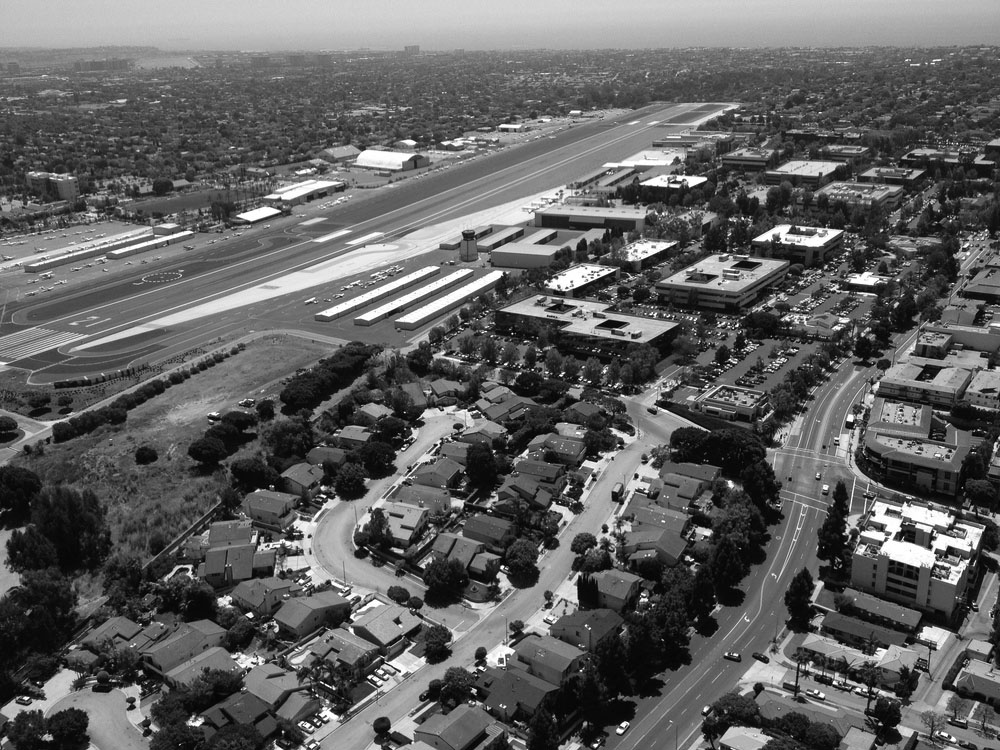 |
|
| (2014)* - Santa Monica Airport (SMO) as it appears today. |
Historical Notes On January 28, 2017, it was announced that Santa Monica City officials and the Federal Aviation Administration had reached an agreement to close the Santa Monica Airport on December 31, 2028 and return 227 acres of aviation land to the city for eventual redevelopment. It is anticipated that the airport land will be redeveloped into areas for parks, open space, recreation, education and/or cultural use. In an attempt to reduce jet traffic, the city planned to shorten the runway from 4,973 feet to 3500 feet by repainting the runway and moving some navigational aids. The shortening has been formally completed as of 2017 December 23. |
* * * * * |
Hughes Airport (Culver City / Playa Vista)
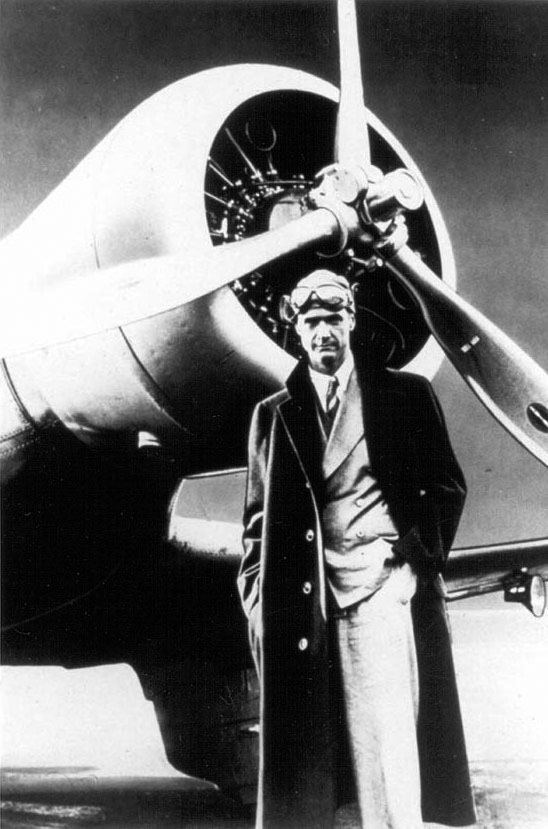 |
(1934)**^# - Howard Hughes at Playa Vista.
|
Historical Notes Howard Hughes was a lifelong aircraft enthusiast and pilot. At Rogers Airport in Los Angeles, he learned to fly from pioneer aviators, including Moye Stephens. He set many world records and commissioned the construction of custom aircraft for himself while heading Hughes Aircraft at the airport in Glendale. Operating from there, the most technologically important aircraft he commissioned was the Hughes H-1 Racer.*^ |
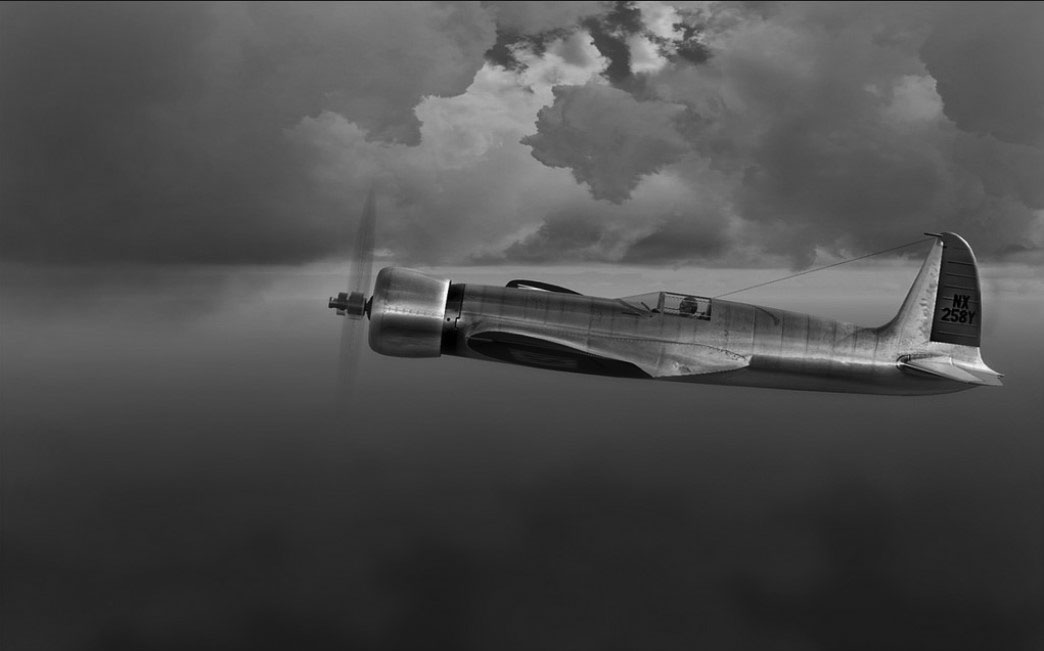 |
|
| (1935)#^ – View showing the Hughes H-1 Racer in flight. It set a world airspeed record and a transcontinental speed record across the United States. |
Historical Notes During his work on his movie Hell's Angels, Howard Hughes employed Glenn Odekirk to maintain the fleet of over 100 aircraft used in the production. The two men shared a common interest in aviation and hatched a plan to build a record-beating aircraft. The aircraft was given many names, but is commonly known as the H-1. It was the first aircraft model produced by the Hughes Aircraft company.*^ The original H-1 Racer was donated to the Smithsonian in 1975 and is on display at the National Air and Space Museum. |
 |
|
| (ca. 1935)* - Early photo of Howard Hughes standing in front of his H-1 Racer. |
Historical Notes On September 13, 1935, Hughes, flying the H-1, set the landplane airspeed record of 352 mph over his test course near Santa Ana, California. A year and a half later, on January 19, 1937, flying the same H-1 Racer fitted with longer wings, Hughes set a new transcontinental airspeed record by flying non-stop from Los Angeles to Newark in 7 hours, 28 minutes and 25 seconds (beating his own previous record of 9 hours, 27 minutes). His average ground speed over the flight was 322 mph. The H-1 Racer was the last aircraft built by a private individual to set the world speed record; every aircraft to hold the honor since has been a military design.*^ |
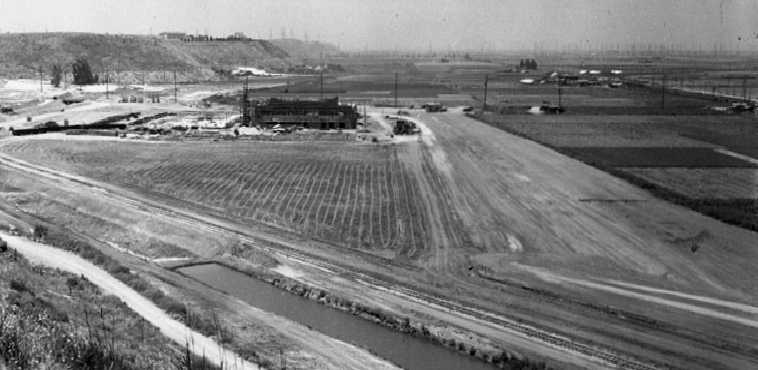 |
|
| (1941)*# - Aerial view looking west showing he Hughes plant under construction and the runway on the right side. |
Historical Notes By 1939 the Hughes Tool Company was engaged in a full-scale program to develop a high speed fighter bomber using Duramold plywood, a plastic-bonded plywood molded under heat & high pressure. This became the DX-2, later known simply as the D-2. To build the D-2, the Burbank facility would be insufficient, and Hughes sought a much larger facility than what at the time he was renting from the Lockheed Company in Burbank. In 1940 Hughes purchased 380 acres (although other sources put the initial purchase as over 1,000 acres) of the Ballona Wetlands just west of Culver City for $500,000. Hughes recognized the area as one of the few large tracts of remaining undeveloped land in Los Angeles. The high water table made it necessary to sink 50' pilings into the wetlands to support Hughes’ buildings & reroute the course of the Centinela River, which flowed through the site every spring & flooded it. On his new land Hughes constructed a 60,000 square foot air conditioned, humidity-controlled aircraft plant with an adjacent grass runway.*# Little known fact: The Los Angeles River was originally alluvial, meaning its banks and bed were formed from loose sediments and rock that allowed it to change its path depending on water flow and season. Up until the early 1800's, the river actually flowed into the Pacific near Marina Del Ray (Ballona Wetlands), but a particularly severe flash flood in 1825 diverted the river all the way to Long Beach, where it has remained since.**^ |
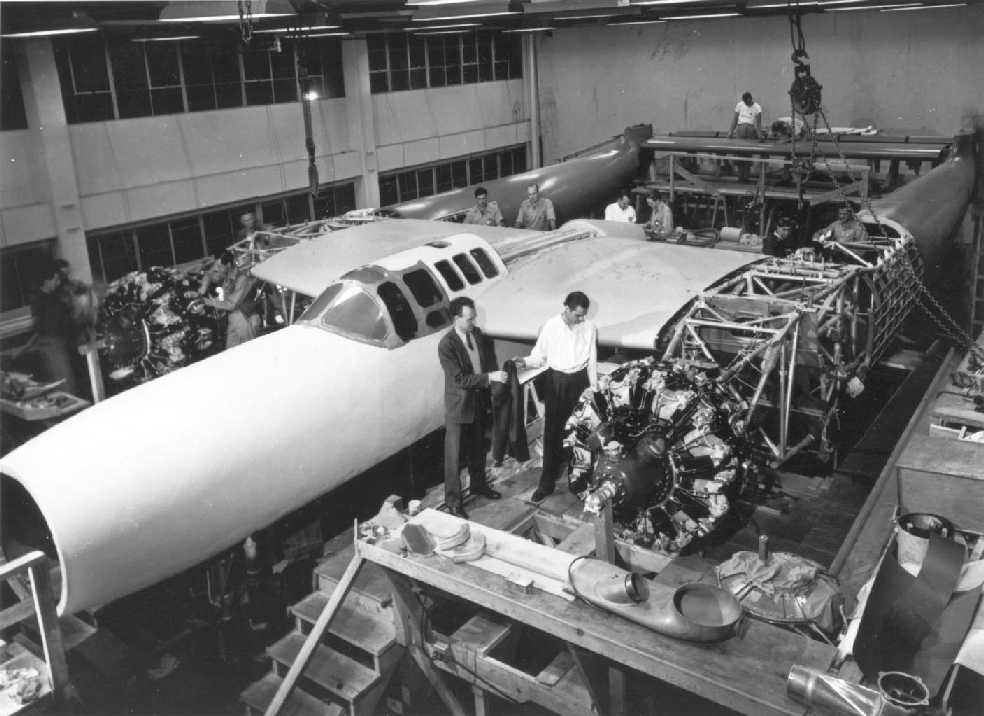 |
|
| (ca. 1942)*# - Photo of Howard Hughes inspecting the prototype of the Hughes D-2 in the Hughes Culver City factory. |
Historical Notes The D-2 was built in secret at the Hughes Culver City factory with longtime Hughes associate, Glenn Odekirk, providing engineering inputs. The fighter that emerged from the Hughes experimental shop looked like a scaled-up P-38 Lightning and, on paper, sported similar performance potential. The D-2 had a twin-boom configuration, powered by a pair of 2,000 hp Pratt & Whitney R-2800s.*# |
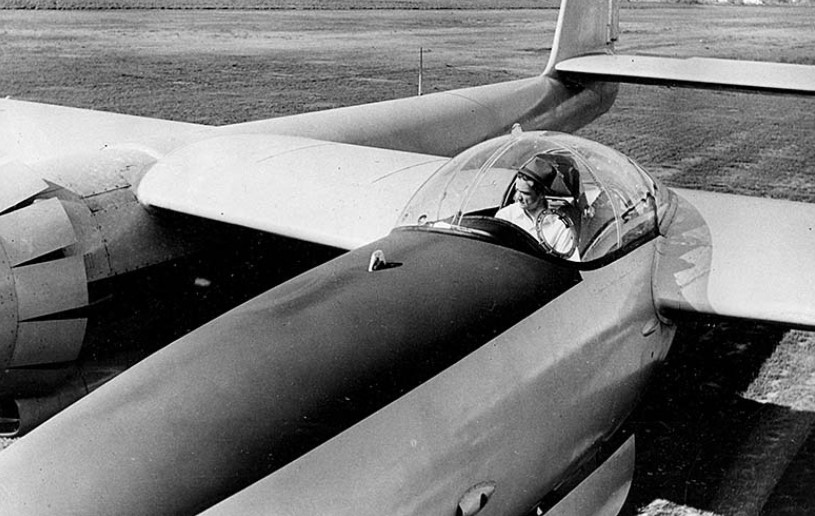 |
|
| (1946)#^ - American industrialist and aviator Howard Hughes sits in the cockpit of his new XF-11. The plane was built in conjunction with the U.S. Army Air Force and designed especially for photo reconnaissance work. |
Historical Notes Shortly after Howard Hughes took off in the first XF-11 prototype from the Culver City runway on July 7, 1946, one of the propellers inadvertently went into reverse thrust, sending the craft out of control. The XF-11 crashed into a house in Beverly Hills, severely injuring Howard Hughes.*# |
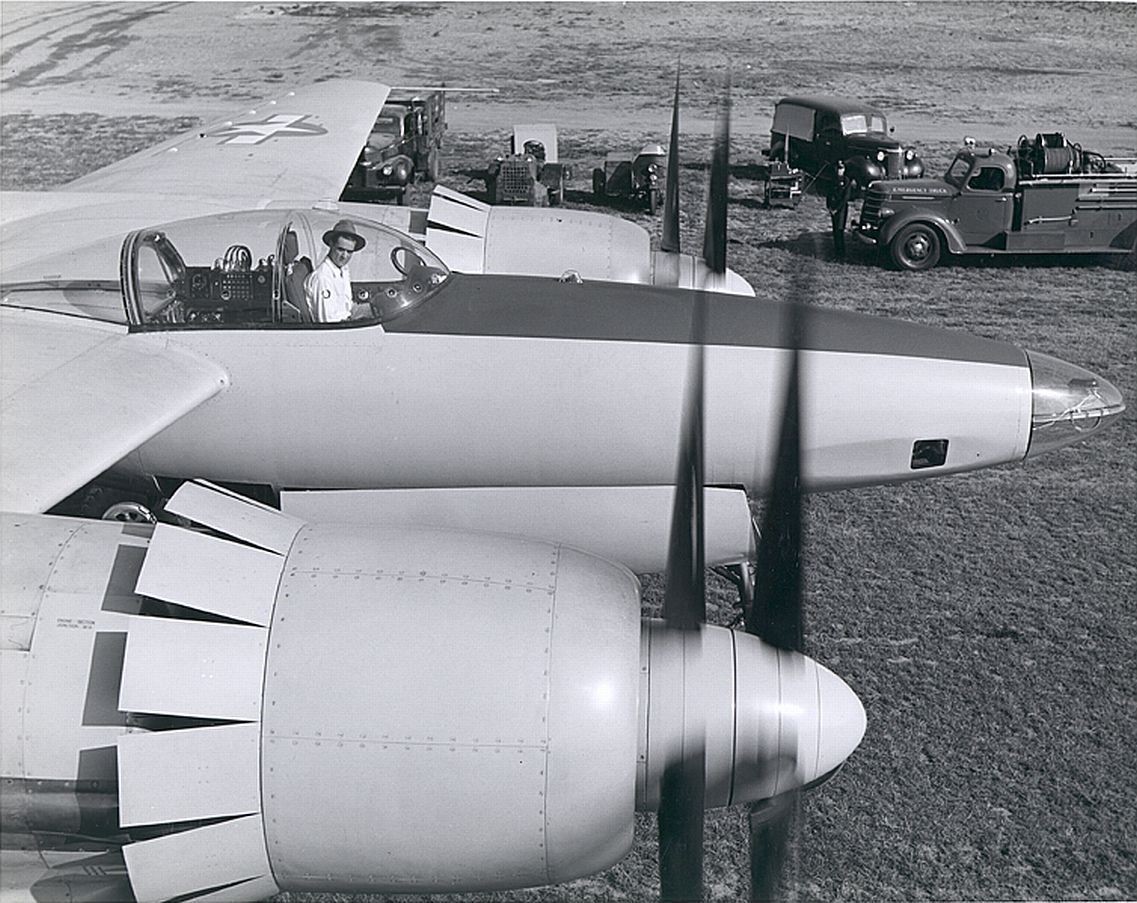 |
|
| (1946)^ - View showing Howard Hughes in his XF-11 reconance plane. |
Historical Notes This expirmental plane crashed in Beverly Hills nearly killing Howard. One of the counter rotating props gearbox kept looking oil during taxi testing but Howard decided to fly it anyway. Suddenly the prop reverse pitched causing huge drag. Had Howard shut off that engine he could have landed. He also kept the plane up flying much longer than planned. He was never supposed to retract the landing gear or fly for the length he did. Ground crew told him to bring it in but he was Howard Hughes. He lived how he wanted. Plane was the XF11 reconance plane. The rebuild did not have the same counter rotating props. It had two of the 28 cylinder corn cob engines like the Hurculese Flying Boat and the Spruce Goose. |
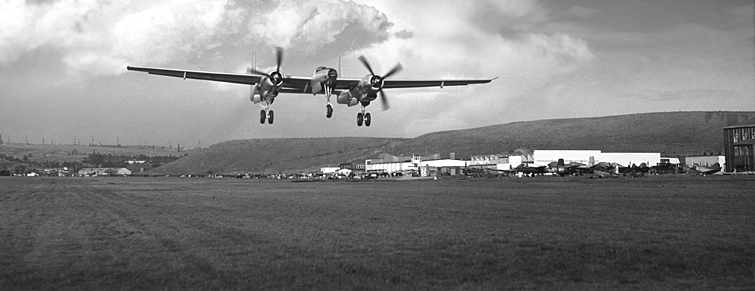 |
|
| (1947)*# - The 2nd prototype of the Hughes XF-11 takes off from Culver City on April 4, 1947. It had been fitted with conventional 4-bladed propellers, addressing the 1st prototype's fatal flaw. |
 |
|
| (ca. 1940s)*# - View showing a wing of the Hughes HK-1 Hercules ('Spruce Goose') flying boat under construction within the Culver City assembly building. |
Historical Notes The 'Spruce Goose,' officially known as the Hughes HK-1 Hercules, was built and stored here. A full-time crew of 300 workers, all sworn to secrecy, maintained the plane in flying condition in a climate-controlled hangar at Hughes Airport. The crew was reduced to 50 workers in 1962, and then disbanded after Hughes' death in 1976. By the mid-1990s, the former Hughes Aircraft hangars here, including the one that held the Hercules, were converted into sound stages. Scenes from movies such as Titanic, What Women Want, and End of Days have been filmed in the 315,000-square-foot aircraft hangar where Hughes created the flying boat. It also features in the computer Game "Crimson Skies". The hangar will be preserved as a structure eligible for listing in the National Register of Historic Buildings.*^ |
Spruce Goose
 |
|
| (1940s)++# - Interior view of the 'Spruce Goose' fuselage. |
Historical Notes The 'Spruce Goose' was the brainchild of Henry J. Kaiser, a leading Liberty ship builder. He teamed with aircraft designer Howard Hughes to create what would become the largest aircraft built at that time. It was designed to be capable of carrying 750 fully equipped troops or one M4 Sherman tank. The original designation "HK-1" reflected the Hughes and Kaiser collaboration.*^ |
 |
|
| (1944)^*# - Fuselage of H-4 (‘Spruce Goose’) peeking out of the west door on the north side of building 15. |
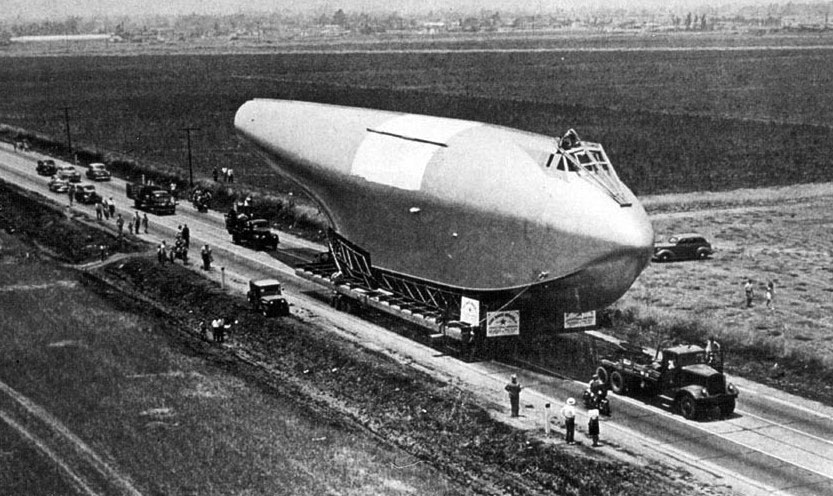 |
|
| (1944)**^# – View showing the 'Spruce Goose' shortly after exiting its hangar at Playa Vista. |
 |
|
| (1947)^^## - View showing a police escort for the 'Spruce Goose' to the Harbor. |
Historical Notes The Hughes H-4 Hercules was originally contracted by the U.S. government for use during World War II to transport troops and equipment across the Atlantic as an alternative to sea-going troop transport ships that were vulnerable to German U-boats. However the aircraft was not completed until after the end of World War II. The concept for the Hercules was originally conceived by industrialist Henry J. Kaiser, who teamed with Hughes to build the aircraft.*^ |
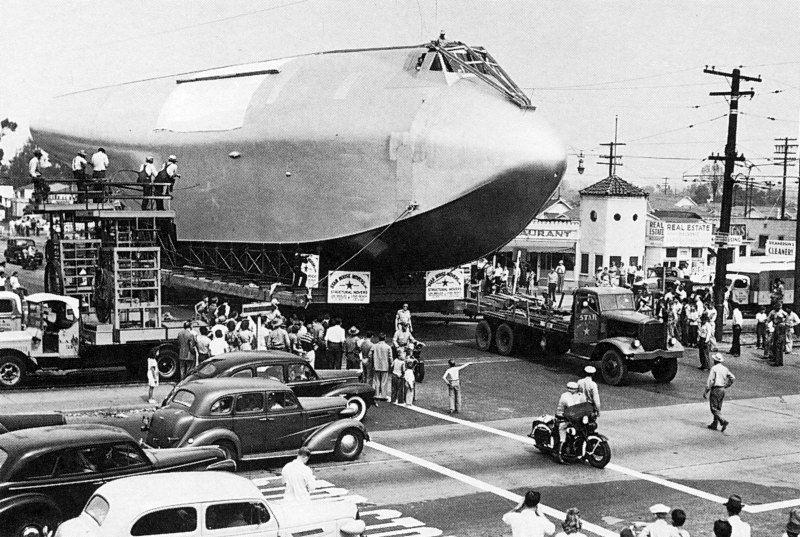 |
|
| (1947)##* – View showing the 'Spruce Goose' being towed through an intersection on its way to the Harbor. Several men are seen standing on a platform rigged-up on the back of a flatbed truck (left) assisting with the overhead lines clearance. |
 |
|
| (1947)++# – The 'Spruce Goose' undergoes final assembly at the docks of Long Beach–Los Angeles Harbor. |
 |
|
| (1947)* - The Hughes Aircraft H-4 Hercules 'Spruce Goose' with Howard Hughes standing on the platform. |
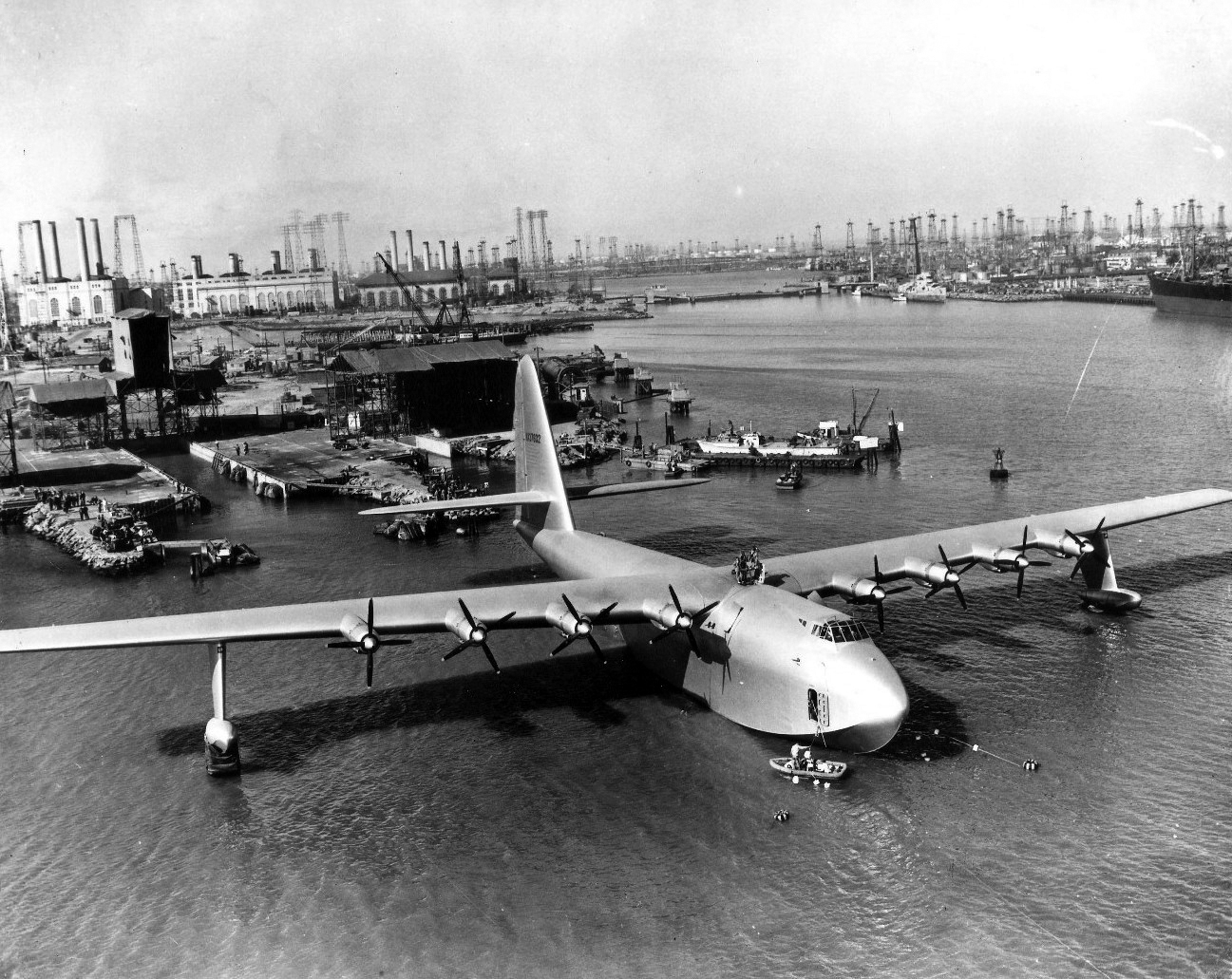 |
|
| (1947)^*# - The Hughes Aircraft H-4 Hercules 'Spruce Goose' is being positioned in the Long Beach-Los Angeles Harbor for its first (and last) taxi tests on November 2, 1947. |
Historical Notes An estimated 15,000 persons jammed beaches and piers along the course to watch the boat’s trials. Hundreds of small boats ranging from fishing craft to row-boats swarmed waters adjacent to the taxing lane. A Coast Guard cutter stood by to warn spectators clear of the plane.** |
 |
|
| (1947)++# – With Howard Hughes at the controls, the 'Spruce Goose' begins its first series of taxi tests. The Long Beach skyline is seen in the background. |
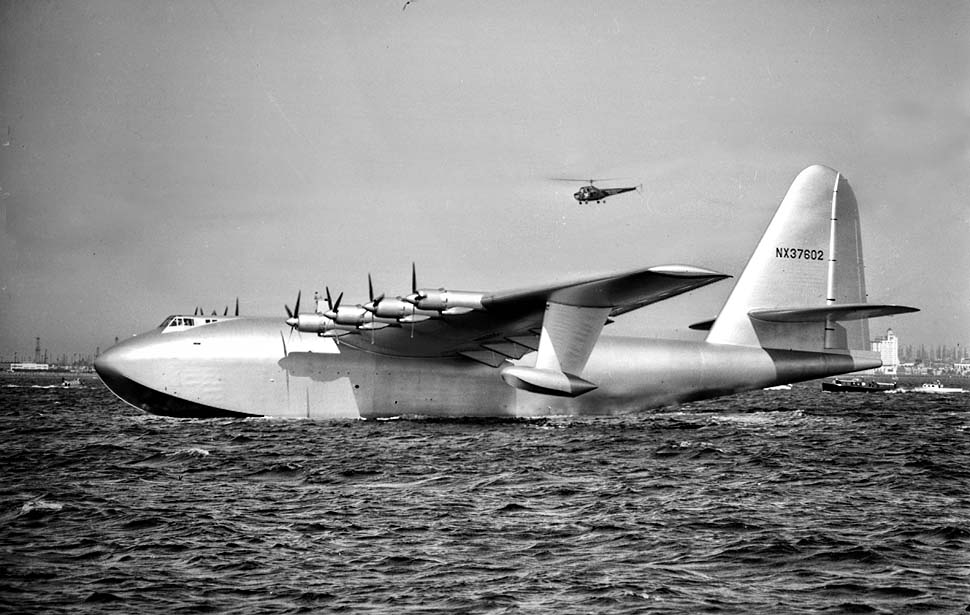 |
|
| (1947)** - The 'Spruce Goose' during taxi tests in the Long Beach-Los Angeles Harbor with Howard Hughes at the controls. |
Historical Notes Hughes piloted the boat on a course roughly paralleling the shoreline from Terminal Island Navy Base to offshore from Pier A in Long Beach. |
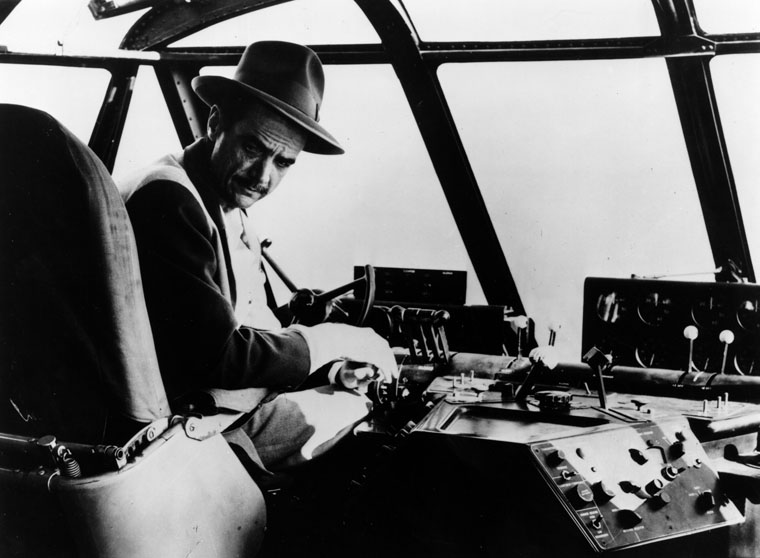 |
|
| (ca. 1947)* - Howard Hughes getting the feel of the cockpit in his famous 'Spruce Goose' seaplane. |
Historical Notes Howard Robard Hughes, Jr. (December 24, 1905 – April 5, 1976) was a business magnate, investor, aviator, aerospace engineer, film maker and philanthropist. He was one of the wealthiest people in the world. As a maverick film producer, Hughes gained prominence in Hollywood from the late 1920s, making big-budget and often controversial films like The Racket (1928), Hell's Angels (1930), Scarface (1932) and The Outlaw (1943). Hughes is also remembered for his eccentric behavior and reclusive lifestyle in later life, caused in part by a worsening obsessive–compulsive disorder and chronic pain. His legacy is maintained through the Howard Hughes Medical Institute.*^ |
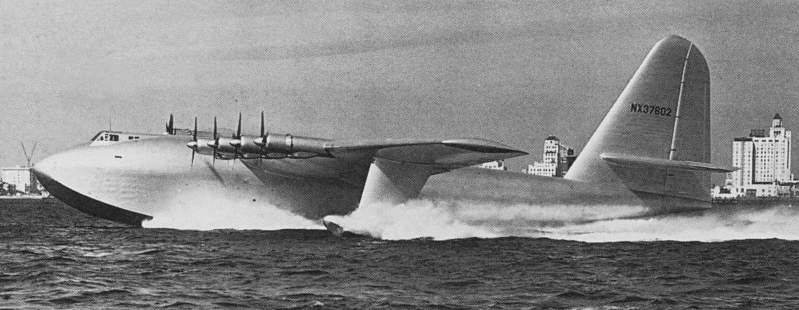 |
|
| (1947)*# - Hughes Hercules ('Spruce Goose') made its first and only flight in 1947 with Howard Hughes himself at the controls, November 2, 1947. |
Historical Notes In addition to the multimillionaire planemaker, 30 engineers, technicians and observers were aboard the plywood giant for its first movement under its own power.** |
.jpg) |
|
| (1947)** - The Hughes Aircraft H-4 Hercules 'Spruce Goose' during short flight in the Long Beach-Los Angeles Harbor. |
Historical Notes The Hercules flew only once for one mile, and 70 feet above the water, with Hughes at the controls.*^ |
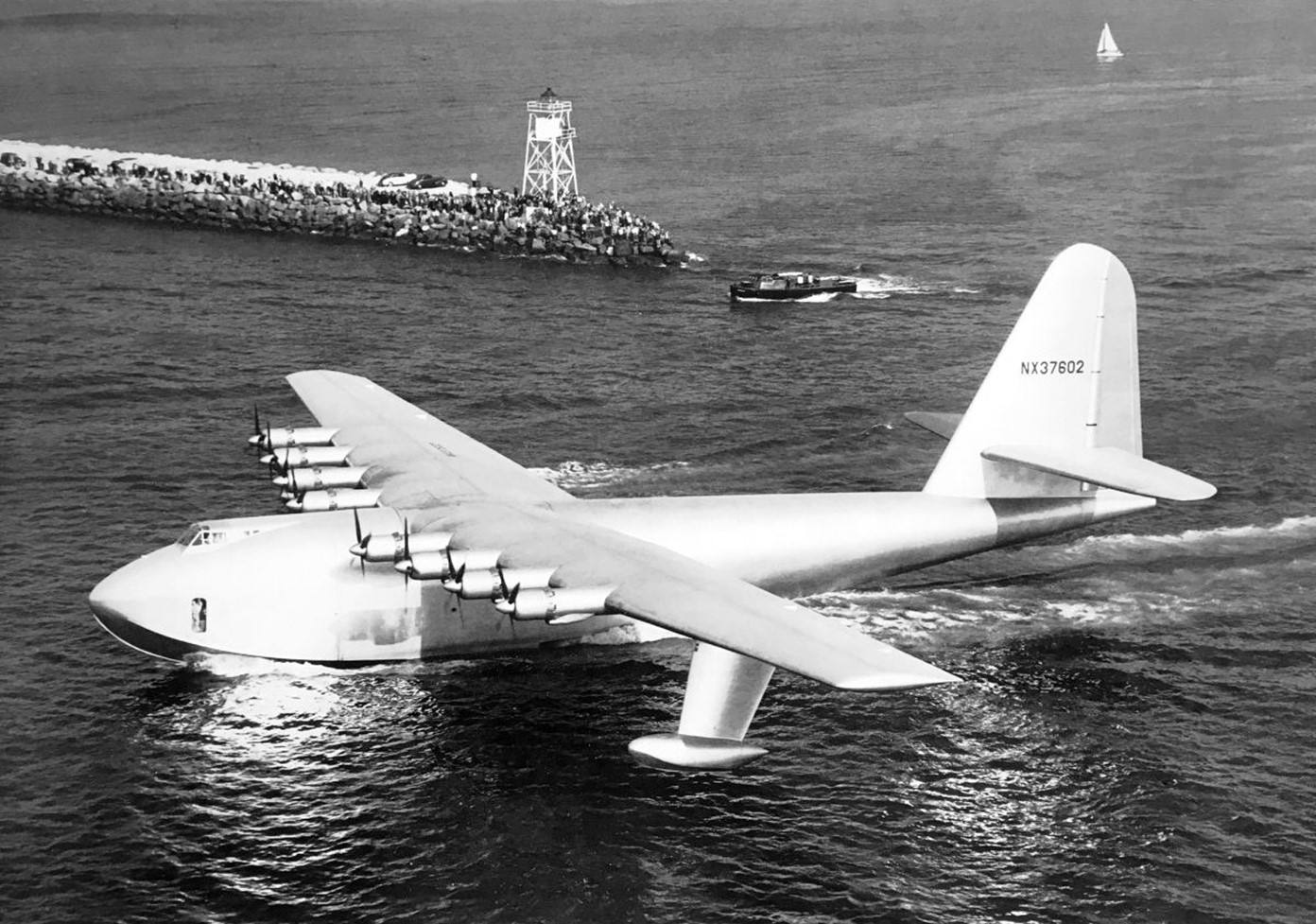 |
|
| (1947)* - The Spruce Goose landing on the water at the Long Beach Harbor. |
 |
|
| (1947)^#^# - Howard Hughes's H-4 Hercules - The 'Spruce Goose' - It flew only once on Nov. 2, 1947. The Hercules is the largest flying boat ever built and has the largest wingspan of any aircraft in history. They really weren't sure it would lift off - but it did. |
Historical Notes The aircraft made its first and only flight on November 2, 1947, and the project never advanced beyond the single example produced. Built from wood because of wartime restrictions on the use of aluminum and concerns about weight, its critics nicknamed it the 'Spruce Goose', despite its being made almost entirely of birch rather than spruce. The Hercules is the largest flying boat ever built and has the largest wingspan of any aircraft in history. It survives in good condition at the Evergreen Aviation Museum in McMinnville, Oregon.*^ |
 |
|
| (1947)^ - Howard Hughes' H-4 Hercules troop transport plane, the "Spruce Goose," Long Beach Harbor. Photo By J. R. Eyerman - The LIFE Picture Collection |
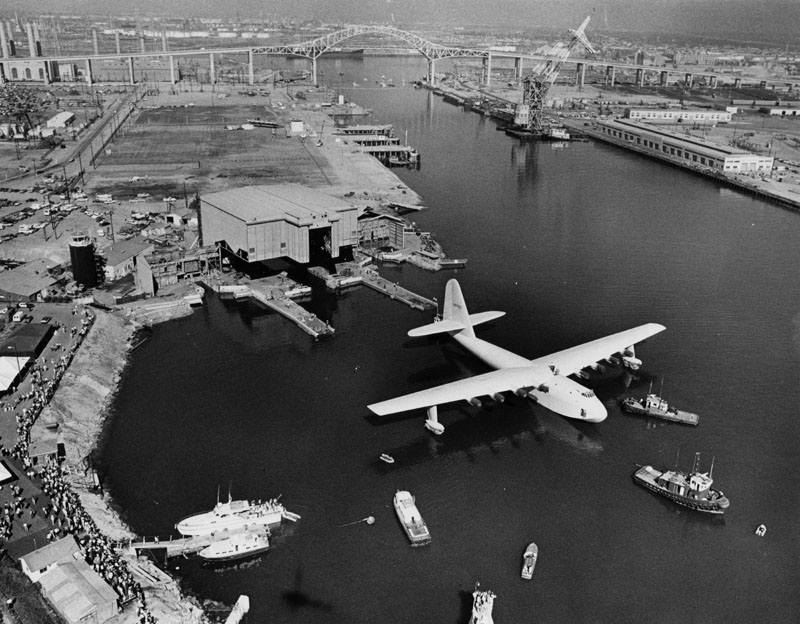 |
|
| (1980)* - Photograph caption dated October 30, 1980 reads, "Tugboats escort Spruce Goose from hangar where it's been housed for 33 years and head for a new berth near Queen Mary." |
Historical Notes In 1980, the Spruce Goose was acquired by the Aero Club of Southern California, which put the aircraft on display in a large dome adjacent to the Queen Mary exhibit in Long Beach.*^ |
 |
|
| (1982)*- Photograph caption dated February 11, 1982 reads, "Spruce Goose, Howard Hughes' 210-foot-long flying machine that flew only once, found a new home yesterday: a vast aluminum exhibition dome next to the Queen Mary's berth in Long Beach. As hundreds watched from the stern of the ocean liner, the $25 million plane was moved into the 130-foot-high dome, ending a 4 1/2-mile barge trip. Designed by Hughes to carry troops during World War II, the Goose flew one mile in 1947 and has been resting ever since. Now she'll star in a Wrather Corp. exhibit simulating her long-avoided flight." |
 |
|
| (1982)* - Photograph caption dated February 15, 1982 reads, "The dome housing the Spruce Goose is the world's largest clear-span aluminum dome, covering 135,000 square feet, with a diameter of 415 feet." |
Historical Notes In 1988, the Walt Disney Company acquired both attractions and the associated real estate. Disney informed the Aero Club of Southern California that it no longer wished to display the Hercules after its highly ambitious Port Disney was scrapped. In 1993, the Aero Club of Southern California sold the Hughes flying boat to Evergreen Aviation Museum. The aircraft was disassembled and transported by barge, train and truck to its current home in McMinnville, Oregon (about 40 miles southwest of Portland), where it was reassembled and is currently on display.*^ |
* * * * * |
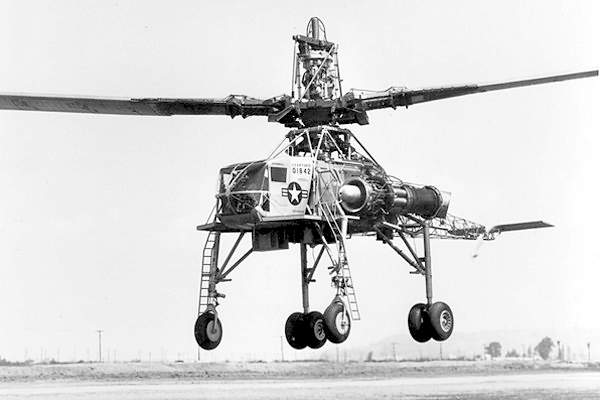 |
|
| (ca. 1952)*# - View of the first helicopter produced by Hughes, the giant XH-17 "Flying Crane", flying above the Culver City runway. |
Historical Notes In 1947, Howard Hughes redirected the Hughes Aircraft Company's efforts from airplanes to helicopters. The effort began in earnest in 1948, when helicopter manufacturer Kellett Autogiro Corporation sold their latest design to Hughes for production. The XH-17 "Sky Crane" first flew in October 1952, but was commercially unsuccessful.*^ |
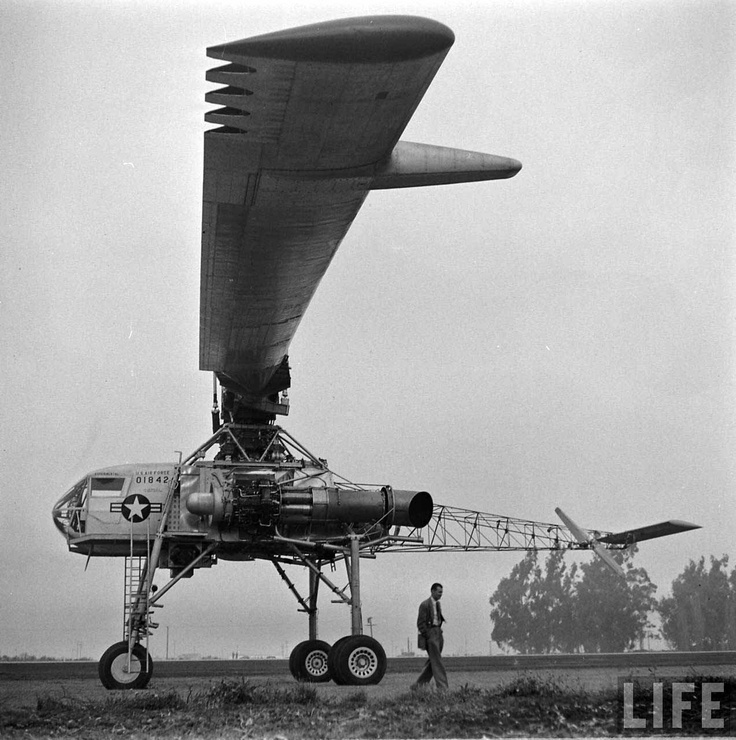 |
|
| (1952)*** - View of Howard Hughes walking away from the Hughes XH-17 “Flying Crane”. |
Historical Notes In 1955 the company began building light helicopters when Howard Hughes split the helicopter production unit from the Hughes Aircraft Co.*^ |
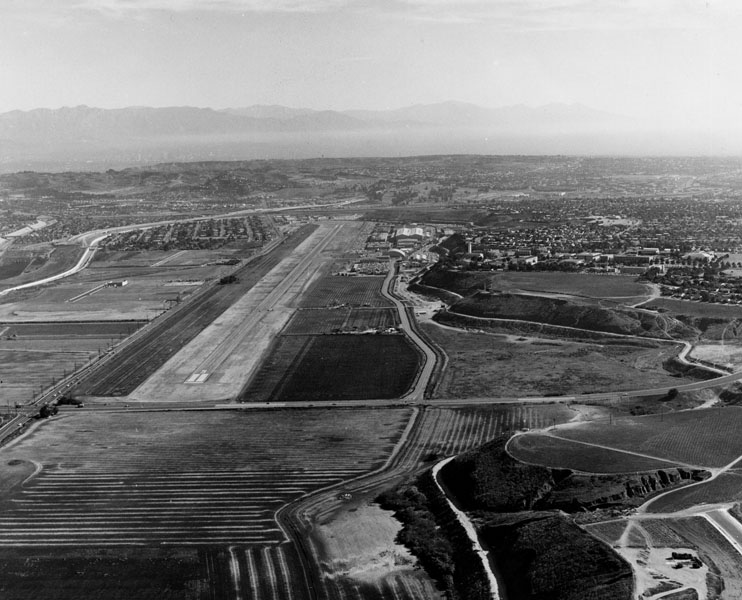 |
|
| (1968)* - Aerial view looking east along the runway of the Hughes Airport. Loyola University and Westchester can be seen on the right. |
Historical Notes In 1943, Hughes built the world’s longest private runway at the Hughes Airport. Runway 5/23 was 9,600' long - nearly 2 miles in length. It was not paved for its first few years, because Hughes believed that paved runways imparted unnecessary stress on an aircraft's landing gear. He reportedly had to add fill regularly to keep the ground solid.*# |
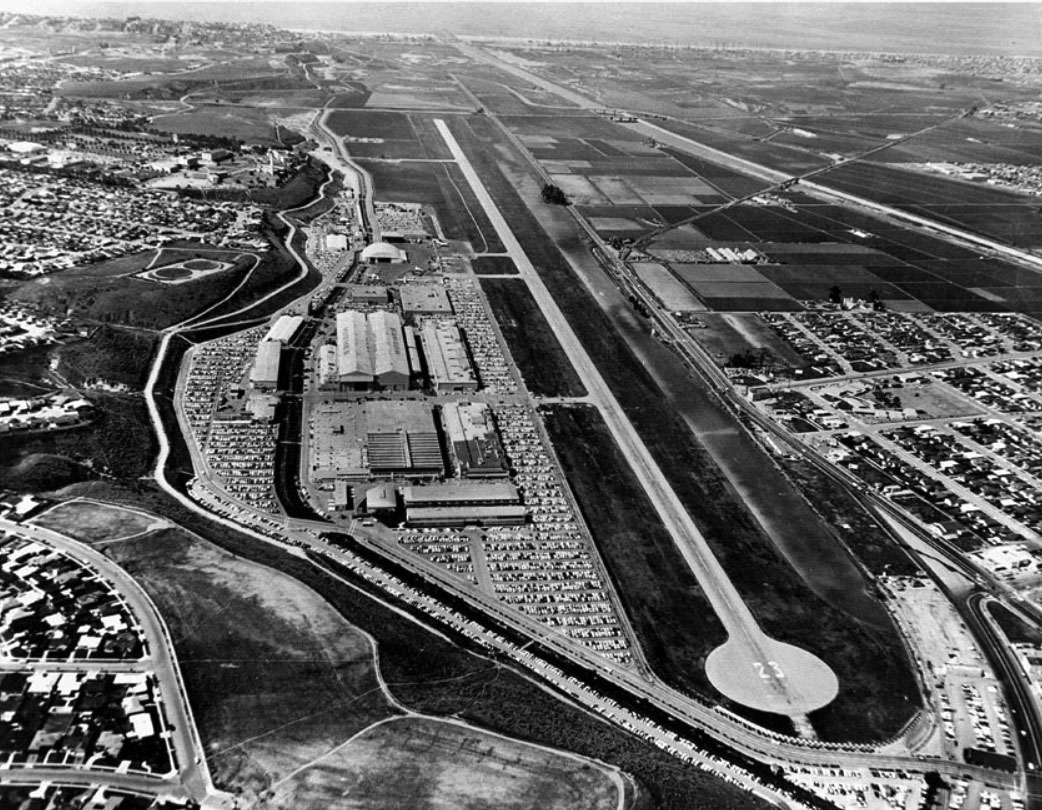 |
|
| (ca. 1960s)**^# – Aerial view showing the Howard Hughes runway and plant site at Playa Vista. |
Historical Notes In 1948 6,800 feet of the runway was paved with asphalt, extended by 1962 to 8,800 feet. Takeoffs to the west had to be coordinated with nearby Los Angeles International Airport. The field served a number of aircraft and helicopter development projects of the Hughes Aircraft Co. and Hughes Tool Company (Summa Corporation).*^ |
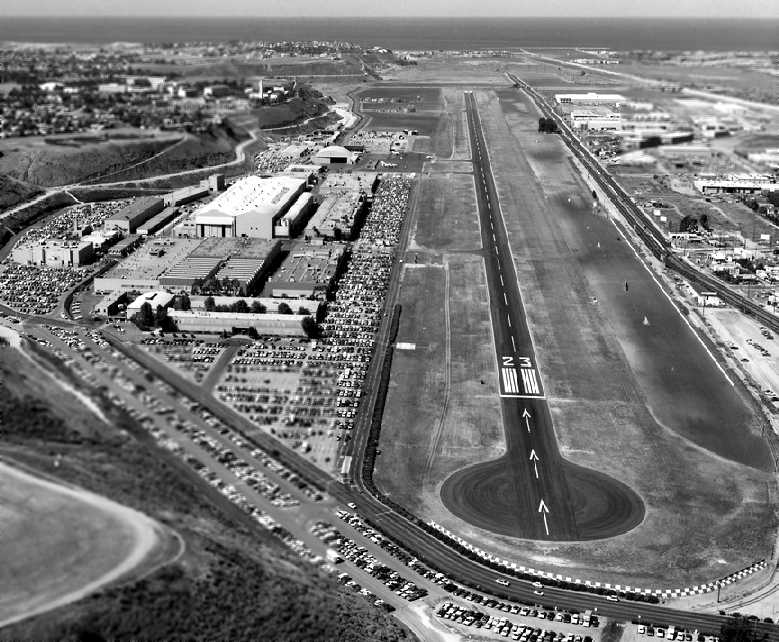 |
|
| (1972)*# - Aerial view looking west at the Hughes Airfield. |
Historical Notes After an often strange & reclusive life, Howard Hughes died in 1976. After the dust of Hughes’ estate had settled, the Culver City property was in the hands of Summa Corporation. Summa proposed a mega-development, with 29,000 people in 13,000 units, and an additional 20,000 employed by an on-site world-class motion picture studio. The project was called "Playa Vista." *# By the mid-1990s, the former Hughes Aircraft hangars here, including the one that held the Hercules, were converted into sound stages. Scenes from movies such as Titanic, What Women Want, and End of Days have been filmed in the 315,000-square-foot aircraft hangar where Hughes created the flying boat. It also features in the computer game Crimson Skies. The hangar will be preserved as a structure eligible for listing on the National Register of Historic Buildings.*^ |
* * * * * |
Please Support Our CauseWater and Power Associates, Inc. is a non-profit, public service organization dedicated to preserving historical records and photos. Your generosity allows us to continue to disseminate knowledge of the rich and diverse multicultural history of the greater Los Angeles area; to serve as a resource of historical information; and to assist in the preservation of the city's historic records.
|
More Historical Early Views
Newest Additions
Early LA Buildings and City Views
History of Water and Electricity in Los Angeles
* * * * * |
References and Credits
* LA Public Library Image Archive
^ Oviatt Library Digital Archives
**Los Angeles Times Photographic Archive: Municipal Airport; Spruce Goose; Alhambra Airport Dedication
^^Aerofiles - US Aviation Firsts
*#Abandoned & Little-Known Airfields – Paul Freeman
#*Huntington Digital Library Archive
***Pinterest: Hughes XH-17 “Flying Crane”; Northrop YB-35
**#UCLA Library Digital Collections
#**Theatlantic.com: Northrop XB-35
#*^This Day in Aviation: Lockheed Vega 1
##^The Chronological, Pictorial History of Early Pusher and Pusher-Puller Aircraft by Terrence Murphy
**^KCET.org: From Mines Field to LAX: The Early History of L.A. International Airport: Welcome to L.A. River
*^^California State Military Museum - Mines Field; Lockheed Air Terminal
^**Dmairfield.com: Mines Field
^*#Noirish Los Angeles - forum.skyscraperpage.com; Bob's Airmail Service Station; Alhambra Airport; Spruce Goose; ; 1932 Downtown Aerial; Spruce Goose Hangar
*#*San Diego Air & Space Museum Archive
^#*theautry.org - From the Ground Up: The Infrastructure of Flight in Southern California
^^^Airliners.net: The Wings of the Net: 1929 Fokker
^^#LA Times: Arcadia Balloon School and Ross Field
^^*Los Angeles World Airpots: LAX
*#^LA World Airports - History of Van Nuys Airport
^#^FriendsReunited.co.uk: Northrop YB-49 Bomber
*^*Seaplanes of the Magic Isle
^*^ Nuestra Señora la Reina de los Ángeles: losangelespast.com
^v^ SMO's History - Santa Monica Airport Association
^## Facebook.com: Photos of Time Travelers
+## Airport Journals: Grand Central Aiport
#+#Facebook.com: Photos of Los Angeles
##+ EdCoatesCollection.com: Sikorsky S-38
**^*California State Library Image Archive
***^Pomona Public Library Digital Archive: Bob's Airmail Service Station
^**^California State Library Image Archive
****Pasadena Museum of History
^^^^Pinterest/Santa Monica Past: Douglas Aircraft
^***Earlyaviators.com: Roy Knabenshue
*^*^Pinterest: Appreciation of History - Reddit.com
^*^*San Fernando Valley Relics - Facebook.com: Burbank Airport; Angeles Mesa Drive Airport (Burbank Airport)
^#^#Pinterest.com - Vintage L.A.: Spruce Goose
*^*#Santa Monica Municipal Airport
^*^^South Bay Daily Breeze: Seaplanes to Catalina
^*^#Facebook.com - Bizarre Los Angeles
**##Alhambra Airport
*^##Facebook.com: Classic Hollywood-Los Angeles-SFV
^##^Pasadena PIO: Bob Hope Airport
*#^#Flickr.com: Walking Over Santa Monica
*#*#Los Angeles Then and Now: Douglas' Dream Took Wing in Santa Monica
#^**Facebook.com: West San Fernando Valley Then And Now
#^^*Facebook.com: Van Nuys Airport
#^^^Calisphere Digital Archive
*^ Wikipedia: Los Angeles International Airport; 1910 L.A. International Air Meet at Dominguez Hills; Bob Hope Airport; Grand Central Airport; Airship; Zeppelin; Theme Building; William Wrigley, Jr.; Spirit of St. Louis; Lockheed Hudson; Douglas DC-3; Amelia Earhart; Hughes Airport; Hughes H-4 Hercules; Howard Hughes; Hughes Helicopters; Northrop YB-35; Jack Northrop; Norhtrop YB-49; History of Santa Monica; Boeing 247; Hughes H-1 Racer; Charles Lindbergh; L-1011 Tristar; Van Nuys Airport; Douglas Aircraft Company; DC-9; Hughes Airport; Lockheed SR-71 Blackbird
< Back
Menu
- Home
- Mission
- Museum
- Major Efforts
- Recent Newsletters
- Historical Op Ed Pieces
- Board Officers and Directors
- Mulholland/McCarthy Service Awards
- Positions on Owens Valley and the City of Los Angeles Issues
- Legislative Positions on
Water Issues
- Legislative Positions on
Energy Issues
- Membership
- Contact Us
- Search Index